 |
Old KOS Bird Reports and Latest News Archive.
Back to Knutsford Ornithological Society Homepage
Joining the KOS
KOS programme - 2023 / 2024
If you'd like to receive an email when this website is updated - click here
Enter the 2023 Sand Martin Competition - click here
December 29th 2023 ..... The Christmas Walk.
 |
Well, the strangely-named Storm Gerrit came and went overnight, taking with it some house roofs in Stalybridge as it morphed into a T5 tornado during the early hours of Thursday (28th). Fortunately things had calmed down by 9:30am when a hardy group of 13 KOS members gathered in the Witton Mill car park ready for our annual Christmas walk around Neumann's Flash and Marbury Mere.
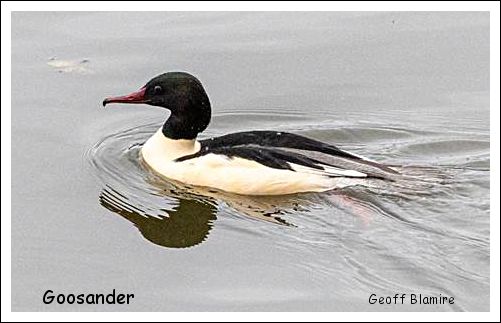 Sheila Blamire was our trip leader for the day; she and Geoff had done a recce the previous day, so this year we began by taking the path between Ashton's and Neumann's flashes towards Pod's Hide. Ashton's was very quiet but an overflying Curlew was a useful addition to the day list that we'd started in the car park, where eight species were using the bird table including Jay and Bullfinch.
Sheila Blamire was our trip leader for the day; she and Geoff had done a recce the previous day, so this year we began by taking the path between Ashton's and Neumann's flashes towards Pod's Hide. Ashton's was very quiet but an overflying Curlew was a useful addition to the day list that we'd started in the car park, where eight species were using the bird table including Jay and Bullfinch.A decent selection of wildfowl from Pod's Hide, including Shelduck, Wigeon, Tufted Duck and Shoveler sharing the flash with Black-headed, Herring, Lesser and Great Black-backed Gulls. In the distance, out of earshot, a substantial flock of Pink-footed Geese headed south.
What had been a dry morning became a lot wetter as we passed through Big Wood and down to the shores of Budworth Mere, so we didn't hang about but made quick progress to the welcome shelter of the covered viewing screen.
Up to 19 Goosanders have been counted recently on the mere, there seemed to be fewer on Thursday but those that were present gave great views as they fished just below the screen where we sat enjoying elevenses. Pride of place though must go to three Kingfishers that provided an ever-changing kaleidoscope of cobalt blue as they perched right in front of their audience fishing and taking short flights out towards the centre of the mere before returning. Two's company and three's a crowd - I think Spring was in the air!
The rain held off as we walked back to the cars, there were no new species, except for a Cetti's Warbler's quick burst of song as we passed over Butterfinch bridge on Marbury Lane bringing the total count to 44 species during a walk of 7.25Km (4.6miles)
Bob Groom rounded of his monthly wildfowl counts on Tabley Mere on Sunday 17th December ......"An ideal morning for my WEBS count at Tabley Mere, lovely and mild - Min 9C Max 11C - if a bit breezy. Buzzards constantly circling and 'talking' to each other. Male Great Spotted, Goldcrest with the Long-Tailed Tits, Sparrowhawk, Redwings in the wood. Water Rail (heard), Little Egret, 2 Herons, 5 Cormorants. The most noticeable thing was the absence of Coots. A few months ago there were hundreds; barely double figures today. In contrast 12 was a good count for Great Crested Grebes there (many more at Rostherne and Budworth meres, of course). 27 Greylags (but again no Canadas) ,4 Wigeon, 2 Goldeneyes, 36 Mallards, 20 Tufted Ducks, just 2 Mute Swans. Not at all bad underfoot but very slow progress."........
So there we are, Bob's final count of the year and my last "Latest News" update of 2023 - 46,000 words this year! I can recall my favourite trips and indoor lectures but, of course, everyone will have their own favourites - let's hope that 2024, our society's 50th anniversary year, will provide just as many, if not more, for all. Happy new year!
Species recorded on the Christmas walk around Neumann's Flash and Budworth mere. 28th December 2023. |
. December 17th 2023...... The Christmas Party!
  |
Arriving at the Jubilee Hall on Friday evening with the baked potatoes Len and I were delighted to find that during the afternoon Jude, Karina and her husband, David had been hard at work decorating the hall and setting out the tables in preparation for the annual KOS Christmas party!
Gradually more people arrived with their offerings - all the usual favourites - Goostrey's pork
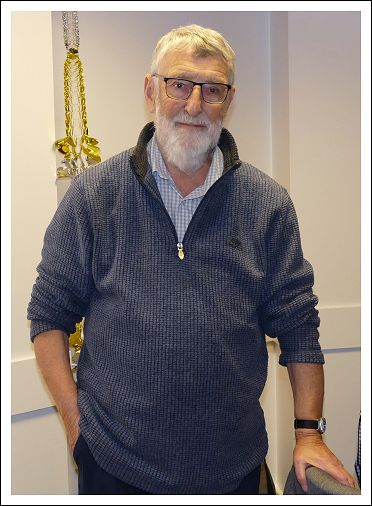 pies, specially flown in from Mobberley, sausages, cooked meats etc. and a table full of puddings, ready to challenge the self-discipline of those who should really be watching their glucose intake!
pies, specially flown in from Mobberley, sausages, cooked meats etc. and a table full of puddings, ready to challenge the self-discipline of those who should really be watching their glucose intake!The annual quiz proceeded in the traditional manner, I stuck the pictures up around the hall and people could then peruse them at their leisure during and after the meal. This year it was a close run contest and three people ended up with 41 out of the possible 50 points; Bob, Sheila and Hugh - the three pre-race favourites! So a tie-break was called for and each of the three were given the same picture, positioned face down on a table and on the word "go" they were turned over to reveal the tie-breaker. This year's bird was a White's Thrush, Sheila took the honours and won a large box of sweets that of course were then shared around the room - it's the taking part that counts!
My proof and sensitivity reader (those that need to know, know!) has insisted that I put this picture, kindly taken by Jude Halman, on this update, as I normally never appear due to me always taking the people images myself. So it should appear on the right.
For various reasons numbers were down for this year's party but nevertheless it was a most enjoyable evening and our thanks go to Karina, David and Jude for preparing the room, for those that provided the food and/or brought along articles for the raffle or bring and buy. Great value at £8 and I'm sure we have made some money to pay for the ever increasing cost of speakers for our indoor lectures.
Meanwhile, back at the coalface, Bob Groom and I were in the Rostherne observatory on Monday morning (11/12)
......."Just 8°C this morning when Bob and I arrived at the observatory. The overnight rain continued and it was a gloomy outlook, with a thick mist making it impossible to see the far side of the mere.
After half an hour or so the rain slowly began to clear and the sun appeared giving rise to a rainbow that reached right down to the surface of the mere.
The rain had cleared the atmosphere and as the sun became brighter viewing conditions were excellent. 31 teal were very active over towards Gale Bog, also there c.16 Pochard, a single male Goosander and 3 drake Mandarin. Four Goldeneye and possibly more were scattered across the mere, whilst on their floating island 2 Green Sandpipers had returned after a couple of weeks absence.
The bird table was busier than recently with Blue, Great, Coal and Long-tailed Tits recorded as well as 2 Bullfinches and a Goldfinch. A big female Sparrowhawk caused panic as it shot through in-between the obs and the bird table!
Phil Dell had been down to the Bittern Hide and heard at least two Cetti's Warblers. He also obtained some excellent video of one of two Water Rails in front of the hide.
Bill Bellamy had done a count yesterday and recorded 39 Mandarin and 109 Wigeon, we could see there were plenty of the latter about but they were well hidden in the mereside vegetation."............
The following morning (13/12 Geoff and Sheila were out and about on their daily perambulation
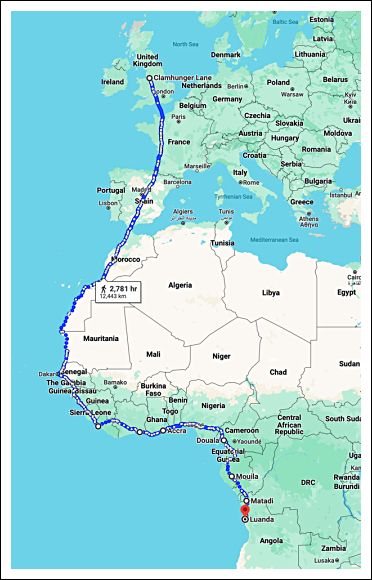 ........" We did our 12km Plumley, Holford, and Lostock Green this morning. It was disappointing with only 1 Curlew in one of the fields next to Inovyn offices and 4+ in the maize stubble field behind Ridgeway Farm, but the sunflower field made up for it: 50-100 finches (very difficult to count!) mostly Chaffinches, Greenfinches, Goldfinches and a few Bramblings. Could be more species but the light was atrocious. Need someone else to put more time there…
........" We did our 12km Plumley, Holford, and Lostock Green this morning. It was disappointing with only 1 Curlew in one of the fields next to Inovyn offices and 4+ in the maize stubble field behind Ridgeway Farm, but the sunflower field made up for it: 50-100 finches (very difficult to count!) mostly Chaffinches, Greenfinches, Goldfinches and a few Bramblings. Could be more species but the light was atrocious. Need someone else to put more time there…Yesterday in Martin’s Field, Rostherne 3 Egyptian Geese and 50+ winter thrushes – mostly Fieldfare. Ciceley Mill Pool: pair Mute Swans, 4 Gadwall and Cormorant. Female Goosander still on Little Mere along with 4 Cormorants and the usual wildfowl. ".........
Geoff has been keeping a record of their walks, that began during the first covid lockdown and the stats. are very impressive - 12,459km or 7,787miles in 1304 days (9.55km or 5.97mls per day). The map shows the distances involved!
Tatton's a bit under-watched at the moment but Bob's a regular visitor. This from Tuesday (12/12) ......." A decent enough day - Min 7C Max 10C - but the park was almost deserted. The Stonechats (2m 1f) were down by Tatton Mere. A f Great Spotted called frequently as it foraged in the trees and a Mistle Thrush sang strongly, just as if it were spring. A lady who asked advice about some small birds she had just seen (probably Goldfinches but a Kestrel scattered them before I got close enough) had watched a green woodpecker flying through. There were at least half-a-dozen Pochard [or 'pokkard' as T.Hedley Bell would have it] but surprisingly few ducks overall. Usual Heron and 2 Cormorants at Melchett Mere.".........
Darren Morris has kindly sent me a copy of the park's Winter news letter - you can read it here - Thanks Darren.
Just a few more days now until the Winter solstice after which the days slowly become longer and we can anticipate the arrival of Spring!
So here are a few dates for your diaries -
On Thursday 28th December it's our Christmas Walk around Neumann's Flash and Budworth Mere, meeting at 09:30am at the Witton Mill Bridge car park. Sheila will be leading this trip and you may want to let her know if you intend to come along - sheila@onlybirding.com
Our first field trip of 2024, which of course is the 50th anniversary year of the founding of the KOS, is to Mere Sands Wood and Lunt Meadows. This will take place on Saturday 13th January 2024 (more details later).
It's the RSPB's Big Garden Birdwatch with the Friends of the Moor, Knutsford on Saturday 27th January. 11:00am until noon. Meeting at the pavilion on Knutsford Moor.
The following day we repeat the exercise with the Friends of the Heath. Again it's 11:00am until noon. Meeting at the information notice board on the west side of the Heath, close to Northwich Road.
** Late news just in from treasurer Frank Dearden**
Thank you for your support in raising £261 for the Society on Friday last. The breakdown was as follows:
Admission £144
Raffle £58
Bring and buy £29
Donation £30
A very useful contribution which will pay for two of our speakers.
Frank
December 6th 2023........ The trip to Marshside and Martin Mere.
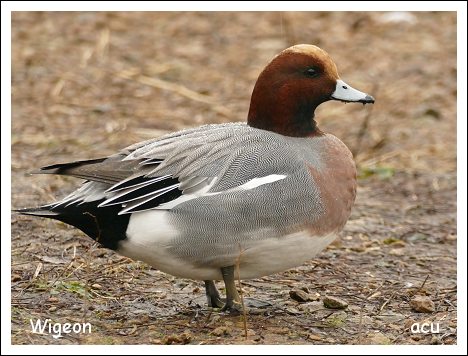 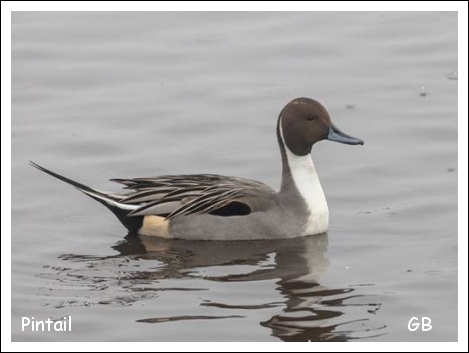 |
Only 1⁰C , but there was some birding to be done and the day began well as, before we left the car park, Bob Groom found us a Peregrine being mobbed by a selection of corvids out towards the sea. A second raptor quickly followed, with a Sparrowhawk looking for breakfast over the Sandgrounder's hide. It felt even colder once the windows in the hide had been opened revealing a tundra-like vista with just patches of open water, being kept ice-free by the movement of the wildfowl - Mute Swans, Mallard, Teal, Shoveler and a few gulls. We didn't linger too long.
Across the other
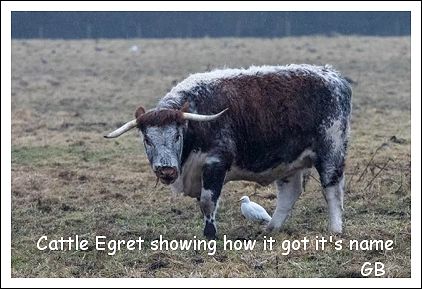 side of the busy road we added Marsh Harrier, Great and Little Egrets to the day list before moving on to the newly re-built Nell's Hide. More water here and new birds included Pintail, Gadwall, Wigeon, Coot, Moorhen and Greylag Goose. Bob had taken a different route and was able to announce ring-tailed Hen Harrier and Stonechat seen from the corner screen.
side of the busy road we added Marsh Harrier, Great and Little Egrets to the day list before moving on to the newly re-built Nell's Hide. More water here and new birds included Pintail, Gadwall, Wigeon, Coot, Moorhen and Greylag Goose. Bob had taken a different route and was able to announce ring-tailed Hen Harrier and Stonechat seen from the corner screen.On then to Martin Mere; except for Colin and Don who chose to join us later after going in search of a Red-breasted Goose that had been spotted during the week. After a long walk they caught up with the bird and they now have the tricky problem of deciding whether or not it was a genuine wild bird or an escapee from someone's wildfowl collection - I always find with "listers" that if it's not on their list already then it's definitely wild, otherwise it's just an escaped bird!
The car park was full at Martin Mere and the reception building, shop and restaurant were very busy; groups of kids and their parents were again being ferried by Santa's elves across to an island to meet the great man himself. No life jackets and this year the elves were having to push back encroaching sheets of ice as they made their way slowly across the lake!
After
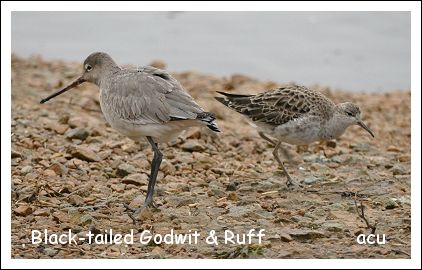 lunch in the restaurant we went onto the reserve proper, making our way first to the Ron Barker hide; along the way, close to the feeders, Goldfinch, Greenfinch, Chaffinch were added to the list and Blackbird, Fieldfare and Redwings were also welcome additions.
lunch in the restaurant we went onto the reserve proper, making our way first to the Ron Barker hide; along the way, close to the feeders, Goldfinch, Greenfinch, Chaffinch were added to the list and Blackbird, Fieldfare and Redwings were also welcome additions.A couple of Marsh Harriers floated over the reedbeds in front of the hide and incoming Whooper Swans were a reminder that feeding time was rapidly approaching. Frank takes the role of trip leader very seriously, so much so that, earlier in the week, he'd driven up to do a recce! He'd walked past the United Utilities hide to a newly opened part of the reserve and found a group of 12 Cattle Egrets amongst the English Longhorn cattle, they were still there on Sunday!
Waiting in the Discovery hide for feeding time we had the usual excellent views of wintering Ruff, joined this year by a Black-tailed Godwit and a Redshank whilst out on the water Whooper Swans, Pochard and a single male Goldeneye. As I added the latter to my list on the dictaphone (much easier than writing the list in a notebook) I was overheard by one of the locals who became mildly excited. Apparently it's a rare sighting at Martin Mere, he'd never seen one there before despite numerous visits over the years. It promptly went out on their local WhatsApp group! We ended up with 62 species, 5 less than last time we did this trip, which was in 2021. Considering the weather, a commendable effort.
The following morning we had the sad task of saying a last farewell to John Somerville at the Altrincham Crematorium. Barbara is still recovering from a broken hip and was worried about having to use a wheelchair, but I'm pleased to report that she managed the ceremony unaided. The minister read the eulogy and Frank read out a short tribute from all his many friends in the KOS. It's been suggested that this tribute be published on the website, you can read it here.
Species recorded at Marshside and martin Mere- Sunday 3rd December 2023 |
In May 2021 Jayne Davies found a female Goosander with 9 chicks on the Birkin Brook where it flows through the Tatton deer park and since then the number of birds seen on local waters during the Winter months has increased significantly. In the early days of the KOS we used to have a trip down to the Shropshire meres specifically for a glimpse of the species.
Malcolm Calvert remembers those days too .........."Back in the 1960s one had to travel to Hanmer Mere, a detached part of Flintshire bordering Shropshire, for a winter sighting of Goosander but over recent years cleaner rivers, including the Mersey, have attracting these attractive sawbills. A currently favoured locality, not an obvious one, is the series of three reservoirs which served the erstwhile Sykes Bleaching Company at Edgeley, almost adjacent to ‘Fort Edgeley’, aka Edgeley Park. Having secured my favourite parking place, I trek around the pools prior to entry into the hallowed stadium. In January I was surprised to find a dozen Goosander amongst the feral Canada Geese and Coot and was pleased to confirm their recent return. On 4 November 4 drakes and 7 ducks were in attendance and on the 18th the ‘score’ was 10 drakes and 7 ducks. The pools must be, or were, well stocked judging by the regular divings of these huge waterbirds. "..............
Goosanders are to be found on most of our visits to Rostherne Mere and are also to be found on smaller stretches of water, as Geoff and Sheila found on the 17th of this month ..........""Yesterday we had 3m 4f Goosanders at Rostherne Mere and 1f Goosander at Little Mere – probably the first time on this site!........... (coincidentally, today [30/11] Phil Dell had nine Goosanders on Rostherne Mere and Sheelagh Halsey no less than 22 on Redesmere!)
The current spell of unusually cold weather began last weekend but it didn't deter our dynamic duo and they were out and about on Sunday morning (26/11) and also had a nice sighting on their return home!
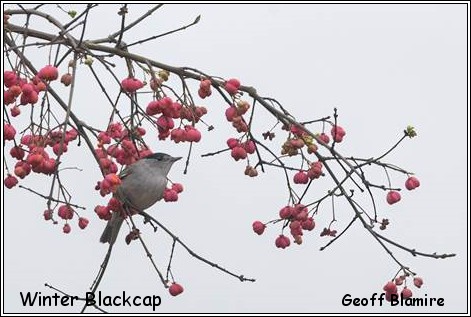 ........."We did our Plumley/Holford/Lostock Green 11km walk this morning, this time we parked near Keeper’s Cottage rather than in Plumley – we thought it might be not bad under foot – wrong! We set off and immediately heard Curlew(s) but couldn't see any. Further along in the set-aside were c50 Meadow Pipits (couldn't see any other species with them). By the railway crossing small flock of Goldfinches were feeding seed heads. Along the Holford track 37 Curlews flew overhead but they landed out of sight – no sign of them in any of the fields around Inovyn offices or in the maize stubble fields along Moss lane. In the sunflower field c30 Chaffinches, then further along another flock of c40 finches including Chaffinches and Greenfinches and a few Redwings. Patmoss Lane 29+ Curlews in a grass field – could be more because some were in a ditch. Turning into Cheadle Lane came across several other flocks – must have been a total of 60+! Good, but cold morning."
........."We did our Plumley/Holford/Lostock Green 11km walk this morning, this time we parked near Keeper’s Cottage rather than in Plumley – we thought it might be not bad under foot – wrong! We set off and immediately heard Curlew(s) but couldn't see any. Further along in the set-aside were c50 Meadow Pipits (couldn't see any other species with them). By the railway crossing small flock of Goldfinches were feeding seed heads. Along the Holford track 37 Curlews flew overhead but they landed out of sight – no sign of them in any of the fields around Inovyn offices or in the maize stubble fields along Moss lane. In the sunflower field c30 Chaffinches, then further along another flock of c40 finches including Chaffinches and Greenfinches and a few Redwings. Patmoss Lane 29+ Curlews in a grass field – could be more because some were in a ditch. Turning into Cheadle Lane came across several other flocks – must have been a total of 60+! Good, but cold morning."When I was making our late lunch and glanced out of the kitchen window – male Blackcap was feeding in the Spindle Tree! The berries are poisonous to humans, but are an excellent source of food for birds in winter. It remained for 5 minutes gorging itself:...........
I too took advantage of the sunny weather on Sunday morning with a Winter walk to Mobberley's Gleavehouse Pool ........."Following 2 nights with sub-zero temperatures I took the car for a run to warm it up before going to Gleavehouse Pool. I passed Darren sweating his way along Town Lane, before parking at the bottom of Gleavehouse lane.
A large number of corvids on the wet fields, mostly Rooks from the Shaw Heath rookery. Plenty of
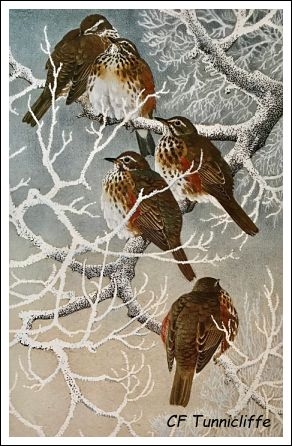 Redwings, Fieldfares and Blackbirds feeding on the hawthorn berries. A single Skylark called as it passed overhead, just before I heard distant pinkfeet (these hearing aids are brilliant!) There were 54 heading north-west towards Rostherne.
Redwings, Fieldfares and Blackbirds feeding on the hawthorn berries. A single Skylark called as it passed overhead, just before I heard distant pinkfeet (these hearing aids are brilliant!) There were 54 heading north-west towards Rostherne.The track towards Gleavehouse Pool is muddy in places but I've seen it worse. A lot worse. A Goldcrest, Wren and Dunnocks along the hedge approaching the pool. Single LBB and Herring Gulls left as I approached, leaving c.30 Black-headed Gulls. Song Thrush and Grey Wagtails were added to the list that ended up at 31.
A big area of Maize has been left standing (probably too wet for the machinery) and was populated by about 30 Chaffinches. It should be a good source of food later in the winter. A single Buzzard on the return leg."............
On Monday (27/11) Wendy Stratford walked to the pool, in search of her first Redwings of the season ........"Walked to the pool at 8.30 this morning- just back. Saw Redwings as hoped - several small flocks (largest 13) some with blackbirds but no Fieldfares. Very happy! The pool was almost completely frozen, just a small patch of water for half a dozen Black-headed Gulls. As I walked back a Kestrel flew over.
I was amused that you thought the remaining stand of corn behind the obs (ice covered today!) was due to tractor not being able to get at it, while I thought it was bird-friendly farming! Sure you're right…
In GH Lane the boarding of the end of the swallow barn is completed, but it looks like some small holes have been left at the apex - hopefully deliberately! "...........
Last Friday's indoor meeting with Gary Prescott AKA "The birding biker" went very well. An excellent turnout of members and guests were treated to a memorable evening, as Gary recounted his hair-raising adventures in the jungles of Peru - rather him than me!
Our next get together is this coming Sunday (3/12) when we'll be visiting Marshside and Martin's Mere. 10am in the car park at Marshside - leader Frank Dearden. Wrap up well - it's going to be a cold one!
November 19th 2023.......The trip to Leighton Moss.
 |
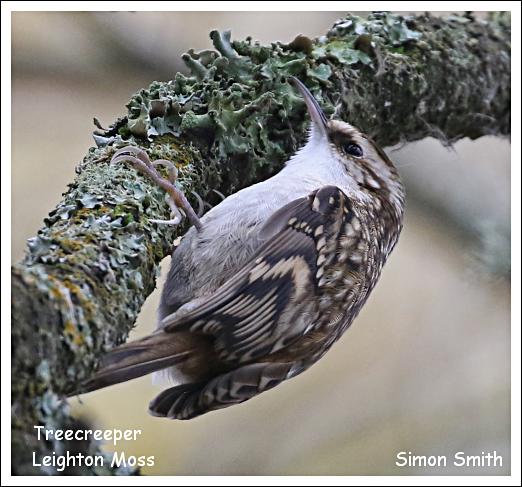 By getting there early(ish) we hoped to secure a glimpse of the reserve's Bearded Reedlings as they took on grit from the supplied "grit trays". The grit is an essential part of their diet, enabling them to digest the seeds that form the greater part of their winter diet. As we walked along the boardwalk toward the causeway, where the grit trays are conveniently positioned, a fellow birder walking towards us reported no sightings, and he'd been there since 7:30am. A disappointment but there was plenty to see from the comfort of the causeway hide - Wigeon, Marsh Harrier, Shoveler, Little Grebe, Gadwall and a raft of noisy Coots. A well-camouflaged Common Snipe crouched a few yards from the hide, a Jack Snipe had been reported but we saw no sign of that particular bird; in the distance a family party of Otters were enjoying themselves - excellent views for a couple of kids and their parents, perhaps seeing Otters in the wild for the first time, rather than on their TV screen.
By getting there early(ish) we hoped to secure a glimpse of the reserve's Bearded Reedlings as they took on grit from the supplied "grit trays". The grit is an essential part of their diet, enabling them to digest the seeds that form the greater part of their winter diet. As we walked along the boardwalk toward the causeway, where the grit trays are conveniently positioned, a fellow birder walking towards us reported no sightings, and he'd been there since 7:30am. A disappointment but there was plenty to see from the comfort of the causeway hide - Wigeon, Marsh Harrier, Shoveler, Little Grebe, Gadwall and a raft of noisy Coots. A well-camouflaged Common Snipe crouched a few yards from the hide, a Jack Snipe had been reported but we saw no sign of that particular bird; in the distance a family party of Otters were enjoying themselves - excellent views for a couple of kids and their parents, perhaps seeing Otters in the wild for the first time, rather than on their TV screen.Moving back towards the visitor centre, we stopped off at the feeding station a short distance away. This is the place for the increasingly rare Marsh Tit and we weren't disappointed with frequent visits from a couple of birds plus Blue,Great and Coal Tits, Nuthatch, Goldfinch and Chaffinch - a Sparrowhawk shot through scattering everything!
Moving on towards the lower hides some brave souls climbed up to the top of the sky tower, despite a cold northerly wind (the temperature reached a maximum of only 8⁰C during the day) and from there they recorded Great White Egret, Pintail, Pink footed Goose and a flock of Siskins.
We chose to go first to the Jackson Hide and on the way encountered a very confiding Treecreeper that was working its way up the branches of a lichen covered bush in the normal manner before it suddenly froze, remaining motionless for a good 60". Quite remarkable I've never seen behaviour like that before; perhaps it had become aware of a predator or something. Anyway it gave Simon a good opportunity to capture the image you see on the left.
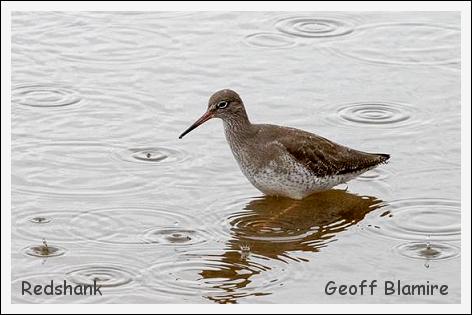
Other folk had made their way to the Griesdale Hide and they too had a bit of luck as the ever alert Izzy Butterworth found them a Bearded Reedling, picking up grit from a grit tray positioned a few yards from the path that the boys she was with had wandered past seconds before, probably talking about football or something! Derek was well pleased......."I have been going to Leighton Moss for the best part of 40 years and that is the first time I have seen a Bearded Tit there, so it was a red letter day thanks to Izzy."......
Lunchtime butties were taken at various points with most people ending up in the cafe for further nourishment or a warm drink before we headed back to the car park and then onto the coastal hides.
The track down to the car park tested the vehicles' suspension systems but I think everyone made it without loosing their exhausts! From the Eric Morcambe hide a good number of new species were added to the day's tick list, including Little Egret, Goosander and Greenshank before the rain started and brought proceedings to an end. The usual good company and some excellent birds!
Ken Davies and I spent some time in the Rostherne observatory the following morning (13/11), out of the gale force south-westerly but it was still chilly and only 8⁰C inside the building. One of the Green Sandpipers was still there on it's floating island - 5 Goldeneye, 26 Pochard, 1m Goosander and that was about it but Ken had brought along some nice pork bakes from Morrisons which made the journey worthwhile!
Geoff and Sheila found much the same on Tuesday (14/11)......" Similar species this morning from the Obs. plus 25 Pinkfeet flying over, 3 Egyptian Geese (Martin's Field), 1f Goosander, but no Green Sandpiper.
Ciceley Mill Pool: 2 Mute Swans, 1 Little Grebe, 2 Gadwalls, etc, plus Goldcrest nearby. Little Mere: 3 Cormorants, 1 Grey Heron, 1 Egyptian Goose, 7 Canada Geese, Moorhen, Coots, "..........
Don't forget this Friday (24th November) it's our November indoor get-together when we'll be welcoming along Gary Prescott AKA "The birding biker" ........"Gary Prescott, THE Biking Birder, is a 65 year old retired school teacher with a passion for nature. Over the last 11 years he has been on 5 Biking Birder adventures but 2022 will be his toughest year yet.
His plan is to cycle for the whole of 2022, 1st Jan to 31st December, trying to find as many bird species as possible for his Green Birding Year List and to try to become the BIGBY, (Big Green Big Year), European Champion. To achieve this, he needs to see and identify 305 different bird species. The current BIGBY European Champion is Spaniard, Ponc Feliu Latorre."........... I'm sure Gary will tell us if he made it! I'm looking forward to this one. Doors of the Jubilee Hall will open at 7:15pm with an 8pm start and remember it's LIVE, none of your Zoom with the KOS - Gary will be with us in person! Non-members will be made most welcome.
John Somerville's funeral will take place at 12 noon on Monday 4th December at Altrincham Crematorium and afterwards at Sale Conservative club. Naturally Barbara would like to know in advance how many people will be attending either or both venues. Please let me know ASAP and I can pass the figures on. tony.usher@zen.co.uk
Species recorded at Leighton Moss - Sunday 12 November 2023. |
 November 10th 2023.... A nice surprise at Rostherne
November 10th 2023.... A nice surprise at RostherneLocal readers of a certain vintage may recall the name of George Hannah who taught English at Knutsford Secondary Modern School in its early days. He'd fought in Burma during the war - tall, slim, always immaculately dressed in a well-pressed suit - a strict disciplinarian. I remember him once telling us "always keep your writing clear and concise - no waffle".
I was reminded of this during the week reading Brian Martin's excellent new book "Woolston Eyes from Wasteland to Wetland". 212 pages but a very readable account of the history of what is now one of the best nature reserves in the north of England. As Kevin Peberdy puts it in the foreword, it's a story of developing partnerships, detailed planning and design, fund raising, relationship building, risk assessments and project management. All carried out by a small band of unpaid volunteer enthusiasts - The Woolston Eyes Conservation Group. An outstanding work that every Cheshire birdwatcher should add to their bookshelves!
Down in Staffordshire Phil Rowley had a close encounter with a pair of Barn Owls........."Great views earlier this evening as I got home, one of the Barn Owls was perched up on the entrance of its nest box.
So, I quickly parked up and walked back to watch two of them quartering the fields and dropping onto prey.
They didn't seem at all phased with my presence and perching up 50 yards away on an old Oak tree planted by the Queen Mother, its branches touching the ground if having a rest, such a lovely treat.
Returning back to my garden to pick the long lasting fresh raspberries for breakfast before the sun set, there was clear evidence that the Sparrowhawks had nailed 2 wood pigeons. They successfully raised a family in the grounds of St.Leonard's Church nearby and regularly take advantage of a fat "pidge".
Numbers of Fieldfare and Redwing are increasing tremendously such a lovely sound overhead tonight!!".........
Redwings and Fieldfares for Geoff and Sheila Blamire too on their walk to the Rostherne Mere obs. last Thursday (2/11) ........"Two skeins of Pinkfeet – 39 seen from Rostherne Lane and 60+ flying over the mere (east to west). Small flock of Fieldfares (6) and Redwing (7) before we got to
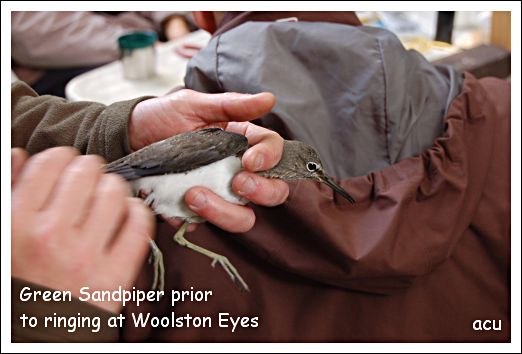 the Obs. Male Goldeneye and the usual Wigeon, Shoveler, Pochard, Tufted, etc.
the Obs. Male Goldeneye and the usual Wigeon, Shoveler, Pochard, Tufted, etc.Ciceley Mill Pool: Goldcrest with Long-tailed Tits, Blue Tits, etc – feeding flock. Got home before the rain started!!! ".........
A small group of Monday morning regulars at the reserve had a pleasant surprise during this weeks visit (6/11)......." Lots of Wildfowl, but difficult to count as most were in the shallows around the edge of the mere. 2 Goldeneye, 1 Dabchick, 2 Teal, Pochard, Tufted Duck and a large number of Shoveler. At one stage the ducks were spooked and took to the air. c.100 Shoveler were estimated.
Birds of the day though were undoubtedly two Green Sandpipers, found by Ken, at the far end of the Mere on one of two floating masses of vegetation that Phil first saw a couple of weeks ago. They were formed after exceptionally heavy rain washed them down from the surrounding fields and woodland."..........
We often see Lapwings overflying the reserve but, apart from occasional Snipe in the wetlands, waders are rarely seen at Rostherne, so the two Green Sandpipers constituted an excellent record.
Don't forget it's our November field trip on Sunday (12/11) when we'll be visiting The RSPB's reserve at Leighton Moss. Again please let the trip leader Derek Pike know if you're coming along. dek-jean@tiscali.co.uk
1st November 2023..... A sad loss.
I'm afraid this update begins with some sad news. John Somerville passed away on Friday last week (27/10). John was one of the Knutsford Ornithological Society's stalwarts,
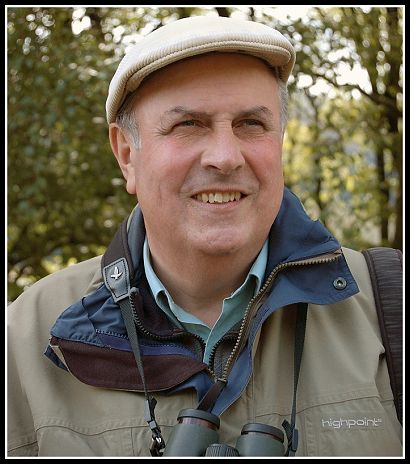 he joined during our first year and became a regular attendee at all the KOS's indoor meetings and field trips - day, weekend and our longer holidays at home or abroad.
he joined during our first year and became a regular attendee at all the KOS's indoor meetings and field trips - day, weekend and our longer holidays at home or abroad.John was a very positive person with a good sense of humour and wide range of interests - not only birds but also other aspects of natural history, especially flowers. In 2003 he set up a website, british-wild-flowers.co.uk with the aim of displaying good quality pictures of almost all the flowers found across Britain and Ireland. Some time ago he handed over the reins to Lynsey Crellin and Tom Squires but I don't know what will happen following John's death.
Our sincere condolences go to Barbara at this most difficult of times and I'm sure many members will wish to say their final goodbyes when appropriate arrangements have been made.
Last Friday's indoor meeting, when we welcomed back ex-KOS member Mark Eddowes, went down very well indeed. Mark's presentation was titled "Climate change impacts on passerine migrants: insights from citizen science data" I was concerned that the title might put people off but there was a good turnout and Mark was able to explain a very complex subject in layman's terms, the thinking behind his study, the methodology and his conclusions.
Large flocks of Pink-footed geese continue to be recorded locally. Last Thursday (26/10) Darren Morris had c.150 over Tatton park and Geoff and Sheila Blamire c.200 from Rostherne. (perhaps the same flock). The following day I counted 50 heading in a south-easterly direction when walking along Pavement Lane in Mobberley. G&S had c.100 on Saturday (28/10) as they were walking past Ceciley Mill, near Rostherne Mere. We've had some huge flocks recently and it should be good when they return on their way back to Iceland and Greenland in March.
The thick fog last Thursday morning caused problems at Manchester airport but it didn't stop the Blamires taking their morning constitutional!........"We walked down Chester Road with a grand plan of walking along Cherry Tree Lane, onto Marsh Lane and eventually to Rostherne Obs. When we reached Rostherne Lane the fog wasn't clearing at all so it would be hopeless to have a look over the fields along Cherry Tree Lane so veered off to Millington. Some good birds such as Treecreeper, Redwing, Yellowhammer, Reed Bunting and a Buzzard ‘worming’ in a field. But the time we got back the fog had just started to clear! The afternoon was spent gardening, particularly pruning – so many dying or dead trees in the garden….." They haven't cornered the Yellowhammer market yet though, we have them in Mobberley too; Wendy Stratford came across some on Friday when she ventured out to Gleavehouse Pool........"Walked to the GH pool today – first for a long time. There were skylarks up on the way there and back, and on the way back one was singing. The Gleave House field had a large flock of about 40 linnets feeding in the corn stubble, and the hedge top had a mixed group of tits, chaffinch, sparrows and linnets. In the field before the pool field there were yellowhammers on the top of the western hedge – often flying down into the field (also corn stubble). There were 2 males and 4 or 5 females/juveniles. In the field behind the obs the farmer has left a small area of corn standing – very popular with large numbers of crows and canada geese! On the pool – nothing apart from 2 mallard couples sadly. ".......
Our next field trip is to Leighton Moss, on Sunday 12th November. The trip leader is Derek Pike who needs to know who's going. So if you intend to join us an email should be sent to dek-jean@tiscali.co.uk
This Saturday a book by Brian Martin "From Wasteland to Wetland - A History of Woolston Eyes" will be launched. The venue is Grappenhall Community Library, at the junction of Victoria Avenue and Albert Road, Grappenhall, Warrington, WA4 2PE / WA4 2PF, from 2.30 to 4.30 pm.
You'll be able to purchase a copy for the introductory price of £20. It promises to be an interesting account of the establishment and continued expansion of one of the area's top birding spots
24th October 2023 ....... The first Fieldfares.
More local records this week of Ring-necked Parakeets, so it appears that they've well and truly arrived in the Knutsford area. Geoff
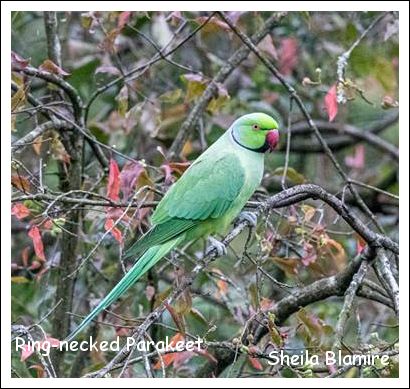 and Sheila Blamire hosted one in their Mere garden, where Sheila obtained the photo you can see on the left......"When I received a video from Darren at 8.33am of a Great White Egret flying over Tatton Mere I looked out of the window to see if it ventured our way. No sign – would have been a great new species for the garden. But I did add a new species this afternoon – not such a welcome species – it was a Ring-necked Parakeet!!! It was coming to our bird feeders, which were a little difficult for the parakeet, but it persevered, so it will come back I’m sure. I grabbed a few photos"........ I put our feeder out yesterday for the first time this season, so it will be interesting to see if one appears in Bucklow Avenue. It didn't take long for the birds to re-locate it and, this morning, we had a female Great Spotted Woodpecker - a good start.
and Sheila Blamire hosted one in their Mere garden, where Sheila obtained the photo you can see on the left......"When I received a video from Darren at 8.33am of a Great White Egret flying over Tatton Mere I looked out of the window to see if it ventured our way. No sign – would have been a great new species for the garden. But I did add a new species this afternoon – not such a welcome species – it was a Ring-necked Parakeet!!! It was coming to our bird feeders, which were a little difficult for the parakeet, but it persevered, so it will come back I’m sure. I grabbed a few photos"........ I put our feeder out yesterday for the first time this season, so it will be interesting to see if one appears in Bucklow Avenue. It didn't take long for the birds to re-locate it and, this morning, we had a female Great Spotted Woodpecker - a good start.How much are you paying for sunflower hearts? My supplier now charges £34 for 25Kg ≡ £1.36/Kg with free delivery, so the price has dropped compared with last Winter.
As usual Geoff and Sheila have been out and about on their daily walks from home and on Sunday came across their first Fieldfares of the Winter ........."Sunday 22 Oct 12+km around Plumley, Holford and Lostock Green: Raven and Kestrel (Plumley); 2 + 1 Yellowhammer (Holford); Brown Hare (Holford); 8 Fieldfare and 3 Redwing (in hawthorns, Inovyn Offices); 40+ Curlew (maize stubble field, Lostock Green); 30+ flock of Yellowhammer, Chaffinch, Goldfinch, Linnet, etc (Lostock Green in set-aside had been sown with sunflowers); Buzzard and great views of Chiffchaff (Lach Dennis); 2 Curlew (near Keeper’s Cottage).
Monday 23 Oct 12km around Mere and Millington: 2 Egyptian Geese (Little Mere); Buzzard, Kestrel, 36 Lapwings flew over, c25 Fieldfare and c15 Redwings in hawthorns;
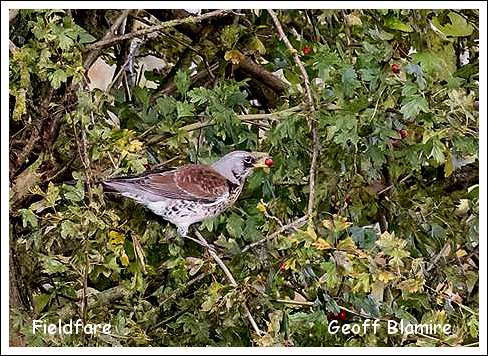 40+ flock of small birds including at least 7 Yellowhammers and Chaffinches (Moss Lane, High Legh/Millington). "..........
40+ flock of small birds including at least 7 Yellowhammers and Chaffinches (Moss Lane, High Legh/Millington). "..........On Sunday (22/10) Bob Groom took advantage of the benign conditions to do his wildfowl count over at Tabley Mere ........."Yesterday, with some decent sunshine and reasonably mild (Min 6C Max 14C) I decided to do the WEBS count. Half-a-dozen Mute Swans, but oddly no sign of the young ones (perhaps in the reeds or at the Moat), the roving Black Swan was present plus a Great White was seen briefly. Very few Mallards and Tufted Ducks. Coot numbers were also right down compared to the previous two months. No Canadas, just 4 Greylags. 6 Great Crested Grebes but just 1 Little Grebe. 2 Cormorants."..........
Next year Bob will have been doing this WeBS count for 40 years (never missing a month!!) but I know he's looking for some help and would like someone to eventually take over. So if you want to put a little bit back into your hobby, then this is an excellent opportunity.
There are many other ways birders can make a meaningful contribution to our knowledge and conservation of the natural world. The RSPB and BTO, for example, arrange a whole range of surveys that require an awful lot of data: basic facts, from which conclusions can be deduced and action taken or recommendations made. Some are one off, some last a few years and others (like the WeBS counts) continuous efforts. These data are obtained by volunteers, just normal folk doing their bit - Citizen Science
Another example is the Winter Gull Survey, WinGS. BTO representative, Hugh Pulsford, has asked me to draw this survey to our readers attention.
......." This is a heads up for the upcoming winter gull survey. Volunteers can request sites to watch and obviously don't have to do it on their own but as a team as necessary whoever the site gets allocated to.
We have Rostherne and the Tatton meres and other local sites on the list, so perhaps a note to KOS folks would generate some counters.
Full details are on the BTO site. Given the devastation of our inland gull colonies this is an important BTO survey for Cheshire and Wirral "........
This is the web page you want https://www.bto.org/our-science/projects/winter-gull-survey So if you'd like to take part you can phone Hugh of send him an email. You can find his contact details here.
So come on you gull aficionados, we know you're out there somewhere!
This Friday (27th October) you will be able to enjoy first-hand an account of some quite remarkable Citizen Science when we welcome Mark Eddowes to the Jubilee Hall for our KOS October indoor meeting. Many people will remember Mark, as he was a stalwart of the society for many years before moving to Bonsall in Derbyshire. Mark used to write the warbler section of the Cheshire Bird Report published by The Cheshire and Wirral Ornithological Society (CAWOS) and this was when he started to get interested in long distance passerine migrant arrival times. Mark will talk about this first and then look at some climate change-related range shift insights that come from the CAWOS atlases. These early citizen science studies set the baseline for his study of Redstarts that are using some of the 173 nest boxes he's placed in a steep-sided valley close to home. Due to the valley's topography there is more than 1⁰ C average temperature difference at different locations. By determining egg laying dates and location shifts Mark has been able to show how climate change is affecting our birds.
Mark's talk is entitled "Climate change impacts on passerine migrants: insights from citizen science data" Mark gave this presentation in 2022 to the British Ornithologist's Union but I know he is fully aware of the limitations of the average KOS member and will pitch the presentation accordingly!!
Mark's talk will begin at 8:00pm but the Jubilee Hall will be open from about 7:15pm, allowing time for members and visitors to do some catching up and socialising. Non-members will be made most welcome!
Late news this evening from Mere where Geoff and Sheila had the Winter's first Brambling, a female, in their garden today.
. 18th October 2023..... The Trip to North Wales
 |
We had a bit of a shock early on Sunday morning (15/10), an overnight frost, the first of the season, had left the car windows covered in ice. So the first job of the day (after re-locating the screen scraper) was some energetic de-icing! Job done and Len and I
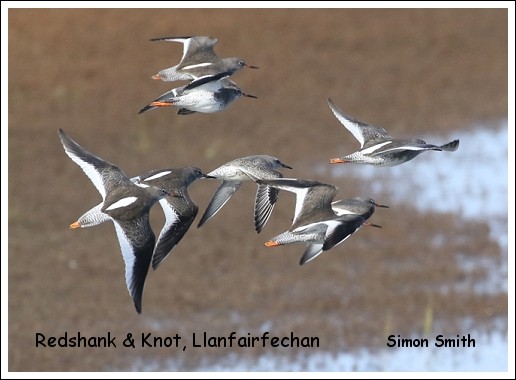 drove over to Knutsford to meet up with Hon. treasurer Frank Dearden who pointed the trusty old SAAB west for our journey to North Wales.
drove over to Knutsford to meet up with Hon. treasurer Frank Dearden who pointed the trusty old SAAB west for our journey to North Wales.Reaching the end of the M56, where it becomes the A55 at Dunkirk, the sky was filled with huge numbers of Pink-footed Geese, heading inland after their overnight roost on the Dee estuary. We passed the Marble Church at Bodelwyddan on the hour, Conwy RSPB after 1¼ hours, reaching the car park at Llanfairfechan exactly 90minutes after setting off from Knutsford.
Moving seamlessly from his role as chauffeur to that of team leader, Frank assembled a good turnout of 18 members and Skye - Jacquie's dog, into some sort of order as we set off along the coast towards the Morfa Madryn reserve.
Probably more by luck than judgment we'd chosen a day with a high tide and a start time when it was just reaching its peak. Flocks of Oystercatchers and Dunlin passed close to the shore, whilst further out telescopes revealed good numbers of Common Scoters and, on the sea a lone Eider. Jude Halman found us two imm/female Goosanders at the mouth of the Arfon Llanfairfechan where it enters the sea, on our return journey Grey Wagtail and Dipper were recorded at the same location.
The incoming tide had forced the waders closer to the path and, amongst the sea wrack and general detritus we had great views of Ringed Plovers, Redshanks, Turnstones, Dunlin and Curlew.
Passing along the embankment overlooking the Glan y Mor Elias reserve Skylark, Stonechat, Wigeon, Tufted Duck, Pintail, Little Egret and others were added to the day list.
The first hide at the Morfa Madryn reserve was closed and views from the second restricted by overgrown vegetation but from the third one along we had good views of the lake and it's birds. On an island
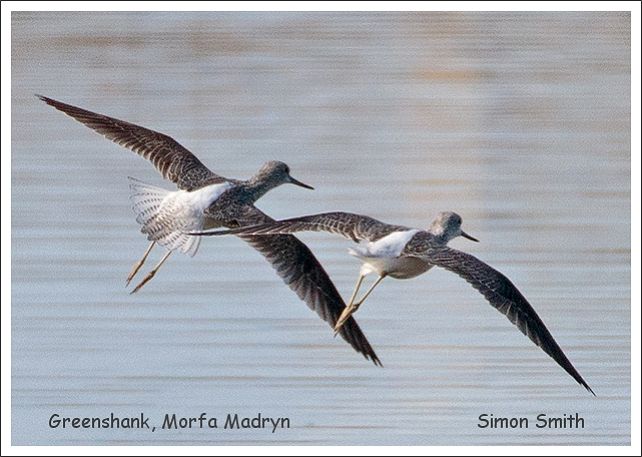 in the centre and along the shoreline Curlew, Redshank, Dunlin, Knot, Bar-tailed Godwits and Greenshank were sitting out the tide, taking to the air from time to time giving Simon chance to grab more of his superb in-flight images.
in the centre and along the shoreline Curlew, Redshank, Dunlin, Knot, Bar-tailed Godwits and Greenshank were sitting out the tide, taking to the air from time to time giving Simon chance to grab more of his superb in-flight images.On the walk back to Llanfairfechan it soon became apparent that most of us, in anticipation of much colder weather, had over-dressed for the day - it was warm and sunny and the locals were out in their shorts and T-shirts! Well worth it though, this is a great location and I'm sure we'll be including it in next year's itinerary.
Lunchtime butties were enjoyed back at the car park, sat on the sea-facing benches or the sea wall with views across the Menai Strait to the Isle of Anglesey - Beaumaris, Penmon Point and Puffin Island.
Time was marching on though and it was almost 2pm before we arrived at our second venue - the RSPB's Conwy reserve. Most people enjoyed a coffee at the newly refurbished cafe - smart and functional but nowhere to set up 'scopes to view the closest pools and, sadly, the snug leather settees have vanished (although I did find them later in the building next-door, where they entertain school parties!). A good number of new species were added to the list; from the hides - Moorhen, Coot, Black-tailed Godwit, Shoveler, Little Grebe, Teal and Buzzard. Arriving back at the car park others had recorded some common species such as Reed Bunting, Chiffchaff, Chaffinch, Coal Tit, Cetti's Warbler and Sparrowhawk bringing the total for the day to a respectable 64.
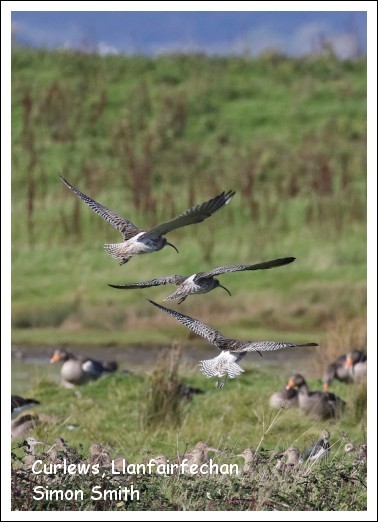
Our thanks go to our leader, Frank - two good locations, some good birds and the usual good company. We must do it again sometime!
Meanwhile back in Knutsford, on the same day, Alan Booth had the first Goldeneye of the Autumn on Tatton Mere and, this morning (18/10), Ranger Darren Morris reports a Great White Egret on the same mere. Darren also had a Ring-necked Parakeet, Jude Halman saw 5, + the first local Fieldfares of the Autumn, yesterday (17/10) on a U3A walk in Mobberley and Alan Gillespie's wife filmed 5 on her mobile phone in the garden of their house along Manchester Road, last Sunday (15/10). They're here!
I spent a short time yesterday morning (17/10) at the dentists on Gaskell Avenue. The only pain I suffered came as I was leaving and had to pay! At the same time Bob Groom was in Tatton ......."The lovely sunshine tempted me into the Park. At first it was as if I had wandered into a sheep farm, they were everywhere! In contrast ,Melchett Mere was relatively deserted. Just a few Mallard, Coot and Pochard plus a single Cormorant. A Kestrel put in several appearances but surprisingly there was no sign of buzzard. An interesting bit of behaviour was the pair of Stonechats systematically foraging on the line of seats alongside the head of Tatton Mere. Later 3 birds were seen in the air together. A juvenile Great Crested Grebe was still begging for food from the adult. There were at least 7 more Pochard. Also a very surreptitious Heron. Min 1C Max 14C Tomorrow looking OK in the day but Storm Babette (what an inappropriate name) is scheduled to arrive in the evening with wind and heavy rain (but mild). Looks as if Scotland will get flooded yet again.".........
I had a rewarding morning last Friday (13/10). With heavy rain forecast I decided against a Mobberley walk and, instead, spent a couple of hours in the Rostherne observatory. As usual not much going on now that the Hobbies have left but I was delighted just before 10am when flock of nine Whooper Swans arrived and alighted in the middle of the mere (8 adults and 1 juvenile). I rang Geoff and Sheila Blamire with the news, as I knew they were just down the road. By the time they arrived the swans had drifted out of view but at 11:05am they left, doing a circuit of the mere before heading off in an easterly direction. I managed a record shot.
 |
It appears that G&S have been looking at the ground as well as in the air on their daily outings! .........."We did our Millington walk again this morning. This time no Redwings on the large hawthorn trees along Moss Lane even though still covered in berries – perhaps the Kestrel perched on top of the biggest tree had something to do with it!!! Along Millington Lane there was a very vocal Chiffchaff. But the highlights were insect-related. First was a Devil's Coach Horse Beetle – we've seen them quite a few times recently. When threatened, the beetle raises its abdomen in similar style to a scorpion and opens its powerful jaws. But this was different – it emitted a foul-smelling white substance from its abdomens. We left it alone and moved on! Along Mereside Road we came across a species we've never seen before – German Wasp. Not only that, it was a queen and drone mating! Drones are fertile males only present late summer/autumn. They were joined together with the queen dragging the male along – it looked painful! We watched it for at least 15 minutes so we thought we should get home – and leave them to it. I couldn't find out on the internet how long mating lasts for – and whether it was unusual or not.
Here's a short clip from Geoff’s video: https://www.youtube.com/watch?v=b5nGBe_y_IU"...........
Species recorded on the KOS trip to North Wales, 15th October 2023 |
A bit like Easter, the first day of the KOS Spring is a moveable feast and is taken as the day that the first Sand Martin of the season arrives over Tatton Mere!
Perhaps we can do the same for Autumn
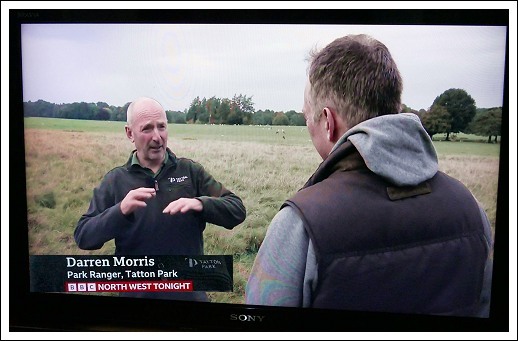 and the first record of one of our migratory Winter visitors. I would suggest Redwing, they are common enough and easy to identify, not only during daylight hours but also at night as they pass over uttering their high pitched calls. That being the case yesterday (9th October) was officially the first day of Autumn with a text from Tatton Ranger Darren Morris saying, simply "Redwings everywhere!". So get outside this evening, before the forecast heavy rain showers, and take a listen. I won't need to this year, as I had a flock of 30 passing over this morning whilst on a pleasant stroll around the lanes of Mobberley. During this morning's walk I heard a call with which I wasn't familiar. It came from an ash tree and the source was quickly evident - Ring-necked Parakeets, 7 of them! These are the first I've seen in the village, they are common in some parts of southern Britain of course, where they're regarded as a pest. perhaps the same will happen up here but I must say I thought they looked great when they took to the air - I rather like them!
and the first record of one of our migratory Winter visitors. I would suggest Redwing, they are common enough and easy to identify, not only during daylight hours but also at night as they pass over uttering their high pitched calls. That being the case yesterday (9th October) was officially the first day of Autumn with a text from Tatton Ranger Darren Morris saying, simply "Redwings everywhere!". So get outside this evening, before the forecast heavy rain showers, and take a listen. I won't need to this year, as I had a flock of 30 passing over this morning whilst on a pleasant stroll around the lanes of Mobberley. During this morning's walk I heard a call with which I wasn't familiar. It came from an ash tree and the source was quickly evident - Ring-necked Parakeets, 7 of them! These are the first I've seen in the village, they are common in some parts of southern Britain of course, where they're regarded as a pest. perhaps the same will happen up here but I must say I thought they looked great when they took to the air - I rather like them!Incidentally I wonder if you saw Darren on TV the other night when the BBC featured the deer rut in Tatton Park? He came over very well - not a trace of nerves. Just the same some years ago when he joined the late Dianne Oxberry in a live transmission on the Northern News. There's an opening there for you when you retire, Darren.
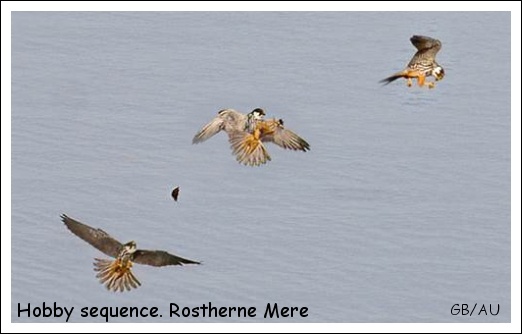 Other Winter visitors are arriving too and on Monday (9/10), again whilst "beating the bounds" of Mobberley, I had a flock of about 50 Pink-footed Geese heading south-east towards East Anglia. Even more yesterday (9/10), sat in the comfort of the Rostherne obs., with Jude Halman and Steve Collins, a huge flock flew over in the same direction. I managed to get a quick shot on the camera and later analysis revealed there were 235 birds.
Other Winter visitors are arriving too and on Monday (9/10), again whilst "beating the bounds" of Mobberley, I had a flock of about 50 Pink-footed Geese heading south-east towards East Anglia. Even more yesterday (9/10), sat in the comfort of the Rostherne obs., with Jude Halman and Steve Collins, a huge flock flew over in the same direction. I managed to get a quick shot on the camera and later analysis revealed there were 235 birds.Some Summer migrants are still around but most have moved south and we'll not see them until next Spring. The last record of Swallows, so far, concerned a substantial movement seen by Derek Pike on the 29th September in Tatton Park ........"Visible migration, viewed from Tatton Gardens this afternoon approximately four/five groups 20-30 in a group of Swallows briefly feeding over Melchett before moving on ".........
The Hobbies at Rostherne continue to hang on, the latest ever record for the reserve is 11th October, so this may be the last week before they too leave for warmer climes; yesterday (9/10) just one, a juvenile bird, remained. Geoff Blamire managed some record shots of a bird hunting over the mere and I stitched three of them together to produce the image you see on the right as one of the birds captured a butterfly before eating it on the wing.
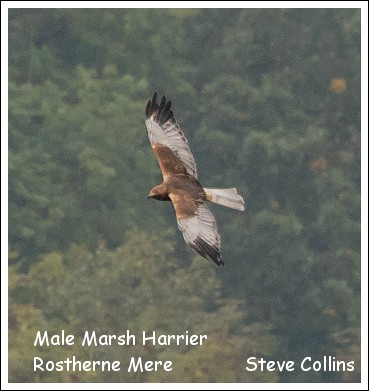 Steve was anxious to connect with the female Marsh Harrier that has been frequenting the reserve recently, as he didn't have the species on his Rostherne list. We left him on his own, waiting patiently. He didn't see the female but he did have a male bird instead! (see his record shot). Amazingly today (10/10) Rostherne had two Marsh Harriers, a male and a female - perhaps from Woolston?
Steve was anxious to connect with the female Marsh Harrier that has been frequenting the reserve recently, as he didn't have the species on his Rostherne list. We left him on his own, waiting patiently. He didn't see the female but he did have a male bird instead! (see his record shot). Amazingly today (10/10) Rostherne had two Marsh Harriers, a male and a female - perhaps from Woolston?The latest Rostherne quarterly review, edited by Bill Bellamy has been sent out to all permit holders. You too can read it click here
Talking of Woolston Eyes, the WECG have been awarded a substantial sum of money to try and halt the decline of their Willow Tits. .........."We've been fortunate at Woolston Eyes to see our application for nearly £100,000, from the national Species Recovery Programme, being successful. The fund, which is administered by Natural England, has been created to try and halt the decline in some of the nation's most important species. For us, it’s our critically important Willow Tits. The money will be used to employ a contractor to coppice 54 hectares of woodland and scrub across the Reserve, turning back the succession to mature woodland. Willow Tits need young, low scrub with diverse ground cover and a supply of rotting stumps, in which they excavate their nests, In order to thrive. Research is another aspect of the programme, with successful bidders being required to contribute to our knowledge of species recovery nationally. So, we’ll be trialling different approaches to coppicing and monitoring their outcomes, in terms of breeding Willow Tit pairs."........... Well done!! The group put in an amazing amount of voluntary work on the reserve.
Finally Sheila Blamire found the following on the Burton Mere website. It might be of interest to some KOS members ......."Using funds that were kindly donated by Puffins Galore, we have been able to replace our old mobility scooters with two shiny new Trampers. ?? These are free to hire for the day...........
29th September 2023....... Manx Shearwater on Melchett Mere.
The image on the left was taken on Tuesday last week (19/9) and shows a Manx Shearwater on Tatton Park's Melchett Mere. Judging by the vignetting
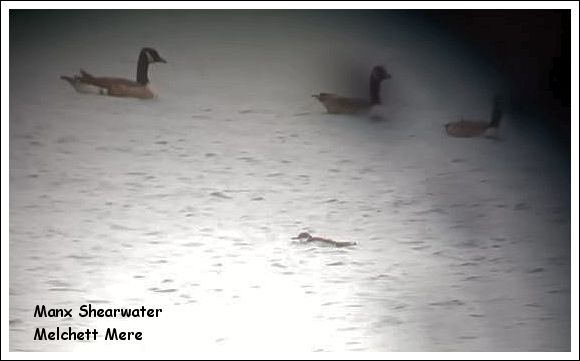 on the picture it appears to have been digiscoped but we don't know who it was that found the bird but whoever it was, I hope you don't mind me using your image here and if you read this please contact me and I can put an attribution on it!
on the picture it appears to have been digiscoped but we don't know who it was that found the bird but whoever it was, I hope you don't mind me using your image here and if you read this please contact me and I can put an attribution on it!The Shearwater arrived after a night of very strong winds as the remains of hurricane Lee moved in from the Atlantic, these autumn gales are known to be responsible for inland records of some pelagic species, including Manx Shearwater. Tatton's last record came almost exactly 20 years ago, on the 10th September 2003 when Tatton ranger Darren Morris rescued a bird from the jaws of a greyhound, unfortunately it succumbed to it's injuries and the body placed in a freezer for further examination to determine it's state of health immediately prior to it's death.
Hobbies are still with us and providing great viewing from the observatory at Rostherne Mere. Geoff and Sheila Blamire had a single bird last Thursday (20/9)..........."We did Rostherne again this morning – and again we got rather wet! The ‘usual’ feature in Martin’s Field, Rostherne village, was a large flock of Egyptian Geese – this time we counted 19-20 (on Monday we had 23). As usual we walked down and back along Rostherne Lane before going to the Obs. Scanning from the footpath halfway along the lane a Hobby was perched up – but flew off towards the Obs. By the time we got there it had disappeared. Bill Bellamy was there and he had both Hobbies. They didn’t reappear during the time we were there".............

Bob Groom and KOS Secretary Karina Stanley did even better on Sunday (24/9)........"Fabulous morning at Rostherne with Karina (later joined by Simon Cook and Donald McDonald, who has bought a copy of my book!) No less than THREE Hobbies, great flying displays, including a food pass. An adult and 2 juveniles, also perched. (Presumably the regular) juvenile using the usual three trees, the other spent some time on a tree in the Cormorant colony. Two perched together at times. Also 30+ Goldfinches, Kestrel, Buzzards, female Great Spotted, Jay, Herons etc. We had 20+ Swallows on wires on Rostherne Lane and a few more over the mere, also a House Martin"...........
Geoff, Sheila and I did even better on Monday (25/9) with four Hobbies, one adult and three juvenile birds! Rostherne's latest ever record for the species is 11th October, so there's still time for some fabulous views before they leave for Africa. Also on the reserve 5 Ravens over Mere Covert, enjoying the early morning breeze with some spectacular aerobatics and much calling. Wildfowl numbers are slowly increasing and we counted 6 Pochard and 5 Wigeon.
It was nice to hear again from Phil Rowley who lives in a cottage in the grounds of Blithfield Hall. As you can imagine he enjoys his nice "local patch"! ........."Had a lovely walk around the southern basin of Blithfield Reservoir Sunday 17th.
There's lots of swallows and house martins and the odd sandwich tern about, the swifts have headed off but still a few common terns which have had a very successful breeding season here.
The Osprey reared just the one chick this year and was a pleasure, as you can imagine, to have on my doorstep as well as a pair of Red Kite nesting too.
The Spotted Flycatchers came back to their usual crack in the estate wall plus the added bonus of no less than 4 young Sparrowhawk being raised next to St. Leonard's Church and have been taking advantage on the abundance of wood pigeons taking them out twice on my lawn, in full view from my Kitchen window!!!!
It was a leisurely 6 mile stroll, not on par with two of our seasoned KOS walkers, 20'C and T-shirt weather with a very gentle breeze.
The usual fair on the Reservoir, + Curlew Sandpiper, 11 yellow wagtail, Wheatear, little stint, 2 x hobby, Peregrine, Greenshank, 4 red kite, several tree sparrows off Mickledale.
The highlight though was at the start as I walked along the causeway splitting North and South basins, great views of a Goshawk over the Yeatsall bank plantation, I last saw here 29th December '22 and what a magnificent bird!!! "...........
Last Friday a good turnout of members and guests enjoyed the first indoor meeting of the autumn/winter season when Steve Watson survived a 5 hour drive up from Gloucester to talk to us about "The Peregrine Falcon". He and Dr. Richard Sales have recently published their 550 page book titled (of course) "The Peregrine Falcon". Having watched their presentation to the BOC on Youtube, I was glad Steve pitched it at level the average KOS member could understand!
Our next get together is on Sunday October 15th when we have a field trip to North Wales - Llanfairfechan and the RSPB's Conwy reserve. We will be meeting up in the car park at Llanfairfechan at 10am. Our leader for this trip will be Frank Dearden who would appreciate it if you let him know if you're coming along treasurer@10X50.com
20th September 2023....... The first Pinkfeet and last of our Swallows.
It appears that Autumn is now well and truly with us, just 15⁰C at the moment and very windy, with remnants of Hurricane Nigel sweeping across the UK from the Atlantic.
It was still shirt sleeve weather last Friday (15/9) when I enjoyed a walk along Gleavehouse Lane in Mobberley where the Swallows at Blackthorn farm were enjoying the benign conditions too. There were around 25 birds giving great views as they perched on the electric cables running alongside the road. I'd not taken my camera, so I went back two days later to get some pictures - too late of course, they'd all gone! It wasn't a wasted journey though as, walking towards Springwood farm, I distinctly heard the unmistakable call of Pink-footed Geese, there were plenty of Canada Goose flocks around but I couldn't see any pinkfeet so I was pleased to discover that three overflew Rostherne Mere during the monthly wildfowl count.
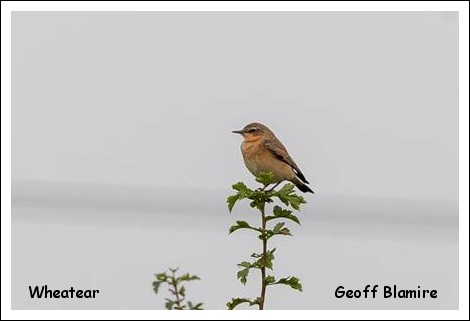 These must have been the ones that I heard.
These must have been the ones that I heard.On the same day, Bob Groom was also doing his WeBS count over at Tabley Mere ........"A pleasant enough morning for it. - Min 15C Max 20C. Coot numbers down somewhat on last month but still well over 100. In contrast ducks scarce, just a couple of Tufties and barely 30 Mallards, though there was a late brood of small ducklings. 6 adult Mute Swans and 4 of the 5 now well-grown cygnets. 3 young Great Crested Grebes were very vocal, also 4 adults. Just one Little Grebe. Heron and a couple of Moorhens, and that was it."..........
Geoff and Sheila Blamire also found plenty of Swallows around recently on a new walking route, close to home........"This morning we decided to try a new walk which we knew that would include walking through fields – best to try during dry weather. We sent off from home at 8am – it was a little chilly (relatively!). Headed towards along Chester Road to Knowles Pit Farm (still Swallows around the farm and a Chiffchaff), then along Bentleyhurst Lane, past Bentleyhurst Farm and through a farm gate onto the fields. Surprising was Great Black-backed Gull which flew low over us! Eventually we reached a derelict stile – no chance to cross it, and the farm gate was locked. So… Climb the gate or turn back? We decided to turn back. Best decision - because Geoff spotted a Wheatear – see the record shot… "............
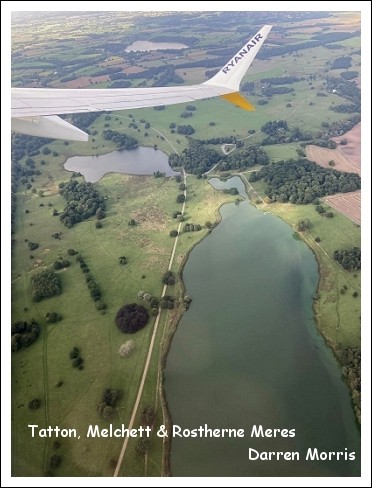 Hobbies are still around and there are frequent records from Tatton and Rostherne. Are these the same birds? Probably, as the two locations are so close together - illustrated well by Darren's overhead shot taken this week when he flew over the park on his way to visit friends in Holland. It was nice to hear again from Roger Barnes who had a Hobby perched close to Tatton's Melchett Mere last Thursday (14/9) and on Sunday (17/9), also in the park, Derek Pike saw a female Stonechat near to the Mill Pool. I thought that this was the first of the travellers that spend the Winter in Tatton but Darren pointed out that a family party was seen in June this year so they may have bred and it could have been one of them. Whatever it's nice to have them around - very photogenic, the world is in need of more Stonechat images!
Hobbies are still around and there are frequent records from Tatton and Rostherne. Are these the same birds? Probably, as the two locations are so close together - illustrated well by Darren's overhead shot taken this week when he flew over the park on his way to visit friends in Holland. It was nice to hear again from Roger Barnes who had a Hobby perched close to Tatton's Melchett Mere last Thursday (14/9) and on Sunday (17/9), also in the park, Derek Pike saw a female Stonechat near to the Mill Pool. I thought that this was the first of the travellers that spend the Winter in Tatton but Darren pointed out that a family party was seen in June this year so they may have bred and it could have been one of them. Whatever it's nice to have them around - very photogenic, the world is in need of more Stonechat images!Over at Rostherne up to three Hobbies have been seen at the same time, on one occasion an adult was seen to feed a youngster via a spectacular food pass. On Monday this week (18/9), whilst carrying out her voluntary cleaning activities at the Observatory, Jude Halman had two birds and yesterday, despite the heavy rain and gale force winds, Jude, Ken Davies and I spotted a Hobby on it's "usual" perch; despite the inclement weather it remained there for the three hours we spent in the obs. From time to time it did a few circuits and bumps, once sallying forth to cause a passing Buzzard a bit of aggravation.
Other news from the reserve - the first Goosanders have been seen on the mere and yesterday we had a Pochard, this may have been the first of the Autumn but I suspect the "tick list" in the obs. is not always filled in by visitors. Malcolm Calvert tell me that, on the 31st August he ringed a juvenile Willow Tit at the waters edge below Old Hall Wood, it would be great to see or hear one from the obs. sometime in the future.
A reminder that this Friday (22nd September) it's our first indoor meeting of the new season when Steve Watson will be talking to us about "The Peregrine Falcon". In person none of your zoom meetings with the KOS!
Steve Watson is a raptor enthusiast with a particular interest in observing and understanding the behaviour of Peregrine Falcons in the field. He has produced and presented a series of illustrated talks on Peregrines and Goshawks and is in process of extending these to other raptors. Steve often runs talks for RSPB and Wildlife Trusts and is available to run presentations at short notice – all fees donated to GRMG (Gloucstershire Raptor Monitoring Group)
Steve and Richard Sale have recently published their 500+ page book "The Peregrine Falcon". I guess he'll be bringing some copies along and will sign any he sells.
The presentation will begin at 8:00pm in the usual Jubilee Hall, Stanley Road, Knutsford. WA16 0GP. Doors will be open at 7:15pm, giving time for attendees to catch up on the latest news and gossip and even help to put out the chairs, if you're early enough!
Non-members are most welcome!
10th September 2023......The Woolston trip & a memorable day at Rostherne.
The "Re-fresh Knutsford" event took place on Saturday 2nd September, when 40 community groups, hobby and skill classes gathered together to publicise their own particular organisation.
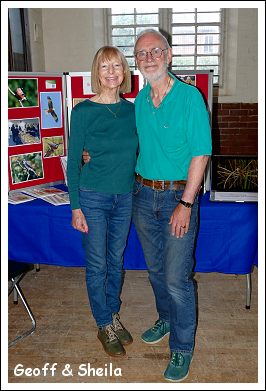 The KOS had a stand for the first time, I printed out some images that I thought would be appropriate for the occasion and Geoff and Sheila Blamire positioned them on three display panels that fitted nicely on the trestle table provided for our use. Geoff also sorted out a slide show on his laptop, which was positioned on the table and provided more images showing our activities over the years. We also had a copy of the RSPB's "Let nature sing" audio track featuring the songs of 25 different British bird species; this was played on a loop and allowed us to demonstrate the Merlin app.
The KOS had a stand for the first time, I printed out some images that I thought would be appropriate for the occasion and Geoff and Sheila Blamire positioned them on three display panels that fitted nicely on the trestle table provided for our use. Geoff also sorted out a slide show on his laptop, which was positioned on the table and provided more images showing our activities over the years. We also had a copy of the RSPB's "Let nature sing" audio track featuring the songs of 25 different British bird species; this was played on a loop and allowed us to demonstrate the Merlin app.After a slow start more visitors arrived and we were able to explain to them what the KOS was all about and their lives could be enriched by joining us!!
From our point of view the afternoon was very successful and we talked to a number of folk who seemed to be genuinely interested in our little club and I'm cautiously optimistic that we'll be welcoming some of them into the fold before too long!
Today was the seventh day in a row where, somewhere in the UK, the temperature exceeded 30⁰C , this hot spell has come as a surprise after such disappointing weather during the previous two months but it made for sticky conditions yesterday (9/9) for our field trip to Woolston Eyes Nature Reserve. Sheila was our leader for this trip and led a party of 13 over the iron bridge onto the reserve. We spent some time on the bridge, ticking off some of the more common species on our day list, and were delighted when a Kingfisher passed just below us and perched in full view for a few seconds before another fly past (or perhaps it should be fly under!) vanishing from view towards Weir Lane.
Walking further there was some confusion about the bird song we could hear - Reed Warbler, Chiffchaff, Blackcap and even Lesser Whitethroat, out of season for all except, perhaps, for the Chiffchaff which does start to sing again at the beginning of Autumn. Having visited Woolston many times over the years we realised that, again, it was the ringers who were using a tape recorder to lure passing migrants into the mist nets that we could see peeping over the top of the phragmites reeds. We did, though, actually hear Blackcaps and Chiffchaffs calling from the tangled vegetation as we passed through the reserve, so they both went onto the list.
Arriving at the Morgan hide I was just too late to see Sparrowhawk, Buzzard and female Marsh Harrier that had passed by a few minutes earlier. The usual wildfowl were on view from the hide - Mallard, Gadwall, Shoveler, Canada Geese, Tufted Duck, Shoveler, Teal, Little and Great Crested Grebe. a single Swallow flew over and Bob Groom picked out the call of a Green Sandpiper as it sped past, giving us just a fleeting view. Green and Goldfinches were using the feeders, a Dunnock fed on the ground beneath but there was no sign yesterday of any Willow Tits. A warbler moving around in the middle of a bush below us caused some discussion, giving just a brief view as it flew off - Derek Pike declared it a Reed Warbler, Geoff managed a record shot - causing even more speculation. I
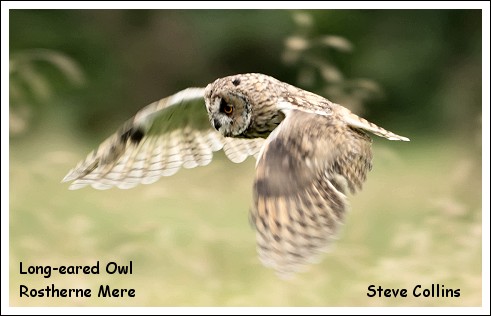 sent the image to Hugh Pulsford who confirmed it as a Reed Warbler - Derek was correct - top birder!
sent the image to Hugh Pulsford who confirmed it as a Reed Warbler - Derek was correct - top birder!Reaching the cars for lunch, after circling number 3 bed, most people decided that it was just too hot for any more walking and headed for home but four stalwarts - Geoff, Sheila, Derek and Hon. Treasurer Frank Dearden decided a flog around number 4 bed was in order and they reached the Loop hide where two Juvenile Black-necked Grebes brought the list to a respectable 46 species.
On Thursday 31st August Steve Collins was out on the reserve at Rostherne with his daughter Emily, three Hobbies was a great way to start the day but this was followed by the amazing sight of a Long-eared Owl in flight in broad daylight! Ever ready with his camera Steve obtained some great images, one of which you can see on the right. Thanks Steve! On the same day a Willow Tit was reported from Dave's hide: it lies just to the left of, and slightly below, the main observatory. Last year Malcolm Calvert ringed a Willow Tit on the reserve and Tatton ranger, Darren Morris had a possible, near to Melchett Mere in the park. So there is a chance that this increasingly rare species is still hanging on in the Knutsford area. Rostherne seems to be enjoying a purple patch - this morning (10/9) there was a flock of 22 Egyptian Geese on a field close to the reserve, a Marsh harrier was seen by Sheelagh Halsey, who also had the first Goosander of the season. Mike Duckham also had the first Shoveler of the Autumn last Thursday.
And Autumn it is! Darren kindly sent me a copy of the Autumn edition of Tatton News [click here to read it] and, over in Merseyside, Barrie Armitt has, once again, taken to his Crosby sand dune where he filmed the arrival of the Autumn's first returning Pinkfeet on Thursday (7/9) [click here] - thanks chaps!
Species recorded on the trip to Woolston Eyes. - Saturday 9th September 2023 |
20⁰C yesterday afternoon as I made my way over to Mobberley's Gleavehouse Pool, more in hope than anticipation - and I wasn't disappointed! It was very quiet again as I sat overlooking the pool; it's quite a substantial size and things must drop in from time to time - but not yesterday.
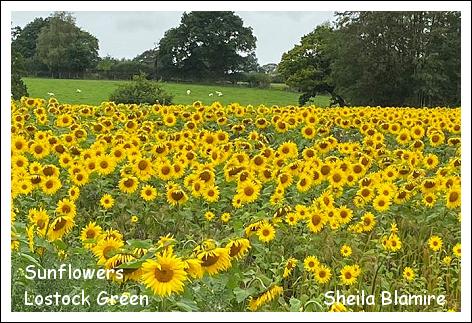
Taking advantage of the thermals a Buzzard circled lazily overhead and a nice male Kestrel hovered for a few seconds above the hedgerow repeating the exercise 50 yards further along before moving on to a more productive area. A Chiffchaff called quietly as it moved along the hawthorn hedge towards where I sat but, just before coming within range of the camera, it must have spotted me and away it went; but it was a pleasant enough afternoon in a quiet part of the village, away from the constant distraction of air traffic further towards the centre.
Walking back along Gleavehouse Lane there were still good numbers of Swallows at Blackthorn Farm livery stables with fledged youngsters flying alongside their parents soliciting for food. I passed a number of locals collecting blackberries from the hedgerows; there's an excellent crop this year and, earlier in the week, I filled a plastic bag with berries - Olwen made a delicious blackberry crumble with these - food for free!
On a walk around Plumley and Lostock green on Tuesday (28/8) Geoff and Sheila Blamire noted plenty of Swallows too, ......"We haven’t been to this area for many weeks so re-did our 11km walk this morning.
Plumley was quiet: Chiffchaff, Blackcap, Buzzard and Kestrel.
Holford: flock of 200+ Starlings and many small flocks of Swallows hawking over the fields and a few House Martins. Lostock Green: the sunflower field from 2 years ago still hasn’t been ploughed resulting in many self-sown sunflowers – very late and smaller plants. But hopefully they will attract many species of finches and buntings – perhaps Bramblings again?
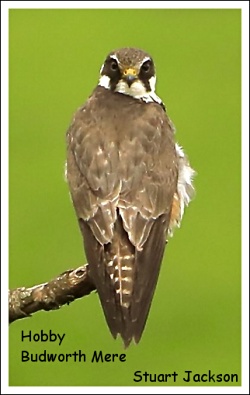 "...........
"........... Bob Groom continues with his monthly WeBS counts at Tabley Mere, this from the latest, on Sunday 20th August ......."A nice day for the count - Min 14C Max 23C. Again the dominant species was Coot with numbers approaching 200. In contrast under 20 Mallards and no Tufted Ducks. August is the worst month for visibility (through the trees), however. All 5 cygnets were with the Mute Swan pair and the other adult still tolerated. I was pleased to see 3 small young with an adult Great Crested Grebe. The two older juveniles were with another adult. Just one Heron.".........
Of course, at this time of the year, Bob's week is not complete without a Hobby sighting! Rostherne records are a bit patchy at the moment so he headed off to Budworth Mere to get a much need fix!........."On Saturday I went over to Marbury on the (correct) assumption that the uncertain weather would put people off, despite it being a bank holiday weekend. In the event there was an event on but still lots of parking. A guy there had got some great shots of Hobby on the half-dead tree. I'd just missed it. After a longish wait two birds appeared, briefly flying over the reedbed. One perched on the far side but the weather quickly closed in and it literally 'disappeared'. A Common Tern appeared and there were at least 250 Swallows over the mere. Also Little Grebes, Chiffchaffs and Stock Doves. I returned this morning (27/8) with the weather somewhat better, although still cold and windy, but had no luck with hobby. There was a consolation prize, however, with brilliant views of at least 4 Kingfishers below the hide! Also, c.200 Swallows, 2 Buzzards, Lapwings, 45 Great Crested Grebes (and it;s not even winter yet, though it feels rather like it.) Min 8C Max 17C."............
Now then, pay attention - three dates for your diary.
On Saturday (2nd September) Knutsford Council are again organising an event called "Re-Fresh Knutsford". 40 local organisations - community groups, hobby and skill classes will be present giving
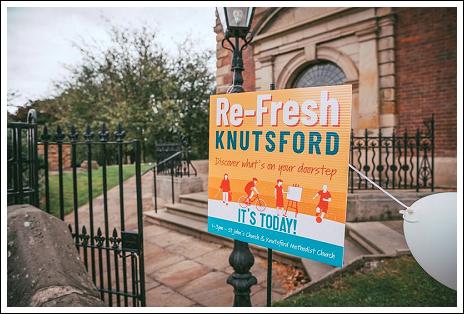 residents a chance to see the surprisingly extensive range of activities available to those prepared to make the effort. The event takes place between 1pm and 3pm and is split between two venues - St. John's church and, just across the road, the old Egerton School. We (the KOS) will be in attendance at the school, so please come along and say hello!
residents a chance to see the surprisingly extensive range of activities available to those prepared to make the effort. The event takes place between 1pm and 3pm and is split between two venues - St. John's church and, just across the road, the old Egerton School. We (the KOS) will be in attendance at the school, so please come along and say hello!The following day (Sunday 3rd September) it's the first stage of the 2023 Tour of Britain cycle race and again the riders pass through Mobberley. Kick off is at 11:45 am from Altrincham with the "start proper" along Cow Lane, Ashley at 12:00 noon, So they should be travelling along Hobcroft Lane in Mobberley a few minutes later. It's quite a spectacle, with police motorcycles arriving shortly before the riders to block adjoining roads, TV helicopters overhead, the peleton itself, followed by the team cars. The whole thing is over in about 10 minutes and sleepy, Sunday Mobberley can return to normal!
A week on Saturday (9th September) it's our first field trip of the new season when we'll be visiting the Woolston Eyes Nature Reserve in Warrington. 10am at the first locked barrier. Sheila Blamire will be trip leader, if you're coming along please let her know, I'm sure she would appreciate it if you do so. sheila@onlybirding.com
19th August 2023........ Reed Warblers at Rostherne Mere.
Hugh Pulsford's excellent article summerising bird ringing operations on Knutsford Moor went down very well with the troops and also prompted Malcolm Calvert to send me an account of his ringing activities at Rostherne Mere, where he's been ringing Reed Warblers for more than 50 years!
Following the informative narrative on the warblers of Knutsford Moor from my SMRG colleague, Hugh Pulsford I would like to provide an insight into the population of Rostherne Mere Reed Warblers.
In the early
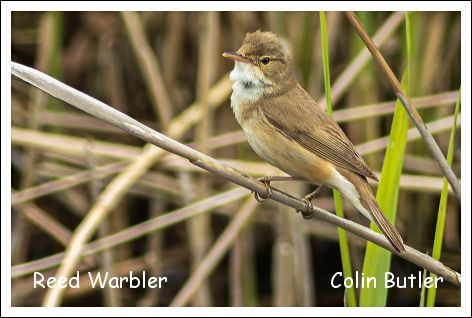 1970s the reed beds around the mere were generally narrow and in the absence of damage from winter roosting Starlings, I was able to find most of the warbler nests and ring the nestlings.
1970s the reed beds around the mere were generally narrow and in the absence of damage from winter roosting Starlings, I was able to find most of the warbler nests and ring the nestlings.From 2004 heavy trashing of the reed stands made human access more difficult and my attention then focused on the aim of capturing the full-grown birds.
In 1998 the BTO introduced the RAS scheme (re trapping adults to calculate survival rates) and my project is unique in being the only Reed Warbler study established in the inaugural year and continuing to the present time.
I estimate 55 to 60 pairs of Reed Warblers nesting annually on the reserve and my return normally identifies at least 100 adults each season on the reserve. The BTO calculate an annual survival rate for the adults at around 55%. In simple terms, of a nesting pair, one would survive to the next breeding season and the missing bird would be replaced from the previous year’s young.
Now for the interesting bit! Like tossing a coin and continually calling correctly, individual birds can defy the odds, survive,
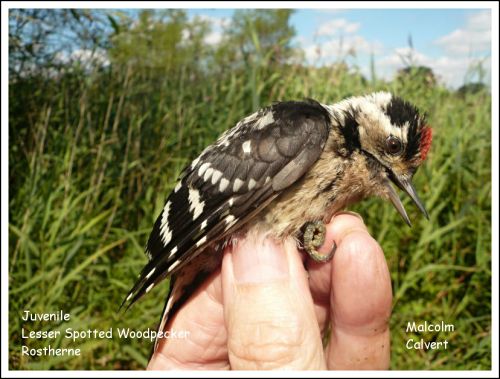 return from tropical west Africa through the vagaries of weather and avoiding predators and renew their membership of the breeding population. The great advantage of a long term study – mine started in August 1972 – is it provides the scope for identifying these intrepid creatures.
return from tropical west Africa through the vagaries of weather and avoiding predators and renew their membership of the breeding population. The great advantage of a long term study – mine started in August 1972 – is it provides the scope for identifying these intrepid creatures.The oldest known Reed Warbler was a bird at Peterborough, ringed as adult Male (at least one year old) in July 1988 and last encountered in July 2001. This bird must have been at least 14 years old.
I ringed an adult Male at Rostherne on 22 May 2004 and last netted him on 19 June 2016 – a bird of at least 13 years and the 3rd oldest known anywhere (It was handled 17 times over 8 seasons ) One which I ringed as a nesting in 1993 was last trapped in 2004. Birds bred in 2010 and 2012 survived to return 10 years later.
Something rather different: I caught and ringed a juvenile Lesser Spotted Woodpecker on 10 August – the first such ringing on the reserve for 24 years.
I thought this might be of interest to your avid readership.
Best Wishes.......Malc
Great stuff - many thanks Malcolm! Last year during celebrations to mark the 60th anniversary of the opening of the Rostherne reserve, Malcolm was presented with a painting by the well-known artist Ray Scally in recognition of the 50 years he's spent ringing the reserve's birds, especially the Reed Warblers. I also notice that his 2005 book "Reed Warblers at Rostherne Mere" is still available online; at a very reasonable price!
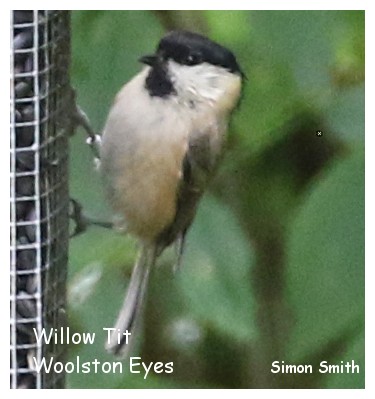 On Wednesday (16/8) a small group of mid-weekers travelled over to Warrington's Woolston Eyes reserve for a mornings birding. 17 broods of Black-necked Grebes have been recorded this year at Woolston but most have moved on. We saw none, but we confined our visit to number 3 bed and I believe that some still remain elsewhere on the reserve.
On Wednesday (16/8) a small group of mid-weekers travelled over to Warrington's Woolston Eyes reserve for a mornings birding. 17 broods of Black-necked Grebes have been recorded this year at Woolston but most have moved on. We saw none, but we confined our visit to number 3 bed and I believe that some still remain elsewhere on the reserve.As expected most of the remaining wildfowl were still in eclipse plumage, Gadwall appeared to be the most numerous but we also managed to pick out Mallard, Tufted Duck, Shelduck, Shoveler, Teal and a lone Wigeon. Of the passerines Chiffchaffs were the most numerous and could be heard calling throughout the morning. Apart from a short burst from a Cetti's Warbler the only other song came from a single Chiffchaff.
The well-stocked feeders outside the Morgan hide were attracting quiet a few visitors, mainly families of Greenfinch and Blue Tit but we were delighted when a Willow Tit appeared for a few minutes, unfortunately it was just a bit too quick for our cameras, although Simon did manage the record shot you can see here.
After a mid-morning break we continued around number 3 bed. A lone Swallow was the only hirundine all morning; no Swifts either but, from the Warrington Rotary, hide we had a tantalising view, lasting all of three seconds, of a small bird scuttling along the mud from a clump of grass into the reeds - even Simon didn't catch that one on camera!
After much deliberation we decided that it was a juvenile Water rail.
Wendy Stratford saw the only Kingfisher of the morning as she returned to her car and Bob Groom (who else) a Hobby from the Morgan hide, after we'd left. Species #40 for the day list, not bad for the time of year.
Species recorded at Woolston Eyes. Wednesday 16th August 2023 |
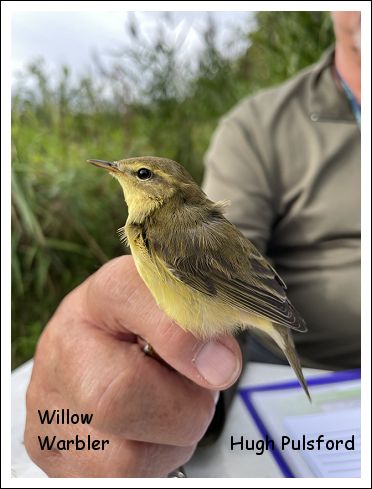 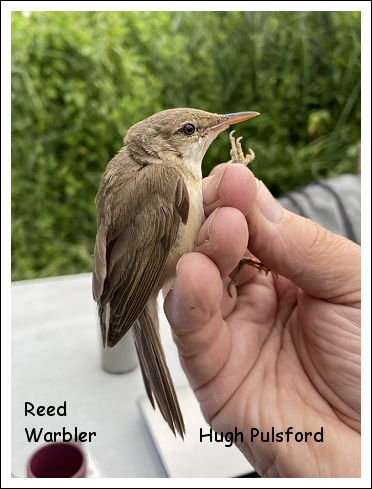 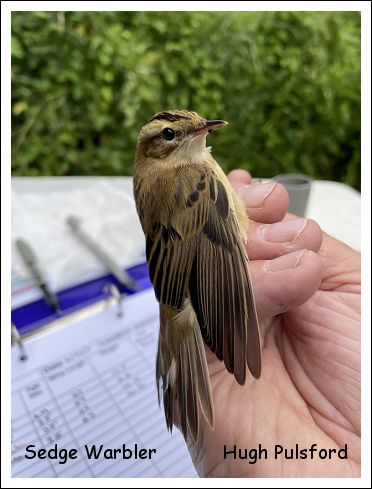 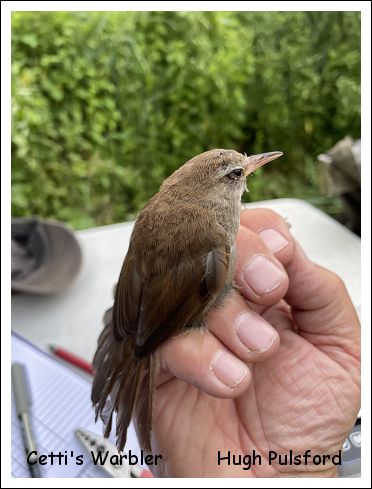 |
Last Tuesday (8/8) I walked from home to Mobberley's Gleavehouse Pool, hoping that the Black-bellied Whistling Duck family was still around. They weren't and the pool was deserted, in fact, apart from good numbers of Swallows and House martins at Blackthorn Farm, there was very little avian activity all morning.
We had more luck the following day (9/8) during a mid-week visit to the RSPB's Burton Mere Wetland Centre. Nothing out of the ordinary from the reception building - wildfowl in the form of Canada and Greylag Geese, Shoveler, Gadwall, Teal, Mallard, Coot and Moorhen whilst waders were represented by Black-tailed Godwits, Lapwing, Redshank, Snipe, numerous Ruff and a single Avocet.
As usual we found the Marsh Covert hide quiet but on the walk down we'd had a quick snatch of song from a Cetti's Warbler and a Reed Warbler gave a passable imitation of a Spotted Flycatcher as it perched of an overhanging stem of phragmites reed before darting into the air to skillfully take passing insects on the wing.
Pausing briefly at the viewing screen on the way to the Border Hide Little Egret and Wigeon were added to the day-list whilst from the hide itself we had good views of the massed ranks of waders as we enjoyed elevenses. We had hoped to try the new cafe - it's complete but they're still trying to find a "food and beverages manager". I did suggest that they take a couple of the staff from the Parkgate chippie on secondment - they'd have it running like clockwork in a couple of days.
47 species for the morning; we've had more in the past but at this time of the year, with wildfowl in eclipse plumage and passerines keeping a low profile, a commendable effort.
 |
No shortage of passerines for Hugh Pulsford and his ringing team on Knutsford Moor! Hugh kindly sent me an account of their recent activities and the stunning images you can see at the start of this update .........
" At this time of year, juvenile/1Calender year or fledged birds are out and about in numbers. They are often more visible than adults and tame
Firstly its been a good year for warbler breeding.. A dry, warm May helped fledgling success and a dry June ensured good insects to get them started once they had left their nests. A damp July has kept good invertebrate numbers up.
I will call them juvs as they are still in juvenile plumage. all are undergoing a post fledging moult, of feathering over/growing feathers on their bare underparts. They don't moult their main flight feathers or tails. Adults will ( mostly) undergo a complete moult of all their feathers, but not Acro warblers.
The Reed warbler shows a classic set of neat feathers, with minimal abrasion at the edges. Juv feathers are more translucent and weaker than adults, after all it only had c16 days to grow the lot! But an adult Reed Warbler is still wearing its feathers from its post breeding moult in Africa in February this year, and will not change/moult them till after it arrives on its wintering grounds. So an adult has heavily abraded and chipped edges to its tail and all its flight feathers, and washed out/bleached base colours and will not appear as brown as a juv bird. Seems a strange biological strategy to make your main southerly migration with a set of clothing you put on 10 months before and after you have gone through the stress of raising a brood or two, but that's bird biology for you!
Note some birds still show a gape line at the base of the bill. For us ringers we have a fail safe way to age such birds as all Acrocephalus warblers ( and Locustella too) retain tongue spots till about December. Adults don't have them.
the juv Cetti's is a recently Fledged bird and appears some what tatty and has a noticeable gape still showing. It also appear "fluffy" underneath again a classic sign of a juv bird. Adult feathers are sleek and well organised. When we caught this bird it had probably only been a couple of weeks out of its nest.
the Willow Warbler, is a little gem. Juvs are so lemon yellow they look like dipped in custard! These birds now have finished their post juvenile moult and will look like this till February ( not that we see WW in Feb!) Note the fluffy under tail coverts, again a juv feature. Remember an adult will have finished its post breeding complete moult of every thing and will look the field guides. Pristine, sleek, yellowish to the underparts, white throat and ready for the long haul south.
I really like Sedge Warblers. At least 5 pairs bred at Knutsford Moor this year. They are a little different in that adults and juvs do a partial moult before leaving the UK, so they are difficult to tell apart,(but juvs have tongue spots) although a juv looks very well marked, dark centres to many feathers, tiger stripped with dark centres to the tertials, crown and coverts in particular, (hence folks claiming Aquatic Warblers down south) whilst an adult ( again still wearing its plumaged moulted in February) will appear pale and washed out.
For info, 7 ringing sessions from early July trapped Reed Warblers, 11 adult and 55 juvs, Sedge Warblers, 6 Adults & 5 juvs, Cetti's, 1 Ad, 1 juv, with 34 Chiffchaffs and 12 Willow warblers so far. Now it is clearly migrant birds moving onto the reed bed to feed up, rather than local breeders. August is when the Willow Warblers and Tree Pipits move through, September for the Chiffchaffs and Grey Wagtails move south so we are hoping expectantly . Whilst catching only 6 Reed Buntings so far suggests they might not have done that well locally, however talking with the locals, they have bird feeders in their gardens so suspect they have moved off the reedbed. ".............
Thanks Hugh - some real ornithology! Keep up the good work.
Species recorded at Burton Mere Wetlands on Wednesday 9th August 2023 |
 |
Having mowed the lawns - front, back and next-door's
 I set about the privet hedge but was interrupted by a message on the Rostherne Mere WhatsApp group with news of a Marsh Harrier on the reserve followed, a short time later, by a second alert - 20 Common Scoters on the mere, so I downed-tools and made my way over hoping that neither species had moved on. The Harrier wasn't to be seen but the Scoters were still there. Of the 20, 8 were adult males, the remaining 12 could be separated into two - 7 with well defined white cheeks and 5 with less prominent markings. Perhaps adult females and juveniles. Phil Dell managed a record shot through his telescope (see above) which shows the distribution of plumages. Presumably they were birds that had bred in northern Scandinavia or even Russia and were making their way to wintering quarters in the Irish Sea; they'd moved on by the following morning.
I set about the privet hedge but was interrupted by a message on the Rostherne Mere WhatsApp group with news of a Marsh Harrier on the reserve followed, a short time later, by a second alert - 20 Common Scoters on the mere, so I downed-tools and made my way over hoping that neither species had moved on. The Harrier wasn't to be seen but the Scoters were still there. Of the 20, 8 were adult males, the remaining 12 could be separated into two - 7 with well defined white cheeks and 5 with less prominent markings. Perhaps adult females and juveniles. Phil Dell managed a record shot through his telescope (see above) which shows the distribution of plumages. Presumably they were birds that had bred in northern Scandinavia or even Russia and were making their way to wintering quarters in the Irish Sea; they'd moved on by the following morning.Earlier in the week (31/7) Jude Halman and I spent a couple of hours in the Rostherne obs. (Jude is one of a small group of volunteers who keep the observatory clean and tidy - [I helped as best I could by keeping out of the way!]) The juvenile Hobby had moved on but we did have four Kestrels, thought to be a female and three juveniles. A family of Blackcaps fed on elderberries (see photo) in front of the obs. but, apart from three Swifts passing quickly through, the reserve was very quiet.
On the same morning Tatton ranger, Darren Morris had three Common Terns over the main mere (this morning [7/8]) he reported a female Wheatear on the mere's concrete boat-launching jetty)
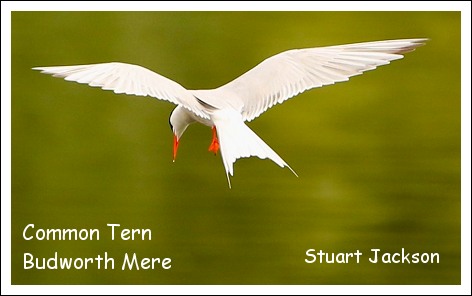 .
.Also this morning, and back at Rostherne, Derek Pike and I recorded two Common Terns quartering the mere, taking the occasional small fish - they remained for about half an hour before moving off in a southerly direction. Just a single male blackcap today and a family party of five Long-tailed Tits in front of the obs. Tufted Ducks are building up, we counted 55, a single Little Grebe lurked in the Harper's Bank reeds and a Great Crested Grebe (carrying a youngster on its back) was one of about 30 this morning.
It seems to be a good year for Terns as Bob discovered on Friday (4/8)........" Friday - Min 12C Max 18C, but a rather cold wind. Decided to go to Marbury and en route saw a Hobby on Tabley Road, just past the Cemetery. The highlight was no less than 7 graceful Common Terns dipping and wheeling over the water on Budworth Mere. Also scores of Swallows (and a few House Martins), lots of Great Crested Grebes, Kingfisher and an out-of-season Goldeneye (the roving bird) from the hide. Also Blackcap and Chiffchaff..
Today - Min 11C Max 15C - turned out to be a lot better than forecast, at least up to late afternoon. We went to Jodrell Bank to celebrate Elaine's birthday.
We were even able to picnic on a table next to the RT enclosure as the rain held off. Great views of 2 Peregrines, perched and flying. The immature spent long periods on the Big Dish itself, sometimes with the noticeably larger adult next to it. Buzzard drifted over the 'scope but there was no interaction. "..............
26th July 2023 ........ Evening walk around Whitegate.
Last Friday (21/7) was a day made for the couch potato; Stage 19 of a wonderful Tour de France, the Ashes test from Old Trafford and the Open Golf from Hoylake, with views across to Hilbre and the far side
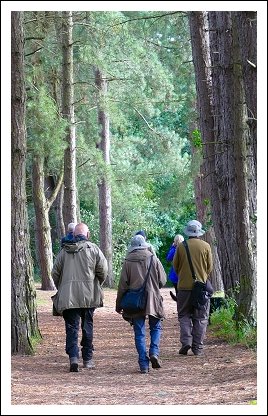 of the Dee estuary. On one occasion the camera zoomed in on the Point of Ayr lighthouse, clearly picking out people of the beach - incredible optical equipment; prices start at
£250,000!
of the Dee estuary. On one occasion the camera zoomed in on the Point of Ayr lighthouse, clearly picking out people of the beach - incredible optical equipment; prices start at
£250,000!
Fortunately the 21st was also the date of our third and final summer evening walk, so eventually I was obliged to step outside the front door. Jacquie Ledward was our leader for the walk, a 6Km stroll around Newchurch Common, close to the village of Whitegate. Our route first took us along a dusty track between two lakes, my map doesn't name them but they are definitely the domain of fishing enthusiasts with padlocked gates and strategically placed fishing stages around the perimeter. (Warrington Angling Association website names them as "Sandiway Big Lake" and "Sandiway Small Lake"). On the lakes - Little and Great Crested Grebes, Tufted Duck, Greylag Goose, Mute Swan, Grey Heron, Canada Goose, Coot and Moorhen whilst in the surrounding trees and vegetation Goldcrest and a Garden Warbler were the "best" birds. This looks to be a great place for Garden Warblers as there is an abundance of sallow (Salix cinerea) alongside the paths - I've always found this shrub attracts the species. Overhead good numbers of Swifts and hirundines - Bob Groom counted a flock of 25 Sand Martins. July is not the best time of year for birding so we did well to generate a list of 34 different species, perhaps a springtime visit is called for. Our thanks go to Jacquie for leading the walk and for her pre-visit recces.
Monday (24/7) found a small group of members once again in the obs at Rostherne Mere. It was a morning dominated by raptors, as well as the usual Buzzards we had three Kestrels (probably a female and two youngsters) and extended views of the immature Hobby that we'd seen last week. The bird perched in the mereside trees in front of the hide looking for prey, having identified something suitable, down it swooped before returning to devour it's unfortunate victim - most of the time they seemed to be small flying insects, taken on the wing by this little master of maneuverability.
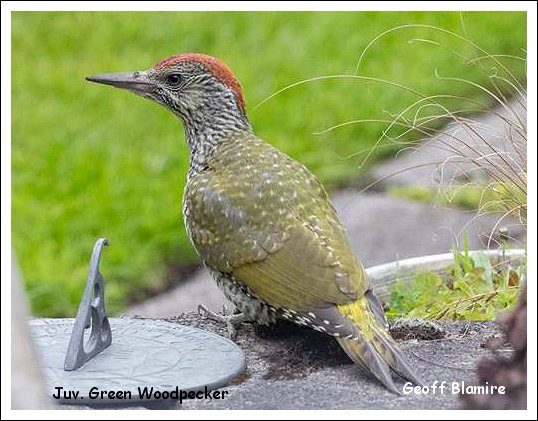 On the subject of young birds Geoff and Sheila Blamire are doing well in their garden this year ........."Because it was raining hard in the morning, and because we had a lot of things to do, we decided to go for our walk in the afternoon, leaving about 2pm when the sun started to shine. Before we left, I looked out of the kitchen window where there were 2 juvenile Carrion Crows ‘anting’ – very amusing, particularly when one had lay down with its wings and tail spread out over the ants while the second one was trying to get to the ants under the spread tail. Nothing much to report on our walk until we stopped by an enormous buddleia and decided to do the ‘Big Butterfly Count’ (https://bigbutterflycount.butterfly-conservation.org). It was difficult to count as the buddleia was ‘covered’ in butterflies. Min counts: 13 Red Admiral, 4 Comma, 3 Peacock, 3 Large White, 2 Small Tortoiseshell, 1 Meadow Brown and 1 Holly Blue. Walking back home, thinking of the crows, I was recalling the time when a Green Woodpecker was on the patio ‘anting’ – love to see that again! Geoff was first in the house and yelled at me to come quickly – there on the patio – a juvenile Green Woodpecker!!! Geoff managed to grab some photos, but then it flew to perch on the newly ‘pollarded’ conifer."............ Well done Geoff a great image!
On the subject of young birds Geoff and Sheila Blamire are doing well in their garden this year ........."Because it was raining hard in the morning, and because we had a lot of things to do, we decided to go for our walk in the afternoon, leaving about 2pm when the sun started to shine. Before we left, I looked out of the kitchen window where there were 2 juvenile Carrion Crows ‘anting’ – very amusing, particularly when one had lay down with its wings and tail spread out over the ants while the second one was trying to get to the ants under the spread tail. Nothing much to report on our walk until we stopped by an enormous buddleia and decided to do the ‘Big Butterfly Count’ (https://bigbutterflycount.butterfly-conservation.org). It was difficult to count as the buddleia was ‘covered’ in butterflies. Min counts: 13 Red Admiral, 4 Comma, 3 Peacock, 3 Large White, 2 Small Tortoiseshell, 1 Meadow Brown and 1 Holly Blue. Walking back home, thinking of the crows, I was recalling the time when a Green Woodpecker was on the patio ‘anting’ – love to see that again! Geoff was first in the house and yelled at me to come quickly – there on the patio – a juvenile Green Woodpecker!!! Geoff managed to grab some photos, but then it flew to perch on the newly ‘pollarded’ conifer."............ Well done Geoff a great image!News this week of an aborted attempt by Bee-eaters to nest somewhere if Greater Manchester!
This from the website of Rare Bird Alert ........."The pair first turned up at an undisclosed site in mid-June but news was withheld as it was felt that the site did not lend itself to public viewing, for risk of causing disturbance to the birds.
Discussions took place with staff from the RSPB who have previously been involved with setting up viewing at the breeding Bee-eaters at Trimingham in Norfolk. However, following their guidance it was decided that news would be suppressed completely.
Daytime nest watching and protection took place by a small team of local observers and it is believed that the first chick(s) likely hatched around the 13th July.
On Saturday 22nd July the Head of RSPB Investigations had intended to attend the site with the local observation team with a view to plan and potentially implement some form of public viewing once it was believed all the chicks had hatched and were near to fledging.
However the adult birds departed the site on 20th July. It is thought the nest failed possibly due to predation or some form of internal collapse of the nest burrow.
This represents the first breeding attempt for Bee-eaters in Great Manchester and adds the growing list of sites where these enigmatic birds have bred or attempted to breed – where next?".........
Our next KOS get together will be on September 9th when we'll be visiting Woolston Eyes - the start of a new season which will see our little society celebrating our 50th anniversary!!
Species recorded on the evening walk around Newchurch Common - Friday 21 July 2023. |
Pink-footed Geese arrive back in Britain to winter with us towards the end of September. Their first port of call after leaving their breeding grounds in Iceland, and to a lesser extent Greenland, is the Lancashire coast around Southport. From there many move south-east to Norfolk, normally at the end of October and on through November, before doing the return journey in March. Their route to Norfolk often entails using the "Cheshire gap" as it provides a passage between the Clwydian Hills in Wales on the one hand and the Peak District and South Pennines on the other.
I remember one November morning, many years ago, when cycling to work (so it must have been many years ago!) stopping to watch two pinkfeet heading roughly south-east, their flight was erratic and they appeared to be struggling to decide which direction they should be taking. A few minutes later a substantial flock of c.300 appeared - as straight as a die with no deviation as they headed for Norfolk.
I've always considered this as a good example of "Wisdom of the crowd" in the animal, rather than the human world. From Wikipedia .........."The wisdom of the crowd is the collective opinion of a diverse independent group of individuals rather than that of a single expert. An explanation for this phenomenon is that there is idiosyncratic noise associated with each individual judgment, and taking the average over a large number of responses will go some way toward canceling the effect of this noise"...........
I've been wondering if another example is the spread of certain species, of mainly water birds, northwards from their traditional homes around the Mediterranean - Little Egret, Great White Egret, Cattle Egret, Spoonbill, Black-winged Stilt, Cetti's Warbler etc but, with the temperature in these areas currently heading towards 50⁰C, I suspect there is a much more obvious reason!
The current position of the jet stream that's causing these extreme temperatures in southern Europe means we've lost the warm weather
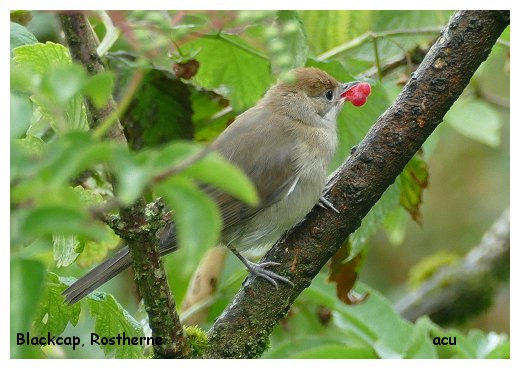 we enjoyed in June and had to contend with a succession of low pressure areas, rolling in over the Atlantic, bringing with them unseasonably high winds and heavy rain. As I set off for Rostherne Mere on Monday morning it was warm and sunny but by the time I reached Ashley, the heavens had opened and we had to contend with a downpour of biblical proportions! It was short-lived however and the rest of the morning was pleasantly warm and I was joined by Geoff and Sheila Blamire and Derek Pike, on a rare visit to the reserve's observatory. There was no sign of the previous day's Black-necked Grebe and Common Terns but we were more than satisfied with prolonged views of a juvenile Hobby that perched in full view, swooping down from time to time as it spotted a dragonfly below. Great Crested Grebe and Tufted Duck flocks are increasing and a few Mandarin Ducks floated on the mere. Last weekend during the monthly wildfowl count no less than 85 Mandarins were counted - and I thought I'd done well with three on Pedley Brook in Mobberley! The bird table was quiet but, alongside, two juvenile Blackcaps fed on honeysuckle berries.
we enjoyed in June and had to contend with a succession of low pressure areas, rolling in over the Atlantic, bringing with them unseasonably high winds and heavy rain. As I set off for Rostherne Mere on Monday morning it was warm and sunny but by the time I reached Ashley, the heavens had opened and we had to contend with a downpour of biblical proportions! It was short-lived however and the rest of the morning was pleasantly warm and I was joined by Geoff and Sheila Blamire and Derek Pike, on a rare visit to the reserve's observatory. There was no sign of the previous day's Black-necked Grebe and Common Terns but we were more than satisfied with prolonged views of a juvenile Hobby that perched in full view, swooping down from time to time as it spotted a dragonfly below. Great Crested Grebe and Tufted Duck flocks are increasing and a few Mandarin Ducks floated on the mere. Last weekend during the monthly wildfowl count no less than 85 Mandarins were counted - and I thought I'd done well with three on Pedley Brook in Mobberley! The bird table was quiet but, alongside, two juvenile Blackcaps fed on honeysuckle berries. Bob Groom arrived after we'd left and missed his favourite bird; the previous day he'd completed his monthly wildfowl count at Tabley Mere........."Yesterday (Min 13C Max 18C) I did my Tabley count. July is often a quiet count month but there was a surprise, no less than 240 Coot, a count I wouldn't normally get until autumn. Pair of Great Crested Grebes had one well grown juvenile. Half-a-dozen Mandarins (no male) indicated breeding. Two pairs of Mute Swans, five cygnets with the resident pair. Scores of Swifts over the mere were presumably on the move. With the rain a party of House Martins came down. Buzzard the only raptor."...........
Later on Monday Bob reported an unusual sighting on one of his local patches ........"Earlier this evening, my neighbour Glynn's son Will was running on the Bridleway when he spotted and was able to photograph an owl, flying and sat on a traffic cone https://www.youtube.com/shorts/Yg0ZSS-4tIA! Amazingly it seems to be a long-eared owl, out in broad daylight. Does everyone agree on the ID? Glynn and I went over there and spent an hour looking but i unfortunately it had disappeared. We did have some consolation prizes - Hobby, Raven, Buzzard, Song Thrush, Linnets and a Hare!"............ looks good to me Bob. Preliminary investigations at the nearby Gauntlet Bird of Prey Center indicate that none of their birds is missing.
On Friday (21/7) it's the third and last of our Summer evening outings when Jacquie Ledward will be leading us on a walk around Whitegate near Northwich. All members have been given directions.
12th July 2023 ........ The trip to Old Moor
 |
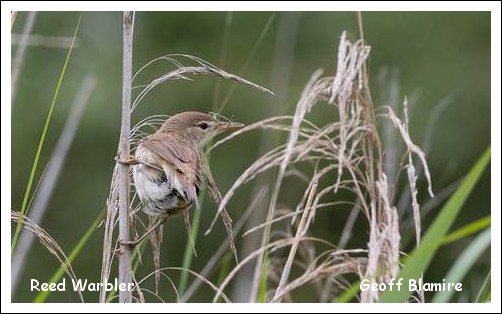 the equivalent of approximately 500 meters and there were lots of them as we approached the reserve. Fortunately our destination was well signposted but the journey still took us more than 1½ hours, although, it must be said, others found it an easy drive! So we were a bit stressed on our arrival, even more so when we learnt that a Peregrine that had been perched high up on an electricity pylon in full view from the car park had just left, never to return!
the equivalent of approximately 500 meters and there were lots of them as we approached the reserve. Fortunately our destination was well signposted but the journey still took us more than 1½ hours, although, it must be said, others found it an easy drive! So we were a bit stressed on our arrival, even more so when we learnt that a Peregrine that had been perched high up on an electricity pylon in full view from the car park had just left, never to return!However there was plenty more to see, as the ladies staffing the reception kiosk indicated whilst handing us reserve maps and pointing us in the appropriate direction.
It's not a big reserve, the furthest hide is only a 15' walk from the reception buildings and the paths seem to be wheelchair friendly, making for easy walking. To begin with we made our way to the Bittern hide, along the way singing Chiffchaffs and a short burst from a Reed Warbler, Geoff managed nice shot of one of the warblers (left).
Both Marsh Harriers and Bitterns have nested on the reserve this year, we saw three Marsh harriers in flight, thought to have been a female and two juveniles, although for the uninitiated they are difficult to tell apart. A Bittern gave excellent views as it flew low over the reedbeds but this was the only sighting of the species and missed by some members of the party - much to their annoyance!
Next it was on to the Field pool west hide where Oystercatcher and Little Grebe were added to the growing daylist plus Common Tern; three individuals were watched fishing over the pool.
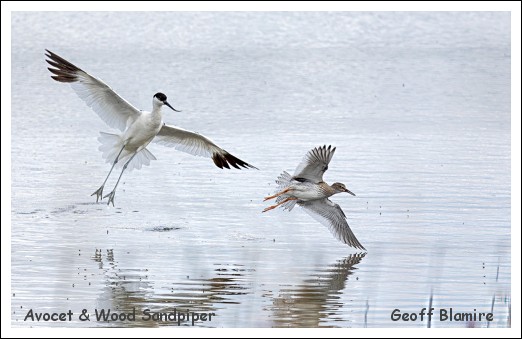 The Wrath Ings hide is a substantial affair, I imagine it would hold 40 birders comfortably and it was here we enjoyed lunchtime butties. Little and Great White Egrets were present, together with Common Sandpiper, Redshank, Gadwall and Shoveler but the "best" bird was a Wood Sandpiper that a lady at the far end of the hide had seen flying in, it's white rump was prominent and, through the finder's Swarovski 'scope, the yellow legs were plain to see despite the distance involved.
The Wrath Ings hide is a substantial affair, I imagine it would hold 40 birders comfortably and it was here we enjoyed lunchtime butties. Little and Great White Egrets were present, together with Common Sandpiper, Redshank, Gadwall and Shoveler but the "best" bird was a Wood Sandpiper that a lady at the far end of the hide had seen flying in, it's white rump was prominent and, through the finder's Swarovski 'scope, the yellow legs were plain to see despite the distance involved.Returning to the reception centre and availing ourselves of the facilities trip leader Karina recommended a drive over to the Adwick Washlands RSPB reserve, it came as no surprise that when we asked the RSPB staff for directions we were told - left out of the gate, drive for seven roundabouts and turn left, then first left after one more roundabout - no problems!
After a short walk from the car park we came to the first stretch of water and were immediately able to add Shelduck, Avocet and Black-winged Stilt to the list. The Stilts are having a "good" year in Britain but this is thought to be because they are being forced to move north from the Mediterranean due to droughts in southern Europe drying up their preferred wetlands, especially in the Iberian peninsula. The pair we saw at Frampton Marsh as we returned from the Norfolk trip last month were one of two, both successfully hatched chicks. Some of the party moved further on and this is where Geoff captured the cracking image you can see on the right showing an Avocet dealing aggressively with an encroaching Wood Sandpiper! Brian found us a Sedge Warbler lurking in the reeds - species number 60 for the day. Another successful outing to an excellent reserve, our thanks go the Karina for suggesting the venue and leading the trip!
I spent yesterday morning in the obs. at Rostherne Mere in the agreeable company of Jude Halman and Bob Groom. Rostherne's always quiet at this time of the year, previously nesting Hobbies have provided the main interest but they're not around this year........." We (TU, Jude & I) did a stint at the Observatory. It was pretty quiet but did manage some log entries. The most notable thing was a preponderance of Swifts (c.50), possibly on migration but certainly on the move in groups of varying size. we did see a Kingfisher and male Great Spotted and briefly a possible Hobby but visibility was very poor. Buzzard the only other raptor. No sign of any bees now and only a few butterflies with th showers. The uncertain weather continues on Wednesday but we are promised a better day on Thursday, according to the Met Office's latest forecast.."............. The constant passage of Swifts during a July morning is a reminder that nature never stands still, the returning Wood Sandpipers at Old Moor being another good example.
Species recorded on the KOS trip to Old Moor 9th July 2023. |
 |
Last Thursday (27/6) I walked from home in search of the family of Black-bellied Whistling Ducks seen on the previous Friday by Bob Groom as he made his way home after our Friday evening walk around the fields of Mobberley.
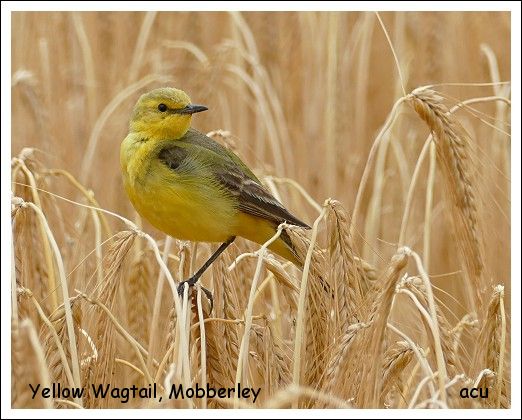 On reaching Gleavehouse Pool there was no sign of them but they were a few yards away on the small pond adjacent to the larger stretch of water. I suspect this is where they bred, perhaps in a cavity amongst the tree roots, the same place as the Shelducks that were successful last year. The two species like the same sort of nest site. Could they eventually become as common as other introduced species such as Ring-necked Parakeet, Canada Goose, Egyptian Goose, Mandarin Duck and Little Owl?
On reaching Gleavehouse Pool there was no sign of them but they were a few yards away on the small pond adjacent to the larger stretch of water. I suspect this is where they bred, perhaps in a cavity amongst the tree roots, the same place as the Shelducks that were successful last year. The two species like the same sort of nest site. Could they eventually become as common as other introduced species such as Ring-necked Parakeet, Canada Goose, Egyptian Goose, Mandarin Duck and Little Owl?Re-tracing my steps I had a close encounter with a pair of Yellow Wagtails, my budget camera likes close encounters! One of the birds allowed me to approach to within a few yards as I walked on the footpath through the healthy looking barley crop and obtain the image on the left; It's almost certain that they had youngsters somewhere in the vicinity.
More breeding success at Jodrell Bank where a pair of Peregrine Falcons have reared at least one young bird on the world-famous radio telescope. Bob Groom was over there on Sunday (2/7)........" Wonderful views of the Peregrines throughout our visit, flying round together or perched on the radio telescope where they have nested. Just before leaving we had three birds flying together so there is at least one fledged young. What a treat to see them in this special place! We managed to show them to some of the reception counter staff. The wind was, however, rather too strong, making it difficult to use the spotting 'scope."...........
Hugh Pulsford and his team are again ringing on Knutsford Moor where they've confirmed that Cetti's Warblers have bred ........"I thought you might like to let the KOS folks know that, ringing in Knutsford Moor, I have caught a female Cetti's Warbler and a juvenile in the last couple of weeks, confirming breeding in that area. In addition there are at least 5 pairs of Sedge Warblers breeding in there as well."........... Thanks Hugh, members have had Sedge Warblers in song at Rostherne, both on the reserve and at Ciceley Mill but none from the Moor - it just goes to show how thinly our resources are spread!
Geoff and Sheila Blamire are providing lots of good records for BirdTrack on their daily walks this year!........"A brief Yellowhammer at Plumley but after we walked over the railway level crossing we had 1m, then after 3+ Yellowhammers, then another 1 alarm calling along the Holford track (leading to the Inovyn offices). I saw a weasel - perhaps that was the cause rather than us? Several Linnets there as well.
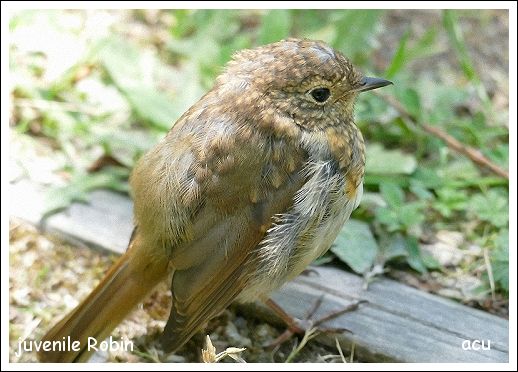 We had a Skylark the Plumley side of the railway, then another singing along the Holford track. Supporting cast of singing Willow Warbler, Whitethroats, Blackcaps, Chiffchaffs, Reed Buntings and Buzzards (not singing!), etc. 2-3 parties of Swallows. Quite a few butterflies including Ringlets and Gatekeepers.(3/7) "............
We had a Skylark the Plumley side of the railway, then another singing along the Holford track. Supporting cast of singing Willow Warbler, Whitethroats, Blackcaps, Chiffchaffs, Reed Buntings and Buzzards (not singing!), etc. 2-3 parties of Swallows. Quite a few butterflies including Ringlets and Gatekeepers.(3/7) "............On the same day (3/7) that G&S were in Plumley, Olwen and I were driving through torrential rain along the A55 to Llandudno for a few days away, celebrating our (**nd) wedding anniversary! Fortunately the rain abated, the sun appeared and for the rest of the three days we enjoyed some lovely warm weather. Of course, given the circumstances, this wasn't to be a birding trip - nevertheless we did mange to fit in trips to RSPB Conwy, the Great Orme and Anglesey's South Stack - just for a quick coffee you understand! The extended cafe at Conwy is now open again - it's much bigger and very functional but we were disappointed to find the big leather sofas that gave the original cafe a bit of character hadn't been incorporated in the new setup. I wandered down to the nearest hide where I was joined by a young Robin; as it approached I took a series of record shots but eventually it hopped right up to me and posed nest to my left foot - the camera liked that!
We stayed at the Senarth Guest House, right in the centre of Llandudno. The owner is an interesting chap, having been born in Uganda he familiarised himself with the birds of central Africa before the family was forced, by Idi Amin, to leave the country. Eventually he and his wife moved to nearby Colwyn Bay before, much to his surprise, he's found himself running a guest house in Llandudno! It's an excellent location for birdwatchers - 10' walk to the start of the Marine Drive, a 10' drive to Conwy, 20' to Llanfairfechan and less that an hour to South Stack. We stayed for three nights and saved over £100 when compared to Llandudno's Premier Inn - highly recommended!
Sheelagh Halsey has kindly sent me a copy of Bill Bellamy's latest Rostherne Mere quarterly review - you can read it here.
On Sunday it's our KOS July trip to the RSPB's Old Moor reserve in Yorkshire. This is our first visit for many years to this excellent location. 10am at the reserve - leader Karina Stanley.
27th June 2023 ....... The Mobberley evening walk.
 |
Despite dire predictions from the Met Office, on Friday (23/6) a band of 13 stalwarts met up on Mill Lane in Mobberley for the second of our three Summer evening walks. As is so often the case the forecast was wrong and we completed the 5.96Km (3.7miles) around some unfrequented parts of the village
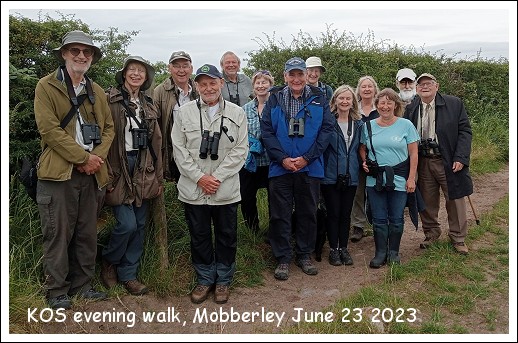 in almost completely dry conditions.
in almost completely dry conditions.After the best part of a month with no rain and lots of sunshine our group looked to be in tip-top condition, especially the three who'd recently gone beyond the call of duty! One had walked the whole of the 182 mile coast to coast route in the steps of Alfred Wainwright; a second had spent three weeks hill walking in the Welsh mountains whilst the third had, earlier in the week, climbed the Lake District's Blencathra mountain via Sharp Edge. I'm told most enthusiasts consider that taking this route once is more than enough!
We took the path at the top of the lane towards Gleavehouse Pool through fields of ripening barley and row upon row of recently planted maize that seems to be benefiting from the warm weather, mixed with heavy showers of rain. We were hoping for Yellow Wagtails and two overflying birds provided a "tick" but no decent views. A pair of Yellowhammers were the first I've seen in this area this Summer, there was no evidence of breeding but there's time yet - I once found a nest with eggs in mid-August. Good numbers of Swallows, including young birds, were feeding over the barley - I counted 18 in view at one stage.
At the pool Mallards and Coots with young and, as earlier in the week, Lapwings were warning their small chicks about our intrusion; we saw two youngsters.
Moving on we crossed Pedley Brook and headed up towards Wayne's World; Bob Groom took a different route home but had good views of a Yellow Wagtail and a remarkable record from the pool we'd just left!......."last night I got a surprise passing the Gleavehouse Pool again. A pair of Black-bellied Whistling Ducks appeared, with a dozen 'humbugs', while a third adult flew round calling! On the way back a Raven flew past and a male Yellow Wagtail perched nicely on the hedge for me. ".........Nice one Bob! Perhaps the B-bWD will eventually make its way onto the official British Bird List!
Following the footpath in a westerly direction, the newly excavated lake had two Oystercatchers and another pair of Lapwings with two small chicks, another late brood. The field of wheat leading towards Springwood Farm was quiet and it appears that the family of Yellow Wagtails I'd seen earlier in the week had moved on. The farm is now a commercial venture with car repair facilities and there are no animals - so no Swallows and the Spotted Flycatchers from a few years ago have gone elsewhere.
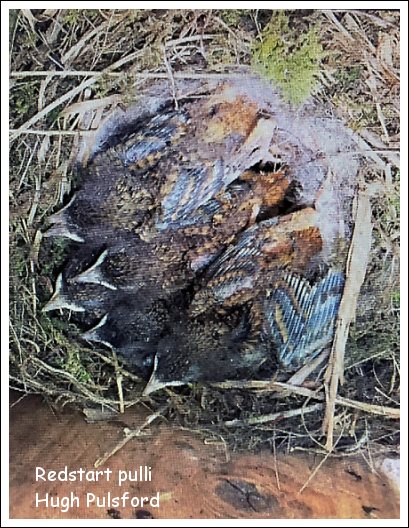
A different story though at the new Blackthorn Farm equestrian centre, plenty of insects and the hirundines were much in evidence. The numerous House Martins are nesting inside a large open ended barn. Wendy Stratford notice this during the week ......"There was a buzzard over Pavement Lane, and 4 swallows and 4 house martins at the livery stables on GH Lane. Some of the martins were down by a puddle the other side of the road. I thought the martins were going into the barn as well, so walked back that way after going to the pool, and confirmed that they were! "......
Just a small muddy pool remains at Mobberley SQ and the only song came from a lone Reed Bunting giving us a total of 37 species for the evening, two more than during our last evening walk in June 2019.
Yesterday (25/6) Jude Halman and Brian Holmes worked up an appetite for their lunch at the "Bells of Peover" with a 12Km walk from home, picking up some good records on the way! ........."Yesterday 12 Kms from home to Lower Peover ( lunch at the Bells of Peover) 3 Yellowhammers, Grey wagtails with three young and Pied Wagtails with at least 6 with young "..........
Regardless of the coming Mobberley walk, on Friday morning (23/6) Geoff and Sheila Blamire were on their travels and again the following day (24/6).........."Friday: did Mere/Tabley walk – highlights: the second fishing pond on the left on Moss Lane we flushed a Tawny Owl, it flew at waist high right in front of us across the lane and flew into a small tree with the resulting alarms calls from Blackbirds and other birds. Green Lane on the right side Skylark singing and Swains Walk another Skylark singing.
Saturday: At Ciceley Mill Pool the Sedge Warbler was singing (on the way back as well). At Rostherne Obs the honey bees had moved to the front of the building (not advisable to open the window over the swarm!). Common Tern was around for 5 mins and successfully caught a fish. Also c6 Swifts over. "..........
On Friday evening we walked past a Barn Owl box containing three youngsters, they'd been ringed on Thursday by Hugh Pulsford who reports that the owls are having a good breeding season with an abundance of voles and wood mice.
I've yet to see a flycatcher this year - pied or spotted but Hugh seems to be having no trouble!....." It's been a good year for those monitoring Pied Flycatcher nest box sites on behalf of United Utilities and several private land owners across the North West..
Personally I have monitored 20 nest boxes with Pied Flycatchers in them at two sites. Two failed at egg stage, female almost certainly taken by Sparrowhawk, the remainder, hatched broods a bit later than usual, ie late May, but the calm weather clearly produced loads of insects larva in the tree canopies, plus flying adults. Over 80 pulli ringed at late stages and recent checks suggest they have fledged.
One brood of Redstarts, although clearly other pairs using natural sites, its always nice to see orange bums looking back at you when you open the box! "..........
Species recorded on the evening walk around Mobberley - Friday 23 June 2023. |
20th June 2023.
On Friday (23/6) it's the second of our three Summer evening walks, this time around the countryside in the south of Mobberley village. With this in mind, yesterday morning (19/6), I did a recce of the proposed route. This was my second recent visit, the first was pretty uninspiring but yesterday's was much more encouraging.
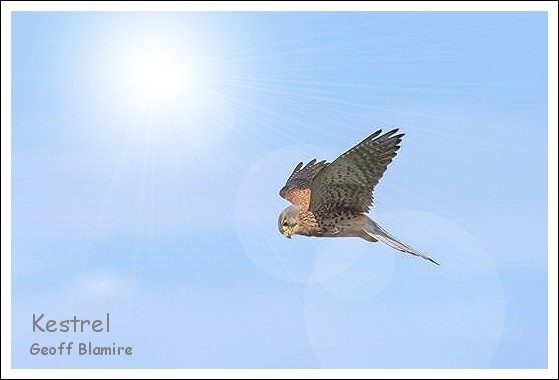 Walking from home, at Mobberley SQ (sand quarry) a Song Thrush was in top form, this must be the same bird I heard last year at the same spot, in full song from a small copse - a master of the art; quite superb.
Walking from home, at Mobberley SQ (sand quarry) a Song Thrush was in top form, this must be the same bird I heard last year at the same spot, in full song from a small copse - a master of the art; quite superb.I took the path running from the top of Mill Lane towards Gleavehouse Pool. Two Kestrels hovered over the top of a mature ash tree, they looked to be juvenile birds but difficult to see properly against the light.
A few yards further along a Yellow Wagtail called; I didn't see the bird but it was nice to know they're still there, having missed them on my last visit. At the pool three tiny Lapwing chicks picked flies from the mud along the margins, I assume they were the product of the parent birds second nest attempt, after having their first clutch of eggs destroyed during farming operations. They are late as, at this time of the year, other more successful families are starting to form post-breeding flocks.
Moving on I crossed Pedley Brook before walking up to the fence surrounding High Lake Manor, ancestral home of the Rooney family - always remember to give Wayne's security cameras an appropriate wave!
What was a small pool to the west has been considerably enlarged, perhaps to give the office staff in a converted farm building next to the footpath a more picturesque outlook. It looks good, a small flock of Canada Geese floated in the middle and two Oystercatchers rested on the bank. Over a stile and walking along the side of a wheat field I was delighted to come across two Yellow Wagtails; they weren't happy with my presence and seemed very agitated, calling from the top of the wheat stems, a perfect pose for my camera (which I'd left at home!!). I guess they'll still be there on Friday, as I know some KOS members haven't seen one yet this year.
Reaching the fishing pit a singing Lesser Whitethroat was unexpected, Peter Dawson had one here earlier in the year - perhaps they will have a second brood. Down again to Pedley Brook and as I stood on the bridge two well-grown young ducklings appeared from underneath, closely followed by one of their parents - a female Mandarin! This is exactly the same spot where Nigel Troup recorded a family party in 2004.
On Friday we will be meeting on Mill Lane, Mobberley - near the Roebuck Inn at 6:30pm. I'll be leading this walk which is c 5Km long and should take around 2½ hours. It would help if you let me know if you're coming along - tony.usher@zen.co.uk
The area covered yesterday was once a Yellowhammer stronghold but not anymore, it seems - I think the Blamires, G&S, have cornered the market! This from Sunday (18/6)........"Our walk this morning took in Plumley/Holford, parking near Keeper’s Cottage, through fields to the railway level crossing, short distance into the railway wood (our name for it!) until the brambles and biting insects were too much for us, then up Holford track, through the Inovyn offices, walking through meadows (not idea with hay fever!), then into the wood (needed a machete to force our way through the bracken!), ending up at Keeper’s Cottage. Phew! 3 different male Yellowhammers – 2 singing and 1 scruffy individual giving a contact call, and numerous Whitethroats, Chiffchaffs and Blackcaps. We spent some time watching 2 young Blue Tits feeding on hogweed flowers (see photo). But finished on a high – at the end of Keeper’s Cottage track I suddenly stopped – Lesser Whitethroat in the hedge on Cheadle Lane! We also had a Lesser Whitethroat on Friday in Millington."..........
And this from the following day........."Great 11km walk this morning taking in Mere and Millington. Here are the highlights….
Started with Little Mere where the Great Crested Grebes finally revealed that they have 3 chicks, 2 in the water and the third on the female’s back (now 8 days old), and the Reed Warbler was singing its heart out (Saturday 1 Egyptian Goose).
Then onto Chapel Lane and the bridleway: hunting male Kestrel, 1m Yellowhammer, singing Reed Bunting in rape field, singing Skylark and a family of Linnets. (last time we were there we watched a superb male Linnet in full song) – all within a few minutes!
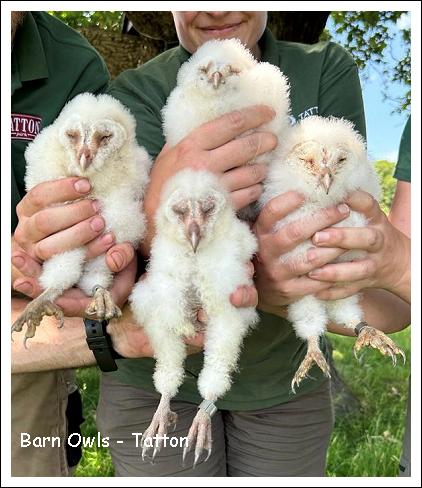 Millington Lane where 2 Skylarks were singing, 2 Yellowhammers chasing each other, rounded off with a young brown hare running down the lane, then turned round to run back because a car was driving down – it was only at the last minute (actually last second!) it saw us and jumped up through the hedge. What an experience.
Millington Lane where 2 Skylarks were singing, 2 Yellowhammers chasing each other, rounded off with a young brown hare running down the lane, then turned round to run back because a car was driving down – it was only at the last minute (actually last second!) it saw us and jumped up through the hedge. What an experience.Moss Lane: 1 pair Yellowhammers mating, 2 Whitethroats including male singing, Oystercatcher flew overhead calling.
Back to Chapel Lane: 8+ Swallows with 2 adults catching insects and feeding to the young lined up on the wire. "...........
Red Kites are again being reported from numerous Cheshire locations and Tatton Ranger Darren Morris makes a good point ........."We ringed 4 barn owls last week at Tatton with Sam (Roy) Leigh.
We were talking about red kites and how the habitat is perfect for them. The point being that they will move to more desirable areas. As opposed to their release sites.
Cheshire is beautiful!"........ It certainly is, Darren and it's about time we had some Red Kites nesting in the park.
Derek Pike intends to spend some time watching from a good view point in Tatton towards an area where local Mobberley residents have recently reported many sightings of Kites ........"Regarding the Red Kite photo Tony sent the other day with reports of Kites in the vicinity of Kell House Farm Mobberley. I have been doing a bit of research.
Kell House Farm is about 1400 meters, in a straight line, from Heidi’s seat in Tatton. The seat looks over the deer park and over to Kell House. Not far.
I believe Tatton have put a ban on dogs running loose and they have to have leads on until 31st July, because of disturbing the deer in peak breeding season.
There will be plenty of placentas in the deer park and maybe still born deer, good food for Red Kites.
I intend to spend a few hours on Heidi’s seat the next few weeks ".......... an excellent idea Derek, perhaps others may want to join you in a Red Kite vigil!
A swarm of bees curtailed activities for Bob and Elaine at Rostherne on Saturday (17/6)........"Anyone who had been thinking of visiting the Observatory tomorrow should definitely steer clear. Elaine and I had called at Cicely Mill Pool to check the dragon and damselflies. As anticipated they were much reduced in number, by at least 90%, otherwise not a lot - Jay, Swallows, Mute Swan.
Entering the Obs we saw all the honey bees and quickly curtailed our visit. Elaine videod a swarm of bees right next to the obs. We posted a warning on the door and started phoning from the top path. Birdwatching was clearly off the agenda. It transpired that Sheila and Geoff had already alerted Rupert, site manager (who apparently is also a beekeeper) when they had visited earlier. We carried on to Wood Bongs but all quiet.. Returning to the car, just a couple of Buzzards and a single Swift"............
A message today on the Rostherne WhatsApp group indicates that, after a short closure, the obs. has been re-opened but the bees are still present outside. so bee careful!
13th June 2023....... The trip to Burton Mere
 |
A dry but humid day for our June field trip over to the RSPB's Burton Mere Wetlands reserve (11/6), the temperature peaked at 27⁰ C during the afternoon as the current spell of hot weather continues.
At this time of the year a visit to Burton is characterised by the constant clamour of the Black-headed Gulls as they defend their territory against anyone or anything that strays too close; on this occasion it was augmented by the incessant crowing of the society's lone City fan after his well-oiled team's victory in Istanbul!
We
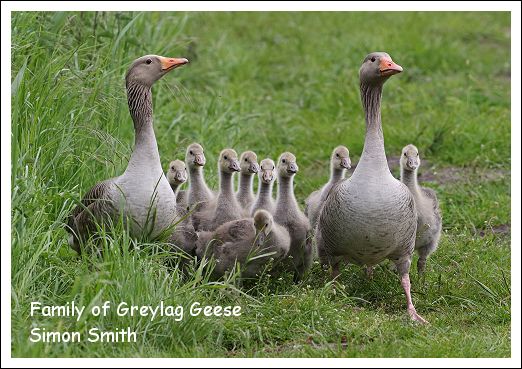 spent a considerable time in the reception centre, watching the comings and goings. A large flock of Black-tailed Godwits rested on the largest of the islands together with a group of Knot. A handful of both species showed traces of Summer plumage but the majority seemed to be in their grey non-breeding attire. This is a subject that is best left to the experts!
spent a considerable time in the reception centre, watching the comings and goings. A large flock of Black-tailed Godwits rested on the largest of the islands together with a group of Knot. A handful of both species showed traces of Summer plumage but the majority seemed to be in their grey non-breeding attire. This is a subject that is best left to the experts!Family parties of Coot, Shoveler and Greylag geese floated on the water and overhead Marsh Harriers hunted for food for their chicks, thought to be nesting somewhere out on the marsh.
Other species nesting on the reserve, but largely hidden from view, are the Grey Herons, Little Egrets, two pairs of Great White Egrets and, possibly, a pair of Cattle Egrets, whose success will only be confirmed if they appear with their offsprings out in the open.
Leaving the reception centre we made our way towards the Marsh Covert hide past the soon-to-be-opened cafe - it looks good and, in due course, will be a welcome addition to the facilities. Just a single singing Blackcap from the path but many Chiffchaffs and even more Cetti's Warblers - what a success story!
Not much to see from the Marsh Covert hide but, from the viewing screen, a little further on good views of two Ruddy Shelduck - handsome birds, well captured by Simon in his image reproduced here.
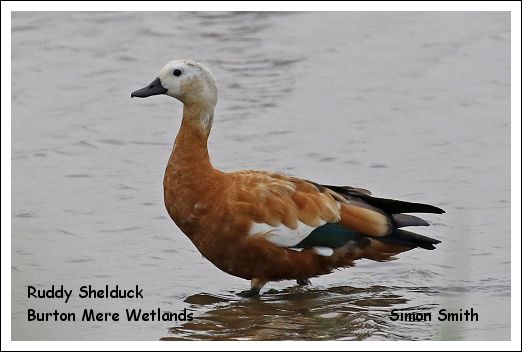
Moving on to the Inner Marsh hide, Reed and Sedge Warblers were still in song, the latter taking to the air in their characteristic song flight, as was a Whitethroat that demonstrated its enthusiasm in the same way, as we re-traced our steps later in the day.
Lunch was enjoyed in the Inner Marsh hide before we returned to the reception building for (in my case) a welcome cup of the RSPB's filter coffee before heading for home. We finished with a respectable tally of 59 species which, unusually, given the time of year, included only one Swallow but no Martins or Swifts (Now 64 species after receiving some late records [Peregrine, Little Gull, Little Ringed Plover et al.] from some of the party who had visited the Bunker hide).
Back in our corner of the county, Bob Groom was out and about the previous day (10/6) despite the soaring temperatures........."Peregrines are nesting in the radio telescope!!! Earlier we called at Acre Nook. Brief sighting of a Hobby. Loads of geese, Pochard, Wigeon etc. Today's Min 11C Max 29C Good job there was a cooling breeze or it would have been unbearable this afternoon. "............
Needless to say the Blamires, Geoff and Sheila, continue with their daily exertions and supply us (and BirdTrack) with comprehensive records from their favourite locations .........""Did our 13km Mere/Millington walk on Friday 9th June: singing Yellowhammer and Reed Bunting on Chapel Lane; singing
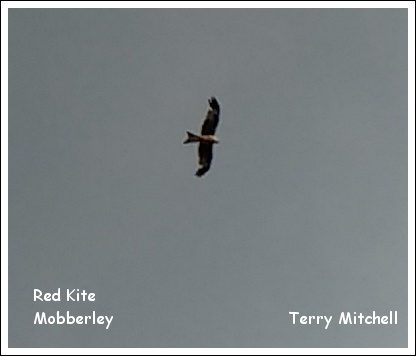 Yellowhammer on Peacock Lane plus 2 Swallows who displaced the Yellowhammer whilst hunting insects top of the tree and a weasel family crossed the lane; singing Yellowhammer and Whitethroat on Moss Lane; 2 singing Skylarks on Millington Lane, pair of Great Crested Grebes still incubating and pair of Egyptian Geese on Little Mere.
Yellowhammer on Peacock Lane plus 2 Swallows who displaced the Yellowhammer whilst hunting insects top of the tree and a weasel family crossed the lane; singing Yellowhammer and Whitethroat on Moss Lane; 2 singing Skylarks on Millington Lane, pair of Great Crested Grebes still incubating and pair of Egyptian Geese on Little Mere.Then did our 11km Mere/Rostherne walk on Saturday 10th June: singing Sedge Warbler, Cetti’s Warbler, Reed Bunting on Ciceley Mill Pool (despite presence of 2 anglers) and Coot still incubating and Mute Swan; singing Goldcrest and Treecreeper on Ciceley Mill Lane. Rostherne Obs was very quiet. ...........
The "Knutsford Nature Notes" Facebook group, set up by Olwen and me last September now has 99 members (will you be number 100?). From time to time it throws up some good records and this week a Mobberley member reported a long-staying Red Kite seen on a number of occasions over the north part of the village where it borders the private area of the Tatton estate. Plenty of woodland containing mature oak trees there, so you never know!
Our next KOS meeting will be on Friday 23rd June when we'll be enjoying the second of our three evening walks. The route will take us through some of the lesser known areas of Mobberley village. Meeting up at 6:30pm on Mill Lane, near the Roebuck Inn. I'll be leading this ramble, so please let me know if you're coming along. tony@10X50.com
Species recorded on the KOS trip to Burton mere Wetlands - 11th June 2023.Canada Goose,
Greylag Goose,
Mute Swan,
Egyptian Goose,
Shelduck,
Ruddy Shelduck,
Shoveler,
Gadwall,
Wigeon
Mallard,
Teal.
Tufted Duck,
Pheasant
Stock Dove,
Woodpigeon,
Moorhen,
Coot,
Oystercatcher,
Avocet,
Lapwing,
Little Ringed Plover,
Black-tailed Godwit,
Knot,
Redshank,
Black-headed Gull,
Little Gull,
Lesser Black-backed Gull,
Common Tern,
Grey Heron,
Great White Egret,
Little Egret,
Sparrowhawk,
Marsh Harrier,
Buzzard,
Great Spotted Woodpecker,
Green Woodpecker,
Peregrine,
Magpie,
Jackdaw,
Rook,
Carrion Crow
Raven,
Blue Tit,
Great Tit,
Skylark,
Swallow,
Cetti's Warbler,
Long-tailed Tit,
Willow Warbler,
Chiffchaff,
Sedge Warbler,
Reed Warbler,
Blackcap,
Whitethroat,
Wren,
Nuthatch,
Blackbird,
Robin,
Stonechat,
Dunnock,
Chaffinch,
Greenfinch,
Goldfinch,
Reed Bunting.
[ ✓ 64]
|
Swifts are one of the Summer migrants that have been a little behind this year. The first birds arrived right on time with two on the 29th April but since then numbers have increased only slowly. Better late than never though and I was pleased to count 12 Swifts over the Shaw Heath area of Knutsford over the weekend. With its 1930's houses, the estate offers plenty of spots under the eaves for the birds to nest.
Black Terns once nested in Britain in large colonies, but these disappeared as wetland areas were drained; it is now only an annual visitor from Europe but they do appear on passage in varying numbers. The easterly winds that have predominated over the past couple of weeks brought a number of records over the past few days. 21 were at Wigan's Pennington Flash on 31/5, three at Acre Nook SQ on the same day followed by one at Rostherne last Thursday (1/6). Bob Groom caught up with the terns at Acre Nook and also bagged his first Spotted Flycatcher of the year at the same time........."Paid a visit to Acre Nook today. As soon as I stepped out of the car I saw the Spotted Flycatcher, first of year for me. Very pleasant in the wood, female Great Spotted Woodpecker and a youngster making a continuous racket. Don't think the marauding jay would manage to predate a woodpecker.. At the viewing point there were still 2 Black Terns and they were quite reasonably close. Great. There is also a Black-Necked Grebe, refugee from Woolston Eyes? Usual Buzzards, Lapwings, Oystercatcher, also Raven and 2 Swifts"............
A Spotted Flycatcher was seen from the Rostherne obs. on Saturday (3/6), where Bob and I watched a distant Hobby catching insects on the wing on Monday morning (5/6). Phil Dell, one of the dedicated Rostherne volunteer wardens, watched a Tufted duck with 9 chicks on the mere this morning (7/6), this is the second year running that Tufties have nested at Rostherne, after a gap of 25 years.
So species that begin nesting early are showing signs of successful breeding. Grey Herons are among the earliest, with eggs being laid from February onwards, sometimes even earlier and fledged youngsters are appearing now at various local waters.
Our Mobberley Lapwings have had a hard time with modern
 Rostherne 17 June 2022 web.jpg) farming methods (previously mentioned in this part of the website) leading to the unintended destruction of nests containing their precious eggs.
farming methods (previously mentioned in this part of the website) leading to the unintended destruction of nests containing their precious eggs.Geoff and Sheila Blamire report a different scenario over at High Legh, a location they cover frequently on their daily walks ........."We found our another site for successful breeding Lapwings this time High Legh/Millington where we observed 6 adult Lapwings and at least 4 young chicks – the trouble was they were are a long way away and the maize plants obscured our vision. Which means - Mere: 2 pairs and at least 5 chicks (different ages); Rostherne: 6 adults and at least 13 chicks (different ages including couple very small ones); High Legh/Millington: 6 adults and at least 4 chicks; then High Legh 2 pairs but no sign of young but the wheat field is too high to see any Lapwings (this is where they were seen mobbing Pheasant to drive it off). Other sites we've seen regular Lapwings, including display, but no chicks. So far, we can't prove the chicks have/will fledge but no reason why not – fingers crossed!".............G&S also report the first juvenile Great Spotted Woodpecker in their Mere garden.
More good news from Bob, this time breeding success at Tabley ........" Taking advantage of the settled weather I brought forward my Tabley count and was delighted to see that the resident Mute Swans have bred after all, now accompanied by 5 young cygnets. I was a bit worried as there was another pair of adults present, which the resident cob seemed to ignore. Eventually there was some mild intimidation but I suspect he was being careful so as to avoid the youngsters getting injured in any confrontation. Two pairs of Great Crested Grebes with a little display but no sign of breeding. Two Oystercatchers racing back and to over the Mere, calling but not clear if a pair or rival males. Probably the latter. Two young Herons on nests and three adults at mereside. Just four migrant species - 2 Swallows, 1 Swift, Blackcap and Chiffchaff. Close Tree Creeper. Many Coot!".........
This coming Sunday (11th June) it's our KOS field trip to the RSPB's excellent reserve at Burton Mere Wetlands. I've been told that the new cafe is not yet open; so you may want to take butties, although I think some may have plans to move on to Parkgate and the chippie!
28th May 2023............ The trips to Norfolk and the Goyt Valley.
It doesn't serve any useful or scientific purpose but keeping an overall group tally of the species seen during a birding holiday or day trip does act as an effective "team builder" and, over the years, I've noticed that it does seem to add to peoples' enjoyment of our outings. We have a simple rule - any bird seen or heard by any member of the party - it's led to some interesting records of course but you'll remember the oft-quoted adage "it's only birdwatching no one dies".
So we set ourselves a target of 100 different species for the four day KOS trip to north Norfolk. We passed the ton with time to spare and finished with 114, perhaps we'll set a more challenging goal next time!
You can read the full trip report here http://www.10x50.com/norfolk_23.htm. It's worth a look, if only for the brilliant images produced by Colin and Simon and Geoff's videos.
It seemed we'd only had time to unpack and enjoy a cup of tea before we were off again! This time, on Friday evening (26/5) to the Goyt Valley on the first of our Friday evening walks.
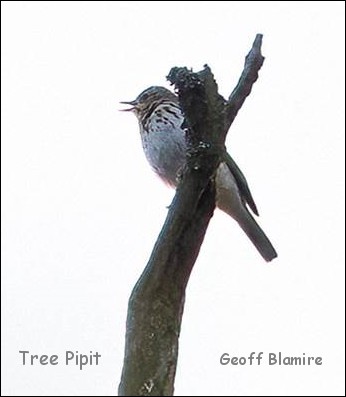
12 members met at the middle car park along the valley and took the usual route up the road in the direction of Derbyshire Bridge before returning along the top path overlooking the reservoir.
It was relatively quiet, the birds are, by now, well into the breeding season but there was some song, especially from Willow Warblers, they seem to be everywhere, quite a difference from down on the Cheshire plain. There is an explanation for their shift to cooler locations as climate change causes warmer Spring and Summers. Ex KOS member Mark Eddowes has done a lot of good work on the subject and will be explaining his findings on October 27th at the second of our Autumn indoor meetings - " Climate change impacts on passerine migrants: insight from citizen science data". I notice that Mark is now a member of the BOU council (I also noticed the photo used in his pen portrait was taken from this website. As I recall it was taken on a trip to RSPB Conwy!).
Back then to Friday; other Summer migrants recorded were Common Sandpiper, Blackcap, Chiffchaff and Cuckoo plus good views of a singing Tree Pipit that performed well from the top branches of an ash tree.
Family parties of Canada Geese and a nice male Mandarin floated on the reservoir and a little further up, on the River Goyt, Grey Wagtails flitted from stone to stone.
We were determined to wait for roding Woodcocks but had to wait until 9:45pm for the first one to appear. A bit late, unlike the International Space Station that passed silently over us, bang on time at 21:43 UTC!
Our next get together comes on Sunday 11th June when we'll be visiting the RSPB's Burton Mere Wetlands Reserve. 09:30 am in the car park. Our leader for the day will be Bob Groom, if you intend to go along please let him know before the day bobbluesgroom@hotmail.co.uk
Species recorded on the evening walk to the Goyt Valley - Friday 26th June 2023. |
Pleasant weather last Saturday (13/5) for our May KOS field trip to the Manifold Valley. It's a journey of about one hour from Knutsford, up past the Cat and Fiddle before picking up the A53, left turn at the "Winking Man" pub, down to Warslow and you're there.
En-route, from the car, we had Lapwing and Curlew; others spotted Stonechat, Short-eared Owl, House Martin and Wheatear - none of which were seen subsequently.
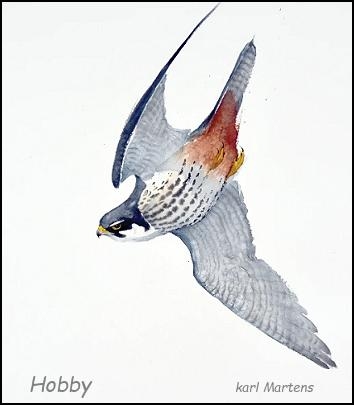 A group of 14 arrived at the Ecton car park and, right on time at 10am, set off on the circular route alongside the River Manifold.
A group of 14 arrived at the Ecton car park and, right on time at 10am, set off on the circular route alongside the River Manifold.Blackcaps and Chiffchaffs were in full song although this year there were fewer records of Garden Warbler and Willow Warbler than in the past. Also missing this year Pied and Spotted Flycatchers and just one singing Redstart. We lunched at the excellent Wetton Mill tearooms before returning to the cars along the path that runs alongside the east side of the river, picking up the Redstart and a single Whitethroat on the way. So, a bit disappointing on this occasion but the weather was kind to us and on the way home came the highlight of the day. We had a close encounter with two Hobbies that were feeding on insects over the heather moorland next to the narrow road leading from the A53 to the Cat and Fiddle. Superb views of the pair, close enough to see the red "trousers", Moustachial stripe and bold streaking on their breasts. One bird caught what we assumed was an early dragonfly which it devoured on the wing leaving the insects wings to flutter down to the ground.
Bob Groom was out and about again the following morning (14/5) doing his monthly WeBS count at Tabley mere ......." Taking advantage of the good weather I did my count at Tabley a.m. All was not well, however, three Mute Swans suggested no breeding, four Great Crested Grebes the same. {{No activity in the heronry. Don't think the Herons have had a good season.){ Blackcaps, Tree Creeper and a female Great Spotted Woodpecker hammering off bark (presumably not yet breeding). Reed Warbler going at it. I then visited Holford but had no luck. There well over an hour. Whitethroat and 2 Blackcaps singing. Another close Tree Creeper. Buzzard but no other raptor. A rather surprising absence of butterflies considering the warmth.
Three Swallows only. Two Swifts over Lilac Avenue the only ones seen all day.".......... I presume these were the Swifts reported by Derek Pike on the same day, the species continues to have a difficult time in Britain.
At the same time as Bob was doing his WeBS count I enjoyed a stroll on the west side of runway 2 at the airport, looking and listening for Lesser Whitethroats. No luck I'm afraid but I did have numerous Chiffchaffs and Blackcaps, two species that seem to be doing well at the moment, plus
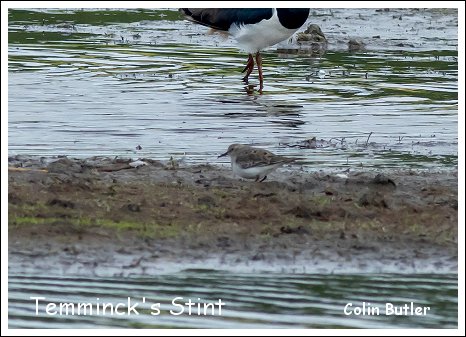 single Whitethroat and Garden Warbler. The Merlin app picked out the latter and, using the Audacity program, added a bit of amplification and filtering to produce a passable recording click here
single Whitethroat and Garden Warbler. The Merlin app picked out the latter and, using the Audacity program, added a bit of amplification and filtering to produce a passable recording click hereA couple of days later 16/5 over on the other side of Cheshire, Colin Butler went in search of a Pectoral Sandpiper on Carr Lane Pools, Hale and in the process discovered another rarity! .........."While I know that you like to keep reports local to Knutsford I thought the following may be of interest.
This morning I went to look for the Pectoral Sandpiper that has been reported close to me at Carr Lane Pools in Hale.
While I was photographing the bird I noticed a much smaller wader close to it which I immediately identified as a Stint.
I had not taken my telescope so was unable to allocate it to a specific species there and then.
When I arrived home and looked at my photos I identified it as a Temminck's Stint.
Whilst not a major rarity it is however a locally rare bird."..............
Thanks Colin and well done! Reports from KOS members are welcome no matter where they're birding!!
Park Ranger, Darren Morris, tells me that local ringer Roy Leigh successfully ringed three Tawny Owl chicks earlier this week in Tatton and examination of a Barn Owl box revealed that it contained 5 eggs and two small chicks (as well as a mound of dead voles - a gruesome sight!). In time they too will be ringed.
Darren has kindly sent me a copy of the park's Summer News Letter - you can read it here - thanks Darren.
Species recorded on the trip to the Manifold Valley - 13th May 2023 |
It was a long wait but Bob Groom finally connected with his first Yellow Wagtail of the season on a trip out to Mobberley on Saturday (6/5)............" Assuming that fewer people
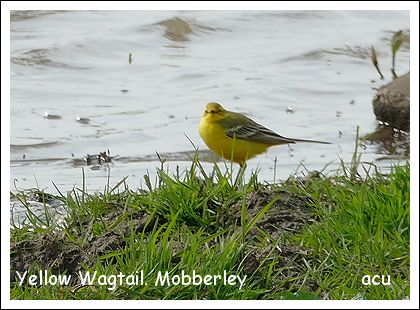 would be out dog walking today I headed for Mobberley and had a successful walk. Good to see lots of House Martins and Swallows at Blackthorn Farm (in contrast to Brookdale), also Linnets etc. The wheatear field had been ploughed so the Skylarks and Lapwings must have had to start again but I was lucky enough to get close views of a male Yellow Wagtail (my 1st of year) and a bright female Wheatear in it. A Kestrel and Buzzards also seen. After lunch Elaine, Matt and I headed for Acre Nook. Lovely views of a Common Tern, dipping to the water back and to, also lots of House Martins and a few Sand Martins and Swallows. Single Oystercatcher, several Cormorants, 6 Shelducks and 6 Swifts. Still a surprising number of Great Crested Grebes. Just one Buzzard and Kestrel."..................
would be out dog walking today I headed for Mobberley and had a successful walk. Good to see lots of House Martins and Swallows at Blackthorn Farm (in contrast to Brookdale), also Linnets etc. The wheatear field had been ploughed so the Skylarks and Lapwings must have had to start again but I was lucky enough to get close views of a male Yellow Wagtail (my 1st of year) and a bright female Wheatear in it. A Kestrel and Buzzards also seen. After lunch Elaine, Matt and I headed for Acre Nook. Lovely views of a Common Tern, dipping to the water back and to, also lots of House Martins and a few Sand Martins and Swallows. Single Oystercatcher, several Cormorants, 6 Shelducks and 6 Swifts. Still a surprising number of Great Crested Grebes. Just one Buzzard and Kestrel."..................A pity about the Lapwings on our Mobberley fields but they have plenty of time to try again. Geoff and Sheila Blamire report that "their" birds have been much more successful. This from the same day at Mere ........"We did out Rostherne/Mere walk this morning:
Little Mere: the pair of Great Crested Grebes busy building another nest in the middle of the Mere after their first attempt failed, pair of Grey Wagtails on the outlet, 1m Mandarin, pair of Mute Swans not showing any sign of breeding (weird), 1 Egyptian Goose, Coot still sitting on their nest.
Rostherne Obs: usual birds including male Blackcap and male Bullfinch.
Field next to Pioneer, Chester Road: 1 pair of Lapwings with at least 3 young chicks, the 2nd pair still sitting on their nest, 5th Lapwing still around and helping to see off Carrion Crows. "............
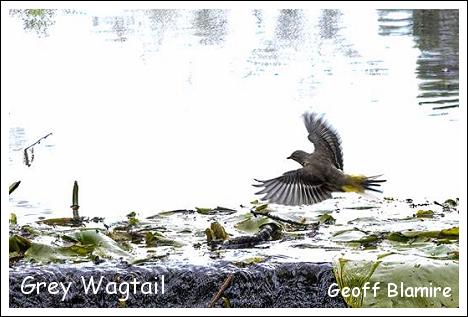
Also in the same area on the 9th and 10th May, an early brood of Mandarins!......."Little Mere:
Mandarins – 2 males on 9th, then on 10th 1 female with 8 tiny ducklings. The female was repeating attacking a couple of Coots which were too close to her ducklings for her liking. She was ferocious!!! This is the first time they have nested here.
Great Crested Grebes – the female has started to incubate, whilst the male still bringing nesting material in. Hope this second nesting attempt is successful. Last year they reared two broods.
Egyptian Geese - pair
Canada Geese - 2 pairs with brood of 3 goslings, the other with 5 goslings.
Coot – at least 2 nests with adults sitting tight.
Oystercatchers – flew over Mereside Road towards Little Mere.
Small number of House Martins and Swallows.
Reed Warbler – first time we've heard this year (song regularly heard last year).
Goldcrest – singing in conifers. "..........
Yesterday I paid an overdue visit to Tatton Park's Dog Wood and was pleased to discover a singing Redstart........"I parked at Dog Lodge, walked through Dog Wood as far as the outdoor centre (where they keep the boats). Returned to the entrance then down onto the Moor.
Chiffchaffs
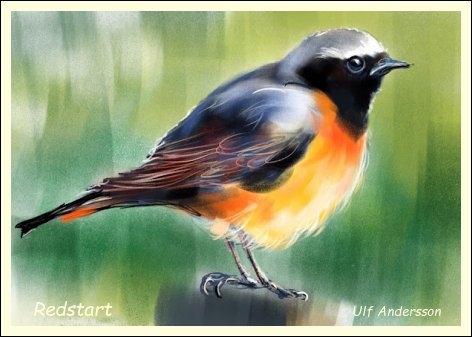 and Blackcaps in abundance on the way down the path, Nuthatches very vocal and a number of Treecreepers. G.C. Grebes, Mallard and a few Tufted Ducks on the Mere. Approaching the jetty I heard a Redstart singing. It became louder as I followed the path up to the centre and the Merlin app picked it up each time it sang. I never saw it as it remained in the canopy of the oak trees and was constantly moving around. Back in the 1970s a pair nested at this location.
and Blackcaps in abundance on the way down the path, Nuthatches very vocal and a number of Treecreepers. G.C. Grebes, Mallard and a few Tufted Ducks on the Mere. Approaching the jetty I heard a Redstart singing. It became louder as I followed the path up to the centre and the Merlin app picked it up each time it sang. I never saw it as it remained in the canopy of the oak trees and was constantly moving around. Back in the 1970s a pair nested at this location.Walking back through Dog Wood a Garden Warbler showed well and there was a second one on the walk down to the Moor. I sat on one of the benches on the Moor, no Reed Warblers heard from there but there was a Cetti's and a Swallow, the only hirundines all morning."............
There's a busy couple of weeks coming up for KOS members!
Tomorrow (13/5) it's our field trip to the Manifold Valley and the weather forecast is good. It's the perfect time of the year for this location and we should have species such as Redstart, Pied Flycatcher, Spotted Flycatcher, Tree Pipit, Dipper, Common Sandpiper and a whole host of other goodies!
A week on Sunday (21/5) and we'll be on the road to North Norfolk for a four day extravaganza! Sheila has produced a packed itinerary featuring iconic locations such as Wheeting Heath, Lakenheath, Titchwell, Cley and Frampton Marsh. 100 species? No problem!
But there's no rest for the wicked and, two days after returning from Norfolk, it's the Goyt Valley and the first of our summer evening walks. All for twenty quid a year!
4th May 2023........ The first Swifts.
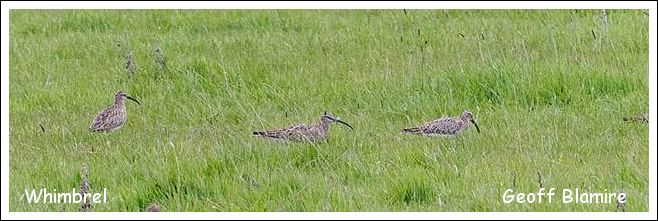 |
Sam Peers was a Mobberley birder with notes and memories going back to the 1920s. He's long gone now but I always remember him telling me that the first Swifts always return in time for the Knutsford
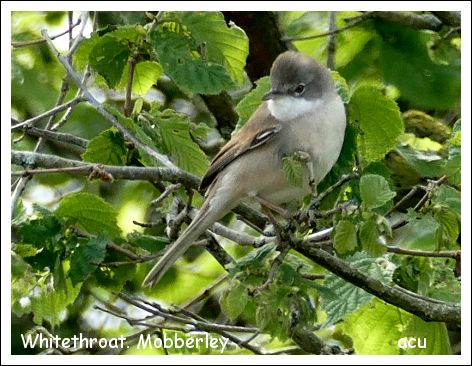 May day celebrations, which traditionally takes place on the first Saturday in May.
May day celebrations, which traditionally takes place on the first Saturday in May.Bang on time Jude Halman had the first returning birds last Saturday (29/4), with two over St. John's Road. The next day (30/4) Karina Stanley had two over Bexton Road and Bob Groom counted at least 30 flying low over Tatton Mere. This year, for the first time in its long history, Knutsford May Day has been put back a week due to the coronation but, presumably, the Swifts were unaware of this.
Last Wednesday (26/4) I recorded my first local Whitethroat of the season, on a stroll alongside the west side of Runway 2 at the airport; other firsts for the season - Speckled Wood butterflies and St. Mark's flies (one day late as St. Mark's Day is the 25th April!).
We'd seen Lesser Whitethroat on the North Wales trip last weekend but I was hoping for my first local bird, it wasn't to be but a couple of days later Peter Dawson had more luck ..........."I haven't done any local walks for a while so this morning I decided to go over to Gleave House Pool with the optimistic hope of finding three target species - yellow wagtail, garden warbler and lesser whitethroat. I knew that the first one should be easy enough but the other two a lot more difficult.
I went via the bushes adjacent to Booths Mere where in the past I've found both garden warbler and lesser whitethroat. Today, no luck with either. Plenty of blackcaps and chiffchaffs but not even a common whitethroat.
The walk along Pavement and Gleave House Lanes produced the usual tree sparrows and swallows but nothing else of note.
Reaching the fields by GH Farm I found my first target with at least three yellow wagtails. Also a single yellowhammer.
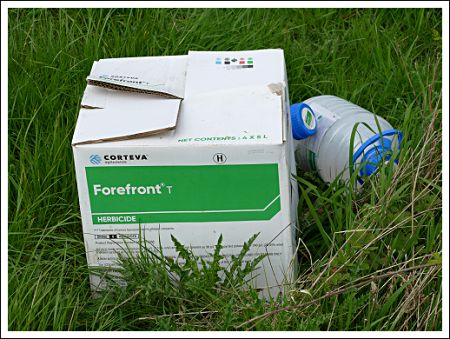 Two lapwings were in the field just over the hedge from the Pool. At the pool itself there were two pairs of shelduck. Neither with any young. A female mallard was accompanied by approximately seven ducklings. A couple of swallows and house martins were flying around and a pair of reed buntings were in the hedges.
Two lapwings were in the field just over the hedge from the Pool. At the pool itself there were two pairs of shelduck. Neither with any young. A female mallard was accompanied by approximately seven ducklings. A couple of swallows and house martins were flying around and a pair of reed buntings were in the hedges.Carrying on past the pool and over the stream I followed the path past Rooney's and the large, modern barns nearby. In the newly ploughed field on the right, two new pools have been created. A cormorant, Canada goose and mallard occupied one whilst a lapwing flew over. Carrying on towards Spring Wood farm I stopped at the small pool by the "crossroads". I've had a sedge warbler here in the past but this time I was very pleased to hear the rattling of a lesser whitethroat! Target two! Carrying on towards the farm I was met by a hare coming directly towards me. It suddenly worked out I was there, stopped and hastily ran back from whence it had come.
There was nothing of note on Booths Mere, except a pair of Egyptian geese.
So, I was very pleased to find two out of three. I'll have to wait for another day for a garden warbler!"............
Anxious to find the Lesser Whitethroat, on Tuesday (2/4) I took myself off to the area of Mobberley where Peter had seen the bird last weekend. It wasn't to be found at the pit, just a female Reed Bunting on show there but a short distance away, walking towards Wayne's World, came the unmistakable rattling song of my favourite bird! Thanks Peter. This is an area where back in the early 80s we had breeding Corn Bunting, Curlew, Snipe, Lapwing, Skylark and Yellowhammer but on Tuesday practically deserted, just acres of sterile grassland and discarded plastic bottles of herbicide. Says it all really.
Moving on to Gleavehouse Pool I enjoyed a Goostrey's sausage roll and a can of (diet) Pepsi whilst watching a Mallard with 6 young, a drake Shelduck (perhaps on guard duty as it saw off a drake Mallard), a Yellow Wagtail was heard but not seen. The field on the other side of the hedge from the pool was the scene of much activity.
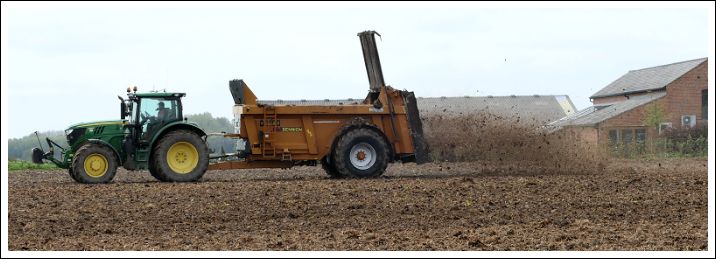 This is where Lapwings had been watched incubating their eggs last week but now the only occupants were a muck-spreader criss-crossing the field and a disc harrow standing by to finish the job. I don't know enough about current farming practices to make any comments but it does seem a pity.
This is where Lapwings had been watched incubating their eggs last week but now the only occupants were a muck-spreader criss-crossing the field and a disc harrow standing by to finish the job. I don't know enough about current farming practices to make any comments but it does seem a pity.On Sunday (29/4), and on a more positive note, Geoff and Sheila Blamire came across a flock of Whimbrel that had stopped by on their journey north ......."Superb morning around Plumley and Holford. Along the railway, after the level crossing: 1m Yellowhammer and Skylark singing. Walking up the Holford track: pair Kestrels, 1m Yellowhammer singing, then further on pair Yellowhammers, Skylark singing, few Swallows hunting over the grass. Around the Inovyn Offices: Common Whitethroat calling and brief song, Lesser Whitethroat singing, pair Oystercatchers on a field pond. Buzzard being mobbed from 1 Oystercatcher, Shelduck, c18 WHIMBRELS flew overhead and landing out of sight – eventually caught up with 9 in a field with sheep."............ Thanks team, Geoff's picture of the Whimbrel can be seen at the top of this update.
Yesterday (3/5) found a small group of mid-weekers paying a long-overdue visit to Northwich's Neumann's Flash. On a nice sunny morning, with a temperature of about 17C we made our way around the perimeter of Ashton's and Neumann's flashes before ending up at Pod's hide. Singing warblers were much in evidence all morning - Chiffchaff, Whitethroat, Blackcap, Reed, Sedge, Cetti's, Garden and Willow Warblers. Eight Warbler species in all; perhaps next time, with the addition of Lesser Whitethroat and Grasshopper Warbler we'll make double figures. Bob Groom had taken a different route from the rest of us and was able to add more excellent sightings - Marsh Harrier, Avocet, Whimbrel and Swift, bring us up to a total of 47 different species in three hours.
Simon Smith and Lyn Graves would normally have been with us on a Wednesday but they'd decided in advance to try the Goyt Valley.
........."apologies for not joining yesterdays walk around the Flashes. We’d already decided to try our luck with the summer migrants up in the Goyt Valley.
We watched two pairs of Pied Flycatchers occupying the nest boxes beside the road just past the car park and finally tracked down a pair of Redstarts who were nesting in the quarry further up the road. A good opportunity to study the females, see attached."...........
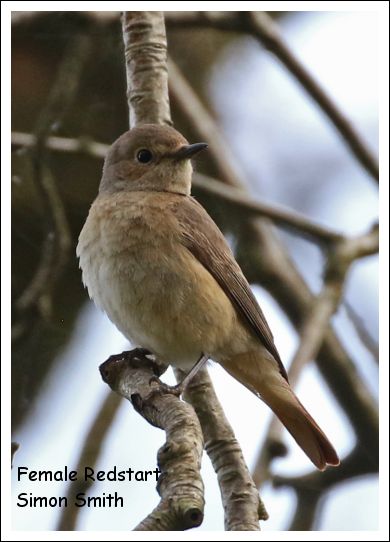 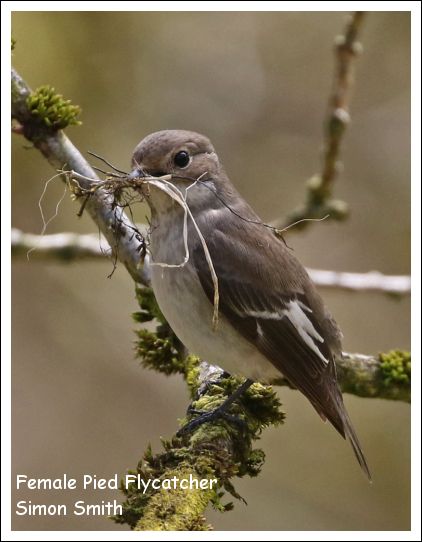 |
The AGM, our first since April 2019, took place last Friday (28th April). It went very smoothly and was done and dusted in a record 8 minutes!! After which Sheila Blamire (with Geoff's help) gave a very polished presentation about their trip to Africa and the Zimanga game reserve located in South Africa’s KwaZulu-Natal province.
The programme for the rest of 2023 and into 2024 has been finalised you can read it here. It ends with our KOS 50th anniversary trip to Dumfries and Galloway in June 2024.
I've updated the procedures for joining the KOS #1 for the first time - using an online form with no paperwork involved and #2 renewing membership when it's due. http://www.10x50.com/trips.htm#Joining
Species recorded on a visit to Neumann's / Ashton's Flashes Wednesday 3rd May 2023 |
25th April 2023 ...... The trip to North Wales.
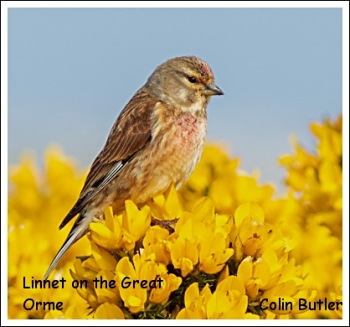 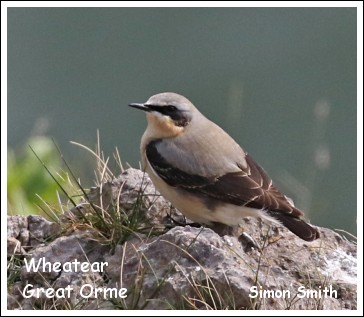 |
Last Thursday evening the KOS Treasurer Frank Dearden and I attended a meeting of the Wincham, Pickmere & District Astronomy Group, held in the Wincham Community Centre, to hear a presentation by our American birding friend Derek Richardson. Derek's talk was an update on NASA's DART project in which he played an important role.
The venue was crowded with a mixture of local people and amateur astronomers (so many in fact that the organisers had to bring out extra chairs, for the first time ever!). Derek's presentation was pitched at just the right level for his audience; not too technical but technical enough for the astronomers present to sit nodding their heads in obvious approval.
Fast forward two days to Saturday the 22nd April and Derek - "Professor of Astrophysics at the University of Maryland, specializing in computational astrophysics with an emphasis on problems in planetary science" became Derek the birder, travelling with us to North Wales anxious to add at least one new species to his all time list. (ATNO - all time new one!).
After an easy drive down the A55 we stopped off at
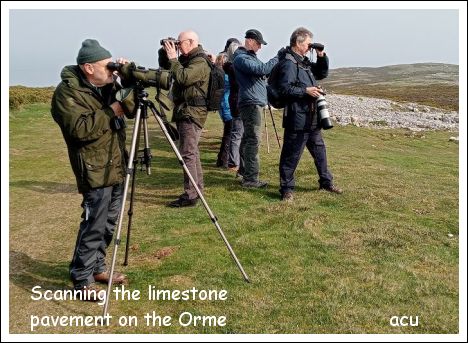 Rhos-on-Sea to begin our day-list before driving through the centre of Llandudno, a place Derek had never been to, and on up the centre of the Great Orme to the tram station before dropping down to the Marine Drive (so avoiding the toll booth close to the pier!). We met the other members of the party at the small car park overlooking the limestone pavement; there were a dozen of us, which was more than expected with so many regulars being unavailable.
Rhos-on-Sea to begin our day-list before driving through the centre of Llandudno, a place Derek had never been to, and on up the centre of the Great Orme to the tram station before dropping down to the Marine Drive (so avoiding the toll booth close to the pier!). We met the other members of the party at the small car park overlooking the limestone pavement; there were a dozen of us, which was more than expected with so many regulars being unavailable.Trip leader Sheila Blamire soon had us on the move, heading towards the limestone pavement where we hoped to find a Ring Ouzel, one of the three species on Derek's list - Lesser Whitethroat and Arctic Tern being the other two. One had been seen earlier in the morning but we failed to locate it, nevertheless there were other birds present - and lots of them! There'd been a fall of Wheatears and they were everywhere. In a field just over a dry stone wall we counted 16 whilst on the near side a dozen or more, together with a superb male Redstart. Meadow Pipits displayed overhead, Stonechats and Linnets perched on the gorse bushes and, in the distance, a Chough fed on the short grass of the Orme. Swallows and House Martins passed through in small numbers making the most of a beautiful Spring morning, as did a female Blackcap - ticked off as we made our way along the path to the area overlooking St. Tudno's church.
It was then downhill, past the church and on to the Marine Drive, pausing on the way to watch a Whitethroat, not Lesser unfortunately but a new species for the day (and year for most of us). We then began the long trudge up the drive as far as the "Rest and be Thankful" cafe, just past the lighthouse.
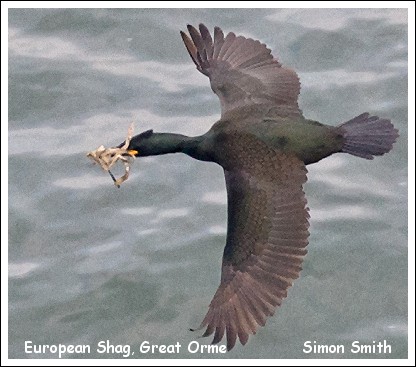 A few Gannets, Shags and Cormorants flew over the sea below us but the majority of birds were to be found on and around the cliffs just below the lighthouse. Guillemots and Razorbills (some members of the party had seen a Black Guillemot earlier) were present but in much smaller numbers than we've seen on previous visits as were the Kittiwakes, easily identified from above with their ink-black wing tips that shade from white to grey on the mantle.
A few Gannets, Shags and Cormorants flew over the sea below us but the majority of birds were to be found on and around the cliffs just below the lighthouse. Guillemots and Razorbills (some members of the party had seen a Black Guillemot earlier) were present but in much smaller numbers than we've seen on previous visits as were the Kittiwakes, easily identified from above with their ink-black wing tips that shade from white to grey on the mantle.We finally arrived back at the cars just before the allotted time of 1pm after a walk of 5.18 Km (3.24 miles) and a total hight gain of 106 meters (348') - more than enough for some of us (me anyway!) Bob Groom had taken a different route to the rest of us and had been lucky enough to see a Short-eared Owl on his travels. We were forging quite an impressive list.
We enjoyed lunch up there on the Orme before driving down to the RSPB's Conwy reserve at around 1:30pm. The new cafe or should it be restaurant? looked great from the outside as we passed by on the way to the hides. We didn't linger as it had started to rain - heavily! Derek was in his element as we scanned the reserve from the first big hide; different terrain altogether from the Orme of course, with an almost complete change of personnel! The rain had brought down passing hirundines and the Swallows and House martins had been joined by Sand Martins. Below, on the water, a whole range of waterfowl - Canada Goose, Mute Swan, Shelduck, Gadwall, Little Grebe,Tufted Duck, Teal, Great Crested Grebe and even a male and two female Red-breasted Mergansers. Other species seen from the hide included Curlew, Redshank, Black-tailed Godwit, Little Egret and six Dunlin. Derek was very impressed with the reserve, remarking that nothing like it existed anywhere in the USA. Nevertheless we were aware that our guest had provided us with his short list of possible ATNO's and so far we'd not come up with the goods; however this changed shortly afterwards as we continued around the reserve. Approaching an area of mixed sallow and hawthorn and from a distance of only a few yards came the unmistakable rattling song of a Lesser Whitethroat - bingo! Derek had the Merlin app running on his phone and the song was so loud I feared a case of "rapid unscheduled disassembly" (of the phone, not Derek) although he was delighted with his latest lifer!
My preliminary day-list stood at 68 but, after a series of late night emails, we squeezed out a few more from participant's note books and ended up with a final figure of 79 species - good going team. A trip to remember!
Meanwhile
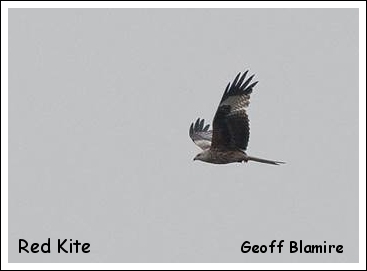 back at home Geoff and Sheila Blamire were out and about early the following morning (23/4) and were rewarded with a Red Kite flying over Lostock Gralam........"We did our Plumley/Holford/Lostock Green 11+km walk this morning. Nothing new except RED KITE! Slowly circled from Lostock Gralam direction over towards railway level crossing, Plumley, catching insects in the air and eating them on the wing,"..........
back at home Geoff and Sheila Blamire were out and about early the following morning (23/4) and were rewarded with a Red Kite flying over Lostock Gralam........"We did our Plumley/Holford/Lostock Green 11+km walk this morning. Nothing new except RED KITE! Slowly circled from Lostock Gralam direction over towards railway level crossing, Plumley, catching insects in the air and eating them on the wing,"..........Yesterday found the couple on the go again ............"We did our 12km walk this morning taking in Mere and Millington. The 'usual' Yellowhammers, Skylark, plenty of hirundines (3 species). Buzzards (including 1 pair being mobbed by 2 Carrion Crows), and on Little Mere: a pair of Teal (first time recorded here), pair of Gadwall, Great Crested Grebe, 3m Mandarins, etc. But the best sighting of all, was 2 pairs of Lapwings which are nesting opposite Moss Farm, Peacock Lane, when all 4 Lapwings mercilessly attacked a male Pheasant who had the audacity to wander into the field. One time a 5th Lapwing joined in. One of the Lapwings even did the ‘broken-wing’ display just in front of the Pheasant (seen in photo 1 and 2). The attack went on for almost 10mins! Hopefully Geoff’s video will show some of the action - https://youtu.be/pUxgo5BlzPY "............ Thanks Geoff, the Lapwings were giving the Pheasant a hard time!
A reminder that this coming Friday it's our KOS AGM, the first since April 2019. I'm sure the formalities will be completed in less than 15 minutes after which Sheila will be giving a presentation entitled " THE MIRACLE OF ZIMANGA". The meeting starts at 8:00pm and, as it's the AGM, entry will be free.
Breaking news! I'd just completed this update when there was a knock on the door and there stood an excited Paul Leigh with the news that he'd just had an Osprey flying over Tatton Mere! For those that remember that far back Paul, his brother Sam, Barrie Armitt and Garry Healy were all members of our KOS junior section in the 1970s - all are still birding!....... you only have to sow the seeds.
Species recorded on the KOS trip to North Wales on 22nd April 2023 |
20th April 2023.........Some good records from Rostherne
 |
One of last Thursday's Wheatears, seen by Bob Groom close to Gleavehouse farm in Mobberley, was still there a couple of days later when I followed the same route........"10°C this afternoon but it felt a lot colder due to the strong westerly wind blowing in over the Badlands
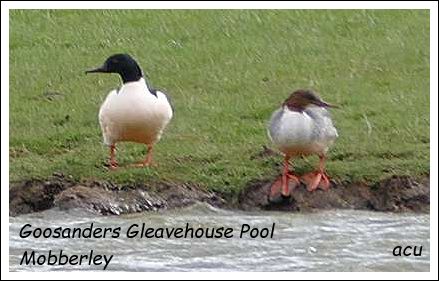 of Shaw Heath. It wasn't obvious at first but I persevered and found one of Bob's Wheatears in the last field before GHP. I had only intended to go so far but as I was so close I continued to the pool.
A pair of Goosanders, Oystercatcher, Yellow Wagtail, 2 Swallows and a House Martin."...........
of Shaw Heath. It wasn't obvious at first but I persevered and found one of Bob's Wheatears in the last field before GHP. I had only intended to go so far but as I was so close I continued to the pool.
A pair of Goosanders, Oystercatcher, Yellow Wagtail, 2 Swallows and a House Martin."...........It was nice to see the hirundines again, Bob had one or two more at Tatton!..........."At last (for me) a huge gathering of hirundines over Tatton Mere. They were literally end to end so I'm guessing at at least 800, possibly 1,000 birds. Apart from a few Swallows they were all Sand Martins. That said at that point the light wasn't great for seeing white rumps and I couldn't make any out, despite careful scanning.
Eventually the wind defeated me (shame my favourite seat has gone) and I retreated to the Allen Hide for some shelter from the blast. Female Great Spotted Woodpecker on the feeders. Green Woodpecker heard. There were a few more Sand Martins and Swallows over Melchett Mere. Usual Herons, Cormorants, Buzzards. Unfortunately the remaining 'hobby tree' is still in the water, which can't be doing it any good."............
On Saturday (15/4), parking at the top of Wood Lane in Mobberley, I paid my first visit this Spring to the path along the side of the airport's runway 2. .........."A pleasant morning after two days of almost continuous rain. I drove to the top Wood Lane and took the perimeter path towards the airport.
Chiffchaffs and Blackcaps very prominent. As usual I struggled to differentiate between the
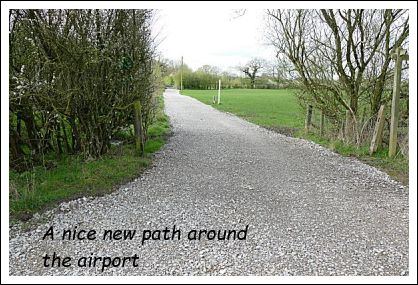 Blackcaps and two Garden Warblers in song. Merlin came to my aid and pinpointed a Garden Warbler that eventually appeared for a few seconds.
Blackcaps and two Garden Warblers in song. Merlin came to my aid and pinpointed a Garden Warbler that eventually appeared for a few seconds.My first Willow Warbler performed well over the path, so no problems with that!
First Orange Tip floated past.
I feared that I wouldn't be able to walk as far as the concrete blocks as that path, where it crosses a field, is always very wet but I was pleased to find that a thick layer of screed has been laid and it's very easy going. No Lesser Whitethroat though."..........
On Friday (14/4) Geoff and Sheila Blamire dropped into the Rostherne obs. on their daily walk and had a pleasant surprise!............"We decided to do a repeat visit to Rostherne this morning because the forecast was for rain, and more rain! We still got rather wet on our 10km walk.
Ciceley Mill Lane: we found a plastic bag containing 3 sandwiches and a small pork pie – obviously someone dropped it! Because no one was around and because it was close to Ciceley Mill pool we decided to put the contains out for the Mute Swan. We left him tucking in with great relish. (on the way back nothing was left).
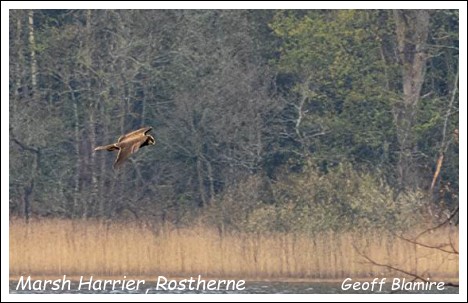 Rostherne Brook leaky dams: a family of Mallards – 1m 1f c12 small ducklings.
Rostherne Brook leaky dams: a family of Mallards – 1m 1f c12 small ducklings.Rostherne Obs: not much to report other than the ’usual’ birds, including 1m 1f Goosanders, singing Cetti’s Warbler, etc, until I picked up a female Marsh Harrier flying past Cormorants’ nests, then over Doll’s Meadow and then it flew close to the edge of the mere towards the direction of Bittern Hide and then out of sight. "...............
Our small Monday morning team also had a spot of luck this week (17/4) with a distant Black-necked Grebe, fortunately we've become quite familiar with the species during our visits to Woolston Eyes, to where this bird will no doubt have made its way........." Cetti's were singing all morning, f. Goldeneye hanging on, no hirundines. A Black-necked Grebe was the day's highlight - not easy to ID with our limited fire-power as it spent its time just off the Mere Covert reeds but the light slowly improved and, through the 40X big binocs., the salient features were just discernible. It was very active, taking insects from the surface of the mere - it was so quick it looked for all the world like a phalarope, sometimes spinning round in its own body length!
Fortunately it was still around when Bob arrived, so he had reasonable views through the binocs."..........
Sheelagh Halsey has kindly sent me a copy of Bill Bellamy's latest Rostherne quarterly revue, covering the period January to March 2023. You can read it by clicking here.
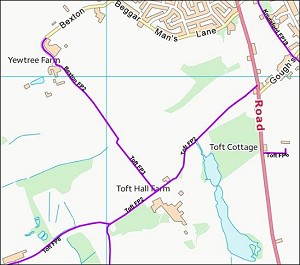 Yesterday (12/4) Jude Halman took us to one of her favourite local birding spots, just a short distance from Knutsford town centre........." Starting at Yewtree Farm and "Bexton Hall Hamlet" a place full of barking dogs and security cameras (home to a Mafia boss?). An excellent location, a bit windy today as we made our way along the paths FP2 and FP3 to Toft Hall farm and then on to the start of the lake, as shown on the map. Easy going and some excellent birds. Lapwings, 2 Wheatears, Song Thrush, 3 Yellowhammers, Buzzard and a pair of Grey Partridge (the first I've seen locally for decades). We ended with a food-carrying Mistle Thrush in the middle of an estate somewhere. Jude will know where we were. - 31 species."........... Thanks Jude, for an enjoyable mornings birding. I see the path eventually leads to The Schoolhouse where Pete Hall used to live, before he moved to Wales.
Yesterday (12/4) Jude Halman took us to one of her favourite local birding spots, just a short distance from Knutsford town centre........." Starting at Yewtree Farm and "Bexton Hall Hamlet" a place full of barking dogs and security cameras (home to a Mafia boss?). An excellent location, a bit windy today as we made our way along the paths FP2 and FP3 to Toft Hall farm and then on to the start of the lake, as shown on the map. Easy going and some excellent birds. Lapwings, 2 Wheatears, Song Thrush, 3 Yellowhammers, Buzzard and a pair of Grey Partridge (the first I've seen locally for decades). We ended with a food-carrying Mistle Thrush in the middle of an estate somewhere. Jude will know where we were. - 31 species."........... Thanks Jude, for an enjoyable mornings birding. I see the path eventually leads to The Schoolhouse where Pete Hall used to live, before he moved to Wales.Talking of Wales we'll be heading there on Saturday morning for our April field trip, taking in the Great Orme and the RSPB Conwy reserve. The latest weather forecast that I've seen predicts a dry day until late afternoon. That will be fine, as the Orme on a rainy day can be a bit challenging - to say the least!
We'll be joined on the trip by Derek Richardson who, you may remember, enjoyed a days birding with us to Burton Mere in August last year. This evening (13/4) Derek will be giving a presentation to the Wincham, Pickmere and district astronomy group about the outcome of NASA's Dart mission, a project in which he was heavily involved. Frank Dearden and I will be going along.
11th April 2023..... A game changer?
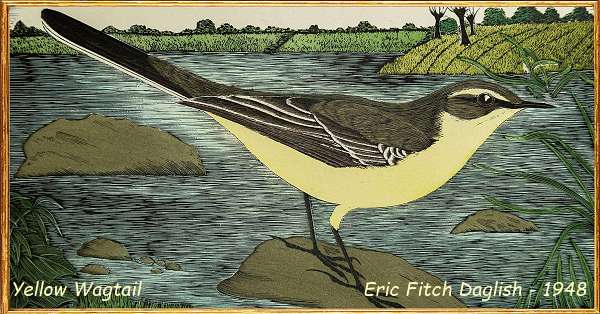 |
As a birdwatcher one of the most difficult skills to learn is the identification of birds by their song or calls. Starting at a young age makes the job easier but it becomes a more difficult task with increasing age.
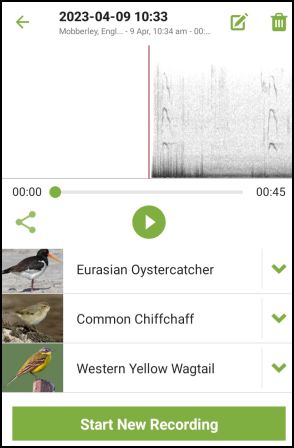 Even then, as I know to my cost, over the years hearing can deteriorate and eventually many birders struggle to pick up birds that others can hear clearly!
Even then, as I know to my cost, over the years hearing can deteriorate and eventually many birders struggle to pick up birds that others can hear clearly!But fear not, as I believe help is at hand with a smartphone app from the Cornell University called Merlin. https://merlin.allaboutbirds.org. Jude Halman recommended that I try it as we were sat in the Rostherne Obs. drinking tea and eating Ken's sausage rolls. I was sceptical at first but having tried it over the past few days I must say it's very impressive! For folk who are just getting to grips with bird song and calls it's an invaluable asset whilst those who's hearing wasn't what it was will be amazed by what the app. picks up and what they would otherwise have missed.
Geoff and Sheila Blamire already had a copy of the app on one of their phones, although they hadn't used the sounds facility but gave it a try on Monday morning (10/4) during their daily walk from home ..........." Today: confirmed 3 sites for Yellowhammer, 2-3 sites for Skylarks, 2 sites for Lapwings (4 pairs), 2 sites for Reed Buntings, etc. Watched a Chiffchaff taking a feather into a tussock of grass to line its concealed nest. We’ll try keep an eye on this.
We downloaded Merlin app whilst in South Africa (to ID SA species), but haven't used the sound. So Geoff tried it on Chapel Lane – Blackbird, Robin, Wren, Chiffchaff, plus Goldcrest! How on earth did it detect with the racket going on. So we tried it along Mereside Road by a wood, because we saw/heard Goldcrest there 2020 and 2021, but not 2022 and so far this year. The app didn't pick up Goldcrest (plenty of species) but did pick up Willow Tit!!! "..............
Peter Dawson has a copy on his phone and he seems to have been using it for sometime ........"I went for a wander around Knutsford Moor this morning along to the reedbed and decided to use the Merlin sound app to see what it picked up. I use it quite often. Although it's not great, it can be helpful.
There was at least one cetti's singing but possibly as many as three. It was difficult to know whether it was a single bird moving around or different birds. I also heard two blackcaps although the app didn't pick either up. No willow, reed, sedge or grasshopper warblers yet but it's still early so I'll have another go in a few days"........
At the same time that Peter was on the Moor I was in Dog Wood and was impressed that Merlin picked out both Goldcrest and Treecreeper singing at the same time. It also flagged up Common Redstart but I was unable to see or hear one; they have nested here in the past and Mark Eddows tells me they've already returned to his study area at Bonsall, up in the Pennines.
Heavy rain and gales are forecast for tonight (11/4) but for the first three days of the Easter break the weather was very pleasant; it was dry and relatively warm and settled. Not wanting the hustle and bustle of Tatton Park I spent three mornings (7,8,9 April) locally in Mobberley, walking from home to Gleavehouse Pool. I was hoping for my first Wheatear, Swallow, Yellow Wagtail or House Martin. No luck on Friday (7/4) but the following morning my first Swallow dipped past as I approached Blackthorn Farm and at the pool I was delighted when a House Martin flew in, did a few circuits of the area and finally landed on the pool side to collect a beakful of
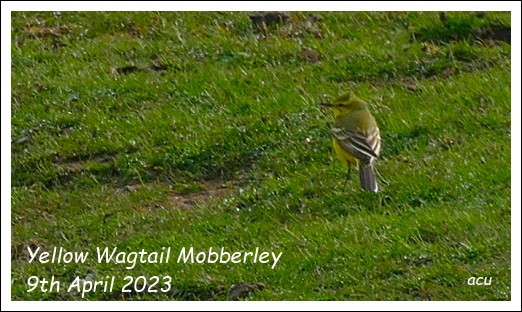 mud for nest building - a local bird.
mud for nest building - a local bird.The following morning there were four Swallows at the pool and also three House Martins, three Oystercatchers were having a noisy altercation but not loud enough to drown out the sound of the year's first Yellow Wagtail dropping in. (The Merlin app. picked it up too!)
The following morning, before the rain, local birder Wendy Stratford ticked off the Yellow Wagtail too ........."Walked to the pool early this morning to avoid the rain – very nice. Others were doing the same – buzzards spiralling lazily upwards over Bentleys and constant skylarks between GH gates and the pool. I saw 7 different skylarks, including one, unusually, perched on a hedge (crest up – lovely) and 2 fluttering close over the crop before dropping out of site – nesting already? There were lapwings on the ground in 3 different fields, and lots of acrobatic displays and calling. At the pool there are cows in the north side (but not the south) so only the coot pair were visible, and one oystercatcher arrived as I was leaving.
As I walked back across what was until very recently the cow field I saw some movement on the ground some way off. It was a pied wagtail feeding, but then a flash of yellow revealed a yellow wagtail doing the same only a few feet from the pw! Didn't see any swallows or martins though. "..........
Yellowhammers seemed to have vanished from this particular area, although they are about as Jude Halman found on a walk in the fields around Toft hall ........"My first Yellowhammer this morning by Toft Hall flew down for a drink, no Blackcap yet, otherwise I had a very good count of 23 species."..........
KOS Secretary, Karina Stanley was out and about before dawn! and was also rewarded with views of a Yellowhammer and a cock Linnet that prompted a vivid and almost poetic description!......."I did a quick pre-sunrise walk this morning down the railway line. Delighted to report my first Blackcaps of the year and a pair of nesting Tree Sparrows. Dismayed to see the Yellowhammer’s favoured mass of Blackthorn has been grubbed up although a pair were still flitting about. Another highlight was the searing colour on a male Linnet which matched the sunrise in front of me as the moon set behind!"........ Thanks Karina, we were there with you!
Bob Groom now has his car back and, despite the weather, used it to good effect this afternoon (11/4) with a visit to the area around Gleavehouse Farm ........"Another very unsettled day. Met Office says "no data" so just a guess - Min 6C Max 10C. Tomorrow there is a weather warning for gales. Just about to leave in the car when a party of Redwings with a few Fieldfares flew over the cul-de-sac, so still around. Parked as usual on Gleavehouse Lane. Single Swallow back at Blackthorn Farm. Usual Tree Sparrows. Pair of Linnets. Couple of Buzzards. Two Pied Wagtails. As I'd rather hoped saw 2 bright cock Wheatears in the second field going east from Gleavehouse. Walking back they were in the top of a tree and then flew off. Two Skylarks were up singing, despite the showery weather."............ Nice one Bob, with a bit of luck they may linger with us for a few days.
5th April 2023... The first Swallow, Wheatear, Willow Warbler and Blackcap
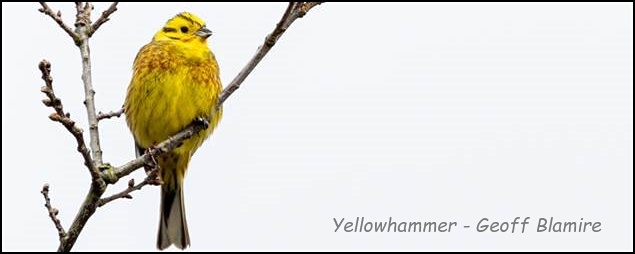 |
Last Wednesday (29/3) I walked over to Mobberley's Gleavehouse Pool, my first visit of the Spring, hoping for early Yellow Wagtails or Little Ringed Plovers. I was probably being a tad optimistic, the first wagtails normally arrive a bit later (2020-7/4: 2020-12/4: 2022-22/4) with LRPs (2020-8/4: 2021: 10/4)........."Lapwings appear to be on eggs as they weren't too pleased with my presence. Skylarks singing overhead in good numbers; very encouraging. The final field before the track to the pool has cattle on it and it's very muddy, you have to stick to the narrow path between the hedge and electric fence. perhaps best to walk from Mill Lane if coming by car.
At the pool 2 noisy Oystercatchers, a pair of Teal, Coot, Mallards, Egyptian Goose and a drake Shelduck. A female Kestrel was chased by three Jackdaws as far as High Lake Manor (ancestral home of Lord Rooney). A Chiffchaff singing as I left."...........
On the same morning Darren Morris was having more luck on a walk through Tatton Park and he sent me a series of texts as his day got better and better" ........."The first text came as I was having breakfast - Goosander on the Moor followed by Oystercatcher on the jetty and, later, Egyptian Geese with three young. Finally, as I sat freezing next to the pool - Sand Martins and a Swallow - Tatton Mere!"...........
Two days previously (27/3) Darren made his way up to the park's Mill Pool and was rewarded with the first Wheatear of the year. It was a female, which is quite unusual as the male birds are normally this first to be seen.
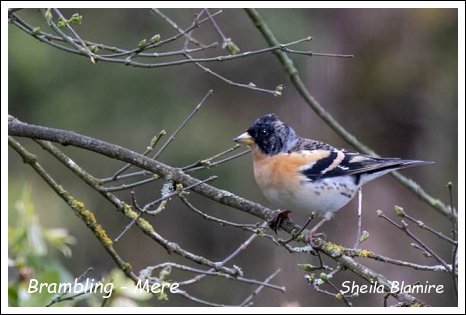
Geoff and Sheila Blamire were also out and about on the 27th .........12km walk around Millington including a new area.
Chapel Lane: 2 Yellowhammers, 2 Skylarks (singing), flock of c30 finches and buntings, Chiffchaff singing (after that we didn't count Chiffchaffs – too many!).
Peacock Lane: Yellowhammer, 2 pairs of Lapwing nesting in a cereal crop, 1m Reed Bunting overgrown field pond, pair of Buzzards (sitting very close to each other!).
Froghall Lane (new lane): 1f Kestrel sitting in a small tree, Buzzard sitting on a low hedge, 4 Jays squabbling over food.
Millington Lane: 2 Skylarks (singing), 2 Buzzards.
Little Mere: 3m 1f Mandarins – 3 males trying to mount the female with a lot of fighting and almost drowning the female, she tried to fly off but couldn't get away. ............
Sheila also reports their first Willow Warblers, at Neumann's Flash and a Blackcap at Ciceley Mill, Rostherne. The Brambling you see in the picture was taken in their garden last week. They do seem to hang on and can be found in Dog Wood into the first week of May.
Bob Groom is without his car at the moment so confined himself to a short walk along the lanes close to home ........" Green Lane/Moss lane this afternoon - a Bat (!) flying towards the Cemetery, my first Brimstone of the year, 2 Chiffchaffs, Buzzards circling, 3 Lapwings displaying, Stock Doves, Heron, Oystercatcher flying over..".........
Our next KOS outing is to North Wales on Saturday 22nd. April when we'll be walking the Great Orme before finishing off with a visit to the RSPB's Conwy reserve. Sheila will be our leader for the day and members are reminded to let her know if you will be going along.
The following Friday, 28th April it's the AGM when Frank our treasurer will be pleased to receive your annual subs and in return will issue you with a shiny new membership card.
Finally great news from Mobberley - the Mobberley Village Bakery (AKA Goostrey's) will be re-opening next Wednesday (12th April), some proper unadulterated bread at last!
27th March 2023........ The first Chiffchaffs!
 |
The first of this year's Chiffchaffs arrived in Tatton Park's Dog Wood on the 18th March, just two days after our first Sand Martin. There were probably two or three birds, although they were very active and, because they were moving quickly from tree to tree, you could be forgiven for thinking there were more.
Peter Dawson was out and about over the same weekend and also found his first Chiffchaffs on the 18th. ............"Walk on Saturday morning from home to Gleavehouse Farm via Booths Park and Pavement Lane - highlight was a nice male stonechat in the hedges near the donkey sanctuary. Other birds of note - two singing chiffchaffs in Spring Wood, tree sparrows and linnets along Gleavehouse and Pavement Lane and two oystercatchers still at Booths Mere. Total species approx 45.
Walk on Sunday morning from home via Toft Wood and Ash Farm and back via Sandy Lane. The highlight was finally finding a yellowhammer near Sandy Lane just as I had given up hope of finding one. Other
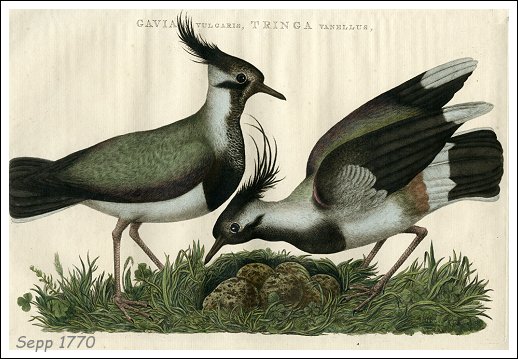 birds of note - goldcrest, egyptian goose, linnet, reed bunting, kestrel, teal and four singing chiffchaffs in various locations. Total species approx 45 again!"...............
birds of note - goldcrest, egyptian goose, linnet, reed bunting, kestrel, teal and four singing chiffchaffs in various locations. Total species approx 45 again!"...............On the same day (18/3) Wendy Stratford also walked up Gleavehouse Lane but carried on to Gleavehouse Pool ............" Walked to the pool this morning – lovely. Tree sparrows in GH Lane, at least 4 skylarks up and singing between GH and the pool. On the track down to the pool a yellowhammer was perched on the top of the hedge – great view. Goosander pair on the pool, one oystercatcher and two coot. Lapwings were calling and flying over the pool, and two were performing aerial acrobatics over the cow field behind the obs. Tree sparrow in small thorn hedge opposite obs was flying up and returning to the hedge, presumably feeding although I couldn't see anything.
Walking back I accidentally flushed 2 skylarks twice! They flew off but quickly returned to the crop cover. Two more oystercatchers flew, calling, over the SQ in the direction of the pool, and a kestrel was hunting."................
Thanks Wendy and Peter, lets hope that the Little Ringed Plovers return to the pool again this year. There are already some in the country.
Bob Groom was on granddad duty last Wednesday (22/3). It's a good job the kids enjoy their birding!........."Leaving aside the unpleasant strength of the wind, not too bad a day with the rain holding off in the afternoon, contrary to the forecast. Min 8C Max 13C. Sunshine and showers tomorrow and still mild. (But going colder at the weekend.) Called at Acre Nook en route to feed the ducks and geese. Saw a Sparrowhawk and 3 Buzzards plus Teal, Shoveler etc. but now nowhere for waders (except for two Oystercatchers flying round). Excellent views of the female Red-Breasted Merganser at Redesmere, also 6 Goldeneyes and 8 Sand Martins. Rooks in the field (3+ rookeries in a short distance along Chelford road totalled c.30 nests.) plus usual Greylags and Canadas. Heron flying over as we dropped off the kids. Kestrel hovering over Tabley Road. 8 Stock Doves from Moss Lane and c.60 Meadow Pipits seen from Green Lane. Clearly a spring movement.."........
Following their visit to Rostherne's Ciceley Mill Geoff and Sheila Blamire took to BWP!......."This morning we saw the complete pre-copulative display, mating, following by post-copulatory behaviour as described below and the attachment!!!
From BWP: “In pre-copulative display, both birds alternately dip head beneath water, preen or rub back or flanks, and occasionally up end, gradually activities become synchronized and, between Head-dips, neck held upright and close together for moment or two. Wings held low, often dragging on water, and male pushes neck feathers and body over female's until mounted on her back, grasping her neck feathers in bill. Post-copulatory behaviour also stereotyped. Male slips off, both birds often utter hoarse, muted calls, and rise half out of water breast to breast with necks extended and bills pointing first up, then down, and finally from side to side, Usually, both birds then bathe, preen, and tail-wag.” ".........
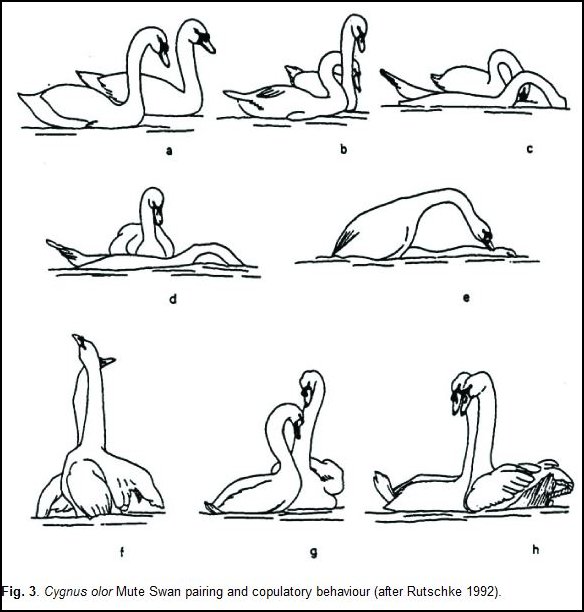 |
On the subject of swans I'd just set off on a walk to Gleavehouse Pool yesterday (26/3) when Tatton Ranger Darren Morris sent me a text "34 Whoopers Tatton Mere"! So the walk was abandoned and I hurried home, grabbed my camera and set off for the park hoping they'd hang about until I got there. I was lucky - they were still there. They seemed quite wary and kept to the centre of the mere but I managed to get some decent record shots of the flock, one of which is reproduced at the beginning of this update. They'd moved on by 10am this morning when the park opened.
Ospreys are returning to their nest sites and the usual excellent webcams have been set up ready for their fireside birding fans. Links to three of my favourites are appended below.
Loch Garten - https://www.youtube.com/watch?v=EYeEaXvLu38
Dyfi - https://www.youtube.com/watch?v=0pqHg8Dt7pg
Poole Harbour - https://www.youtube.com/watch?v=_giDo6rq2sE
Incidentally a ringed Scottish Osprey has been discovered in the West Indies - now that's quite a journey!
17th March 2023...........The First Sand Martin
Perhaps it's the talk of global warming and early Springs etc. that persuaded the majority of entrants to chose an early date in this year's KOS Sand Martin competition; the first few days of March were popular, with some even going for late February! The cold winds
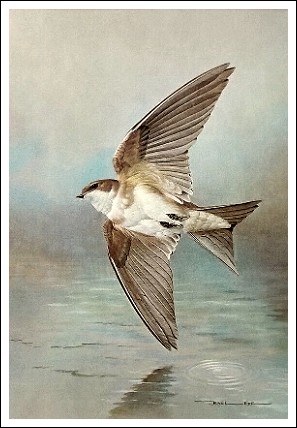 coming from the north over the past weeks put paid to their chances though and it wasn't until yesterday (16/3) that Alan Gillespie recorded Tatton's first birds of the year .........."I saw my first Sand Martins this year today at 13:31 flying both high and low over Tatton Mere mainly around mid-mere near the scout boat launch area. The best I could count was seven(7). I did a good scan for about 10 minutes but that was the best I could come up with. I had to get back to work."............ Thanks Alan, it's a good job you decided to take a break!
coming from the north over the past weeks put paid to their chances though and it wasn't until yesterday (16/3) that Alan Gillespie recorded Tatton's first birds of the year .........."I saw my first Sand Martins this year today at 13:31 flying both high and low over Tatton Mere mainly around mid-mere near the scout boat launch area. The best I could count was seven(7). I did a good scan for about 10 minutes but that was the best I could come up with. I had to get back to work."............ Thanks Alan, it's a good job you decided to take a break!Derek Pike and I had both been in the park earlier, without success, so the birds must have arrived after we'd left. Anyway no one guessed the actual date, the closest were Frank Dearden and Jane Storey who both chose the 14th (and exactly the same time of 14:15!) and Colin Butler with 11:01 on the 18th. I wasn't looking forward to the calculations required but help was on hand from this website https://www.timeanddate.com/date/timeduration.html which told me that the winner was Colin who was 2,730 minutes out compared with Jane and Frank (2,886' out). So well done Colin who wins a copy of the 2023 Birdwatcher's Year Book.
Time spent in Tatton in search of Sand Martins is never wasted though and over the last few days I've had Grey Wagtail, Kingfisher, Green Woodpecker and even a Common Scoter that was floating in the middle of the mere. The walk through Dog Wood can be rewarding with Woodpeckers drumming and good views of Treecreeper, Song Thrush, Mistle Thrush and Nuthatch. It's this wood that we'll be concentrating on next week in anticipation of the first singing Chiffchaffs and Blackcaps.
Although the first Summer migrants are beginning to appear our Winter friends are still with us in good numbers, especially Redwings and Fieldfares as Geoff and Sheila Blamire found on their daily walk last Saturday (11/3)........""We did our usual Mere/Rostherne walk this morning. Much warmer than yesterday! Lot of bird song – good to hear.
Little Mere: both Great Crested Grebes were present – one time the male surfaced with some weed but the female had disappeared and eventually he dropped it. We were hoping for some display! 12-14 Tufted Ducks.
Cicely Mill Pool: 1 Mute Swan (his partner seems to have gone AWOL), plus 6 Gadwall.
The field on New Lane, just before Rostherne village, held 50-60 Fieldfares (could have been more), and few Redwings and Starlings.
Rostherne Obs: 9 Shovelers (7m, 2f); 4 Buzzards interacting over Mere Covert; 4 Goldeneyes (1m, 3f); trilling Little Grebe by the boathouse; plus the usual other species. .........
The following morning (12/3) found us at Wigan's Pennington Flash for our March field trip. There'd been some heavy rain overnight but the day remained dry, although it was very muddy and quite challenging in places.
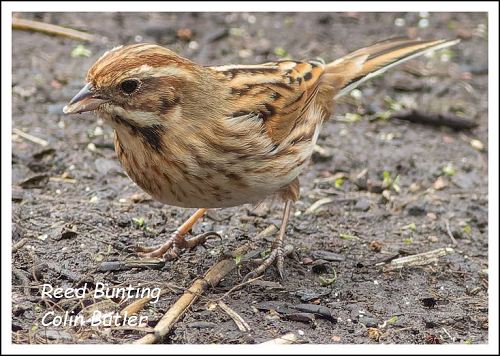 The usual species started the day-list and, from the car park, we began with Canada Goose, Mallard, Little and Great Crested Grebes, Goldeneye, Tufted Duck etc.
The usual species started the day-list and, from the car park, we began with Canada Goose, Mallard, Little and Great Crested Grebes, Goldeneye, Tufted Duck etc.A little further round the flash a feeding table had been set up where we noted Blue, Great, Coal and a fleeting glimpse of our first Willow Tit of the day. The species is apparently declining here too: one of it's strongholds.
Reaching the far side of the flash, whilst watching a small group of Goosanders, we were joined by 104 greyhounds! (you wouldn't have been happy Derek!) They were from the Makanto Greyhound Rescue organisation on one of their 10th anniversary walks. Dogs and handlers all polite and well-behaved, preferable to the bell-less cyclists we normally encounter on our trips!
The area around the hides was very busy as the good people of Wigan enjoyed the first warm(ish) day for sometime but the hides themselves were relatively quiet and from them we added Little Egret, Teal, Bullfinch, Treecreeper, Reed Bunting, Shoveler and Water Rail to the list bringing us up to 50 species for the day.
We were looking forward to visiting the newly opened visitor centre and cafe but they'd had to close it, temporarily, due to a power cut. It looks good from the outside though, with both indoor and outdoor seating available.
Len Mason continues to make a good recovery from the Achilles tendon problem that curtailed his activities last Summer. On Thursday last (9/3) I paid him a visit and sat by his back window as he finished his beans on toast. He'd just had a Brambling which I missed by a few minutes but loads of finches. Chaffinch, Goldfinch, Greenfinch, 6 Siskins and his first Redpoll of the Winter.
On the same day, just up the road from Len, Jayne Davies had what must have been the same Brambling in her garden. She also braved the conditions and walked over to Gleavehouse Pool........."Interesting to hear about the visitors to Len's garden. I've seen a Brambling in my garden today, first this year, and about 10 Siskins. No Redpolls yet, but I did have a visit from a Reed Bunting this morning, a rare sighting in my garden.
I had a cold, grey stroll round some Mobberley footpaths on Wednesday. It was generally very quiet, but Gleavehouse Pool had livened up a bit since my last visit a few weeks ago: two Shelduck, a pair of Oystercatchers, Mallards, Canada Geese and half a dozen Lapwing which flew away as I was approaching because a dog walker was passing through. Also a Snipe flew over while I was there. "..........Thanks Jayne I think we're all ready for the warmer weather and walking up to Gleavehouse pool again - Wheatear, Quail, Yellow Wagtail, Yellowhammer and Little Ringed Plovers!
Don't forget that next Friday (24th March) it's our March indoor meeting when Ashley Grove will be talking about Crane Spotting in Sweden ........."The Lake Hornborga area of Sweden plays host to one of the most incredible bird spectacles to be seen in Europe, with over 25,000 Common Cranes stoping here to feed on their journey to more northerly breeding grounds.
This talk centers around these birds, but includes other wildlife that make this area so special to visit in the early Spring. All five European Grebe species can be seen at this time and top birds like White-tailed Eagle, Hawfinch and Capercaillie are other highlights."...........
The meeting will be held in the usual Jubilee Hall, Stanley Road, Knutsford. WA16 0GP. Doors open 7:15pm for an 8:00pm start. Non-members will be made most welcome.
Species recorded on the trip to Pennington Flash. 12th March 2023. |
7th March 2023....... Spring's just around the corner!
February this year was one of the driest on record (stand by for another drought!) but we've now reached the start of the meteorological Spring (1st March). Looking at the latest weather forecast it seems that Winter hasn't finished with us just yet and we're promised a few days of cold, snowy weather before warmer, and probably wetter, conditions arrive over the coming weekend.
It may well be officially Spring but, as all KOS members know, it's not really begun until the first Sand Martin appears over one of Tatton's meres and, despite our best efforts, none have turned up so far.
Bob Groom was on the lookout last Tuesday (28/2).........."Good visit to Tatton but was puzzled by the flooding of part of the marshy area with overflow from Melchett Mere. Suspect
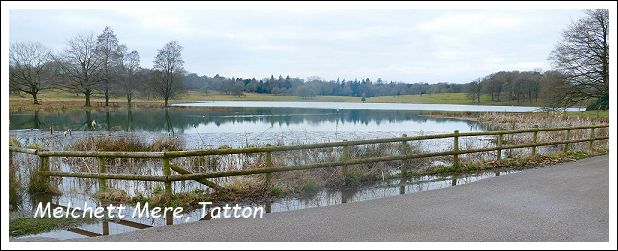 it's connected with the work in the channel. Several Snipe were along the new edge and a Green Woodpecker flew across to Moss Wood, perhaps puzzled by the changed geography.. Heron stalked the marsh. A Great Spotted Woodpecker drummed near the outflow stream. Mistle Thrush singing and a Raven calling. Two Siskins just above me at usual trees. Great views of the pair of Stonechats chasing and perching in the reeds next to the head-of-Tatton Mere 'pool' where several Pochard. Jays were also well in evidence as there were few walkers."...............
it's connected with the work in the channel. Several Snipe were along the new edge and a Green Woodpecker flew across to Moss Wood, perhaps puzzled by the changed geography.. Heron stalked the marsh. A Great Spotted Woodpecker drummed near the outflow stream. Mistle Thrush singing and a Raven calling. Two Siskins just above me at usual trees. Great views of the pair of Stonechats chasing and perching in the reeds next to the head-of-Tatton Mere 'pool' where several Pochard. Jays were also well in evidence as there were few walkers."...............Park Ranger, Darren Morris explained that the problem with the water level was caused by a blocked culvert that takes the overflow from Melchett and directs it into the main mere's outflow stream. It's now been sorted using a strong chain and lots of manpower!
Darren reports at least one Brambling with Chaffinches along the Knutsford Drive (3/3) and either a Willow or Marsh Tit near the Mill Pool last Thursday (3/3), unfortunately he didn't have his binoculars handy at the time. He's also kindly sent me a copy of the Tatton Spring Newsletter [click here to read it]. Thanks Darren.
Elsewhere Rostherne is proving a popular venue for a few hours birding in relative comfort. John Patterson had a male Common Scoter on the 24th February and the previous day Bob had a nice flock of Golden Plover amongst the local Lapwings .........".... then on to Rostherne. It was only 6C in the Observatory but after yesterday's trial by wind at Parkgate it was just about acceptable. Several Buzzards constantly in the air, a Raven was harassed by a Carrion Crow over Mere Covert, at least 90 Wigeon on the mere and a couple of drake Goldeneyes but the highlight was a flock of well over 100 Golden Plovers flying close to an even bigger flock of Lapwings (300+) on the other side of the mere!".......... Golden Plovers were much more common at one time, as there was a daytime feeding/roosting field at nearby Ashley; it's not been used since the field was dissected by the M56.
Ken Davies and I spent Monday morning in the Rostherne Observatory; a Cetti's Warbler was in full song from the reedbed on front of the obs. and, apart from "singing" Stock Doves, that was the only sign of Spring. 95 Wigeon remain on the mere, with four Goosanders and five displaying Goldeneye; none yet ready to move north. Ken had brought along four large Morrisons sausage rolls, remarkable value for only £1:75! Goostrey's remain closed but I noticed replacement windows have been fitted and the whole exterior repainted, so they should be reopening soon but I fear four large ones will be a lot more than £ 1:75!
Ken and Shirley have just returned from a couple of nights on the Wirral ........""Shirley and myself have just spent two nights at the Wirral Country Park Caravan and Motor home Club site, just above the Dee Sailing Club. At low tide the wader numbers were too great to even estimate, the main ones being redshank and dunlin with curlew black-tailed godwit, oystercatchers and turnstone . The highlight for Shirley being a large number of pintail (60+) Six Brent Geese, feeding on the slipway as the tide went out on the Sunday morning .On the Wirral way we had Goldcrest ,Bullfinch, Song Thrush Blackbird with the usual Blue tits ,Great Tits ,Long-tailed Tits, Goldfinch, Greenfinch and plenty of Robins.
Our next trip will be to Dumfries and Galloway can't wait ..........
I've taken the short walk from home down to Mobberley's Pavement and Gleavehouse lanes over the past week. Some evidence of birds on the move with a huge increase in the number of Lesser Black-backed Gulls joining the usual Black-headed. The horse paddocks are nicely churned up, just right for the expected Wheatears that will stop off there in the coming weeks. Peter Dawson passed that way too on his walk from home in Knutsford .........""I did a walk through Booths Park to Gleave House Farm this morning. Birds of note:
•Two pairs of goosanders and good numbers of shoveler are still present on Booths Mere.
•In the fields by the Mere there were pairs of both shelducks and oystercatchers and a small group of fieldfares. 2-3 buzzards circled overhead calling incessantly.
•A few linnets were in the trees by the bridge at the bottom of Pavement Lane.
•Approx. 6 meadow pipits were in the "little owl field". Once again no sign of the owl.
•Tree sparrows were chirping from the hedge by Gleave House Farm. Not sure how many, possibly just a pair. A single skylark was singing somewhere around the farm.
I finally had a brambling visit the garden a few days ago. Luckily I happened to look out of the window at the right time to see it as it only stayed for a couple of minutes before disappearing, never to be seen again! Also, a couple of nights ago I had good views of a tawny owl sitting out in a tree just over the back fence. ............
Geoff and Sheila Blamire have, of course, been taking their morning constitutionals. This being the latest from Monday (6/3) ...........""Monday: we did our Mere/Millington 11.5km walk this morning. Chosen 6 species to highlight:
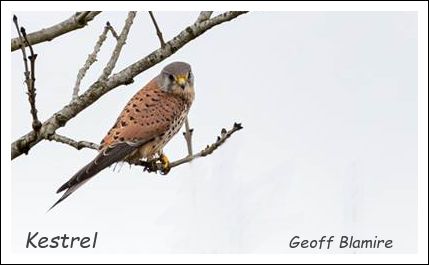 Little Mere – pair of Great Crested Grebes – thought they were going to start their display but they had second thoughts.
Little Mere – pair of Great Crested Grebes – thought they were going to start their display but they had second thoughts.Peacock Lane – pair of Yellowhammers (new pair).
Peacock Lane – 13 Lapwings in 1 field and next field 2 Lapwings. Been there for ages, with some display, but always spread out across the field – reminds me of nesting Gannets keeping a bill-length away from neighbours!
Millington Lane – Skylark singing, just after I said “I need to hear a Skylark to give me a lift” (I was flagging……)
Newhall Farm – Brown Hare (or Buzzard if you want 6 bird species).
Chester Road – male Kestrel which we kept flushing. ...........
Finally (and weather permitting) on Sunday (12th March) it's our March field trip to Wigan's Pennington Flash. Our hard-working Secretary, Karina will be leading the trip and has sent out the following missive -
Pennington Flash on Sunday 12th March 10 am.
Our trip next Sunday is to Pennington Flash.
They've upgraded the place (£2.7m grant to spend) and so far they have put in a new visitor centre and café.
The Hide Coffee House and Café opened on March 3rd. It'll be a welcome pit stop, especially if it's a bit chilly out there next weekend. Open 9am-4pm at this time of year. They will open 'til 7pm as from April.
https://www.wigan.gov.uk/Resident/Leisure/Greenheart/Pennington-Flash.aspx
Car parking has gone up, is contactless, and is now £2.50 per day. The main entrance is situated on St Helens Road opposite Leigh Fire Station. For Sat. Nav. users the postcode is WN7 3PA.
I'll be leading and will see you there at 10am. Last year we had splendid views of Willow Tit and saw 54 species. It would be good to know if you're planning on coming. karina[dot]stanley[at}ntlworld.com
A small group of mid-weekers made their way over to the Wirral peninsula yesterday (22/2) to enjoy the spectacle of one of the highest tides of the year (10.4M) as it swept in over Parkgate's reed beds. We weren't disappointed, as a strong north-westerly wind helped to push the water right up to the sea wall but it made the temperature of 6C seem a lot lower and standing out in the open for two hours was a bit of a challenge!
The old baths area was already crowded with birders when we arrived at 10:45am and we were fortunate to locate the last remaining parking spot. We joined Geoff and Sheila Blamire who'd
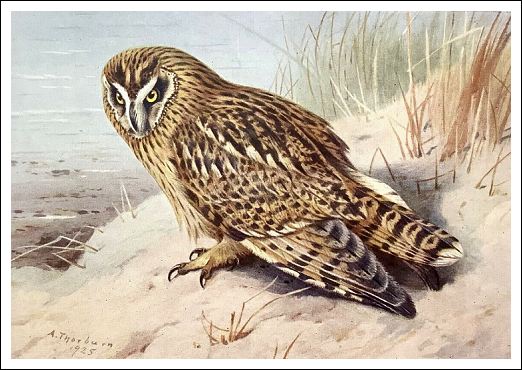 arrived before us and bagged a decent view point overlooking the marshland with the Welsh hills in the background.
arrived before us and bagged a decent view point overlooking the marshland with the Welsh hills in the background.It was two hours before the high tide at 12:50pm but there was already plenty of activity. Great White and Little Egrets showed prominently, five Great Whites and, I believe, 38 Little were counted. Marsh Harriers floated over the reeds, from time to time scattering the wildfowl - Teal, Shelduck, Mallard, Pintail and Wigeon all present in varying numbers. Pink-footed Geese constantly passed overhead, there must have been 100s if not 1000s in the area. A Kestrel patrolled the marsh looking for small mammals forced out of cover by the incoming tide, a Peregrine powered over but didn't linger, unlike a fine Short-eared Owl that landed in the reeds a short distance away, giving everyone spectacular views through the 'scopes. Waders were represented by good counts of Lapwings, five Greenshanks, just a single Black-tailed Godwit plus flocks of Dunlin and Oystercatchers well out over the estuary. We saw only one Grey Heron, on past visits there were many more but, of course, it's now their nesting season and they are no doubt fully occupied elsewhere. As the tide began to ebb we migrated to the Parkgate chippie; a small fish and chips £5:80p, more than enough and as good as ever!
Our "usual" correspondents have been out in the field again and sent me their valued contributions. During the first covid lockdown, in the Spring of 2020, no less than 39 different people sent me records so there's plenty of room for more and any reports or records would be most welcome!
Two reports from Geoff and Sheila. The first from Monday this week (20/2)......."We decided to do our Millington patch this morning and we were very pleased we did!
Chapel Lane: Yellowhammer singing with the female perched further down the hedge (same area from last year). First of Lesser Celandine blooms out.
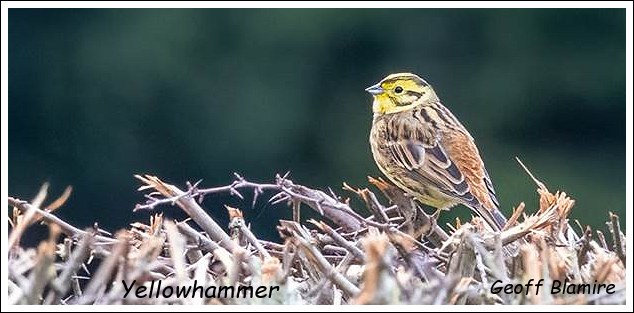 Peacock Lane: 12 Lapwings displaying and some soliciting in 2 cereal fields (same area from last year).
Peacock Lane: 12 Lapwings displaying and some soliciting in 2 cereal fields (same area from last year).Millington Lane: Skylark singing over cereal field (heard on 15 Feb as well). "...........
The following morning (21/2) found them out at Plumley ........"Yesterday we did our Plumley/Holford/Lostock Green walk. Started off well with 2 Yellowhammers singing, flock of 27 Linnets, 200 Starling and flock of 50 winter thrushes (approx 25 Fieldfare, 25 Redwings).But them came across 4 Brown Hares in a grass field – very close. They were very nervous of us then the testosterone over-ruled their wariness. We spent ages watching the 3 males chasing the female. We saw boxing, fur flying, jumping over each other, and 1 time a brief mating. They run across the road and into another field. By then the female disappeared having shaken off her pursuers. Definitely the best ever sighting:"............
I spent a couple of hours at Rostherne on Monday in the agreeable company of Jude Halman, Ken Davies and Bob Groom. Not much about - 87 Wigeon, 3 Goosander, c.80 Lapwings, 13 Shoveler, 5 Buzzards but it was nice to be out in the fresh air again after the previous weeks 'flu bug! Bob had more luck after we'd left .......""Another spring-like day, Min 7C Max 14C. A trip over to Rostherne Observatory was rewarding. The female Great Spotted Woodpecker was again drumming on the split lime. About 150 Lapwings put in an appearance. Buzzards were numerous, up to 8 in the air at once at one point. But the highlight was a really spectacular encounter over Mere Covert. A Raven appeared and was displaying - somersaults, rolls, dives, wonderful but a Buzzard took exception to this big bird showing off over its wood and went for the Raven. A prolonged dog fight ensued with lots of Jackdaws as spectators. Neither bird came out as the winner but eventually they disengaged. I checked the corner field from the village and like G & S noted scores of Fieldfares and Redwings but just then someone appeared at the gate and they all went up into the trees and then a helicopter went over and they departed into the distance, as did the smaller birds (which could have been linnets) with them. All a bit frustrating but the Raven was the day's star bird. .........
Remember tomorrow night it's our February indoor meeting. A Gordon Yates film night - "Pennine Birds" (55 minutes) with an interval followed by "The Wildlife of Spitsbergen "(25 minutes). Non-members will be most welcome.
 |
Species recorded at Parkgate 22 February 2023 |
17th February 2023......... The Tatton Trip and SMC '23 entries
One of the few good things to come out of the covid pandemic was the fact that common colds and influenza took a back seat for the duration. I hadn't had a cold since 2018 but this temporary respite came to a sudden end last Friday (10/2) when Olwen and I both went down with a particularly nasty bug; it was my birthday too! So I was unable to lead the Tatton Trip the following morning, fortunately
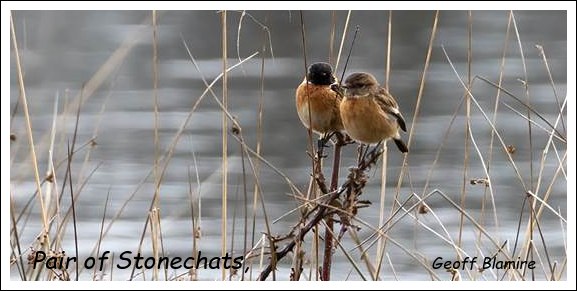 Sheila Blamire was still at home when I rang and she kindly agreed to take the reins. They did very well too, 45 species during the morning was good going. Thanks Sheila!.........."12 people met up in Dog Wood layby for our annual walk around Tatton Park. Spring was definitely in the air. The first bird we heard was a Song Thrush singing behind the Crosstown Community Orchard. On the moor pool a Moorhen was collecting nesting material. Entered Tatton Park via Knutsford Gates and were greeted by a Great Spotted Woodpecker. Then we arrived by the Higmere Plantation and counted 10 occupied nests in the heronry. Several Pochards and Goldeneyes were on Tatton Mere but no Great Crested Grebes – we had to wait until we saw just one on Melchett Mere. But the pair of Stonechats didn't disappoint - they posed very nicely for us by the mere. And a Kingfisher flew down the length of the mere – just a glimpse of an electric blue dart. All in all, a lovely walk."..........
Sheila Blamire was still at home when I rang and she kindly agreed to take the reins. They did very well too, 45 species during the morning was good going. Thanks Sheila!.........."12 people met up in Dog Wood layby for our annual walk around Tatton Park. Spring was definitely in the air. The first bird we heard was a Song Thrush singing behind the Crosstown Community Orchard. On the moor pool a Moorhen was collecting nesting material. Entered Tatton Park via Knutsford Gates and were greeted by a Great Spotted Woodpecker. Then we arrived by the Higmere Plantation and counted 10 occupied nests in the heronry. Several Pochards and Goldeneyes were on Tatton Mere but no Great Crested Grebes – we had to wait until we saw just one on Melchett Mere. But the pair of Stonechats didn't disappoint - they posed very nicely for us by the mere. And a Kingfisher flew down the length of the mere – just a glimpse of an electric blue dart. All in all, a lovely walk."..........The Rostherne observatory continues to attract a steady flow of KOS members, it's not the most exciting locality for the birder of course but it's a pleasant place in which to spend a couple of leisurely hours. Bob Groom was there on Tuesday (14/2) and again watched a female Great Spotted Woodpecker drumming........"" Still a Southerly airflow. Noticed the Saharan sand on our cars? Despite the mild spell I felt uncomfortably cold in the Observatory when I went over to Rostherne for a couple of hours. The female Great Spotted Woodpecker made 3 visits to the top of the split lime for drumming sessions in the time, All very intriguing................
Geoff and Sheila also noticed the woodpecker ........."We were there earlier and saw the female GSW drumming in Wood Bongs (as well as top of the elms). Almost like she's seeking a male GSW! I spotted her drumming branch – the sound was very loud. But then she moved to the top of branch (much thinner) and her drumming was more high-pitched. From the obs we had 2 female Bullfinches, 5 Goldeneyes (3m 2f) and 2 Goosanders (1m 1f), etc.
The corner field between New Road and Rostherne Lane in the village was covered in Fieldfares! Conservative estimate was 130+ Fieldfares, and 12+ Redwings and also Linnets but more difficult to count them because of the terrain and because we didn't want to spook the Fieldfares."........... Bob and I have seen female GS Woodpeckers drumming in Tatton's Dog Wood in previous Springs. It's a well-known phenomena and apparently the birds can recognise each other by their individual drumming rhythms.
The closing date for entries to the 2023 KOS Sand Martin competition was on Wednesday (15/2). 35 entries this year, 8 more than last. Estimates cover a whole month, from 23rd February through to 24th March! The most popular choice is 2nd March with 4 people choosing that option; four dates each had 3 people's backing - 7/3, 8/3, 11/3 and 14/3. You can see all the runners and riders by clicking here.
Finally, next Friday (24th February) it's our monthly indoor meeting and you're in for a real treat! We have obtained permission from wildlife film maker Gordon Yates to show two of his videos in public for the first time. We will be featuring "Pennine Birds" and "Polar Bears and other Wildlife of Spitsbergen". Non-members will be welcome to come along and enjoy some of Gordon's finest work. The venue is the Jubilee Hall, Stanley Road, Knutsford, WA16 0GP. We will be there from 7:15pm for an 8pm start.
Species recorded in Tatton 11th February 2023 |
9th February 2023.......The lad's done well!
Perusing the KOS's records, with Treasurer Frank Dearden, we noticed the name - Master Armitt from the days when we had a junior section! That self-same Barrie Armitt is now more than old enough for a bus pass but still birding. We must have been doing something right as a number of juniors from that era are still out in the field!
I wrote (on 26th October 2022) about his visible migration (viz-mig) activities and the amazing count of 122,600 Redwings passing his vantage point in Crosby on 19th October 2022. This dedication caught the eye of Birdwatch magazine and he has been rewarded with a pair of Celestron Nature DX ED 8X42 binoculars - "Local birding movement of the year" - Nice one Baz!!
Still over on the west coast Ken and Shirley Davies paid a recent visit to Southport in their motor home............. Shirley and myself away again in the motor home, this time to Southport......."Not one of our best trips as Shirley decided to practise her dancing skills and didn't see a small slope on the way out of the shop falling and severely spraining her ankle ,and we only went shopping for a new strap for my binoculars (so it was my fault).
Didn't go far from the site but I did leave her with a full kettle for a brew . The only birds of note was a singing Song Thrush as I left the site with several Stonechat on the coastal path.
Sunday morning we drove to Marshside but this time I left Shirley with a good book. Just past the entrance to the RSPB hide, looking out to the estuary, I was helped by local birders in spotting Merlin, Kestrel, Marsh Harrier, Hen Harrier, Peregrine and a Buzzard, with nothing of note on the marsh only Snipe. The list of birds more or less as seen on our visit just two weeks earlier"............ Thanks Ken, nice to see chivalry alive and well in Middlewich!
On Monday morning (6/2) a small group of KOS members gathered in the observatory at Rostherne Mere for tea or coffee, a sausage roll, a chat and a bit of birding. In the continuing absence of Goostrey's sausage rolls, Ken
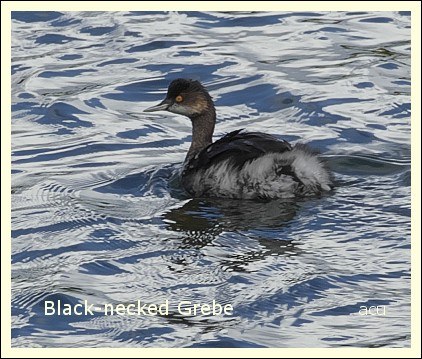 provides the same items from Morrison's. A lot cheaper and quite acceptable but when the Mobberley bakery re-opens (in March apparently) we'll probably switch back. A cool morning, just
2⁰C
, and nothing special but, just after Jude Halman and Geoff and Sheila Blamire had left, we were pleased to have excellent views of a black-necked Grebe. Bob Groom summed things up nicely........""Joined the gang at the Observatory. A productive visit and I stuck it for over 2 hours before giving in to the cold. The star bird was a Black-Necked Grebe that appeared near the boathouse and then quickly disappeared into the reedbed, not to be seen again. Unusual for Rostherne an Oystercatcher had been seen earlier on, flying round, calling. Phil had also seen a Snipe and a Woodcock. Entertaining the KOS contingent, two Sparrowhawks interacted and 4 Buzzards just qualified as a kettle. A female Great Spotted Woodpecker did some drumming, well recognized in the literature and presumably territorial. Approx 260 Lapwings put in an appearance beyond the mere, as usual. Two drake Goosanders vied for the attention of a female. Wigeon, Shoveler and a couple of Goldeneyes on the mere. Near the NE car park I got surprisingly close to a sunbathing male Reed Bunting. Also seen a Kestrel and a party of Goldfinches, but again no Linnets.............
provides the same items from Morrison's. A lot cheaper and quite acceptable but when the Mobberley bakery re-opens (in March apparently) we'll probably switch back. A cool morning, just
2⁰C
, and nothing special but, just after Jude Halman and Geoff and Sheila Blamire had left, we were pleased to have excellent views of a black-necked Grebe. Bob Groom summed things up nicely........""Joined the gang at the Observatory. A productive visit and I stuck it for over 2 hours before giving in to the cold. The star bird was a Black-Necked Grebe that appeared near the boathouse and then quickly disappeared into the reedbed, not to be seen again. Unusual for Rostherne an Oystercatcher had been seen earlier on, flying round, calling. Phil had also seen a Snipe and a Woodcock. Entertaining the KOS contingent, two Sparrowhawks interacted and 4 Buzzards just qualified as a kettle. A female Great Spotted Woodpecker did some drumming, well recognized in the literature and presumably territorial. Approx 260 Lapwings put in an appearance beyond the mere, as usual. Two drake Goosanders vied for the attention of a female. Wigeon, Shoveler and a couple of Goldeneyes on the mere. Near the NE car park I got surprisingly close to a sunbathing male Reed Bunting. Also seen a Kestrel and a party of Goldfinches, but again no Linnets.............The Grebe was a tatty looking individual, I thought it was a first Winter bird and would have expected an adult to have regained it's breeding plumage by now.
The Oystercatcher was one of a number that have been recorded recently, prior to the breeding season. Peter Dawson had one at Booths Mere, a couple of weeks ago ............"" A single oystercatcher was back at Booths Mere today. In addition to a good number of shoveler there were also a few pochard about. Unfortunately it's hard to count anything on the Mere because viewing is so restricted wherever you are looking from. No sign of either owl from Pavement Lane.
After some months of not hearing any tawny owls from Sanctuary Moor they reappeared again about a week ago. I haven't managed to see one yet but they are calling/hooting most mornings and evenings at the moment.
Brambling reported again in Tatton Park this morning in the usual area."".............
Geoff and Sheila missed the Black-necked Grebe on Monday, just a short stay on their daily slog but they are accumulating some good records. This from the previous morning (5/2)........"We did our 11km walk around Plumley/Holford/Lostock Green, parking on Cheadle
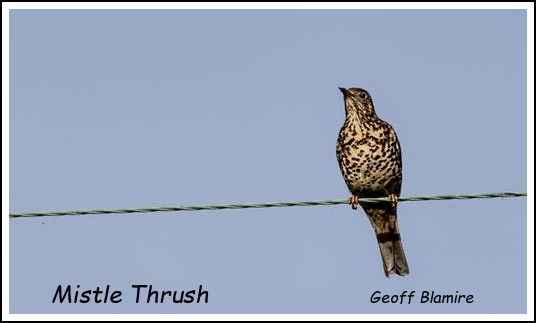 Lane, near Keeper’s Cottage. Can’t list all the birds it will take me too long! So just the highlights:
Cheadle Lane: 300+ Starlings, 40 Fieldfare and 31 Curlews flew over. Little Egret in the horse field – been there since 1st Jan!
Past Keepers Cottage: 10 Pied Wagtails with sheep feeding on harvested swede.
Set-aside field before the bridge over the railway: 200+ finches - 50% Chaffinches/50% Reed Buntings and a few Lesser Redpolls (I know it adds up more than 100%!). And a Kestrel.
Patmos Lane: male Yellowhammer – first one seen this year.
Also on the walk: several smaller flocks of Starlings, Fieldfares and Redwings. And 7 Song Thrushes (6 singing) and a Mistle Thrush.
"............. Thanks team, you're doing well for Song Thrushes still none in song around here.
Lane, near Keeper’s Cottage. Can’t list all the birds it will take me too long! So just the highlights:
Cheadle Lane: 300+ Starlings, 40 Fieldfare and 31 Curlews flew over. Little Egret in the horse field – been there since 1st Jan!
Past Keepers Cottage: 10 Pied Wagtails with sheep feeding on harvested swede.
Set-aside field before the bridge over the railway: 200+ finches - 50% Chaffinches/50% Reed Buntings and a few Lesser Redpolls (I know it adds up more than 100%!). And a Kestrel.
Patmos Lane: male Yellowhammer – first one seen this year.
Also on the walk: several smaller flocks of Starlings, Fieldfares and Redwings. And 7 Song Thrushes (6 singing) and a Mistle Thrush.
"............. Thanks team, you're doing well for Song Thrushes still none in song around here.Also amongst the Thrushes Jean Brooks and Derek Pike, on Monday morning (5/2) .........."We went to the Lovell Quinta Arboretum this morning to have a look at the superb display of Snowdrops. Between 30000 to 40000 have been planted and they are expected to last about three weeks,
In adjacent field was the largest number of Fieldfare/Redwing we have ever seen I estimated between 600-700 hundred in top of field and a further 100 or so in bottom of field and bushes plus some in Arboretum, fantastic!
Other birds of note G S Woodpecker drumming one short song from Song Thrush. Several Buzzards, Kestrel.
Lovely tranquil place to visit £2.50 for none members, plenty of leaflets to show you the way round. Swettenham Arms next door closed for refurbishment "...........
This coming Saturday (11th February) it's our KOS walk around Tatton Park. We'll be gathering in the usual Dog Lodge layby at 09:30am. The weather looks good and, although we're unlikely to see this year's first Sand Martin, there are Bramblings about and Jayne Davies tells me that the Heronry in Higmere Plantation is already a hive of activity.
You may want to let me know if you're coming along on Saturday, as I'm the trip leader. tony@10X50.com
1st February 2023.............. The Big Garden Birdwatch.
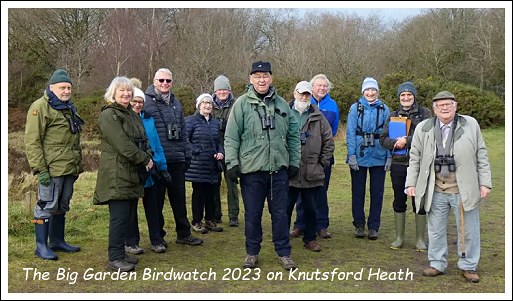 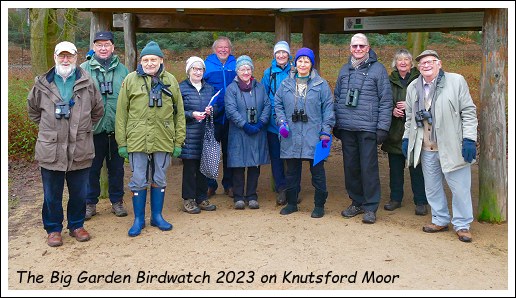 |
Yesterday Defra published a revised version of the plan, originally created in 2018, to restore 500,000 hectares of wildlife habitats, create 25 new or expanded nature reserves and restore 400 miles of river. It's a 25 year plan that will ensure that all households will live within a 15 minute walk of a "green space" (apparently a green space can mean a playing field, a disused railway or an allotment!)
The BBC has a good piece about the plan click here with a graph showing the change in abundance of 149 priority species since 1970.
It's a nice simple graph and I wondered where the data used to draw it came from. I suspect if they relied on professional ecologists (who normally make their money counting newts on proposed building sites) it would cost a fortune. Perhaps they rely on cheap data generated by organisations such as Butterfly Conservation, BTO, RSPB and others.
Last year 700,000 people took part in the RSPB's Big Garden Birdwatch recording 11,000,000 individual birds - plenty of data to look at there!. Citizen Science in action!
We did our bit over the weekend when we assisted the Friends of the Moor (Saturday) and The Friends of Knutsford Heath (Sunday) with their counts.
On Saturday the weather was much kinder than last year, when we had to contend with storm "Malik", and we managed to record 26 species and 143 individuals (total of the maximum number of each species seen at any one time). 3 more species than last year but 9 short of 2016's record of 35.
Similar conditions the next day, on the Heath. Just 17 species and 45 individuals but there's no water on the Heath and the habitat is not as diverse. Still it was nice to see Treecreeper and enjoy prolonged
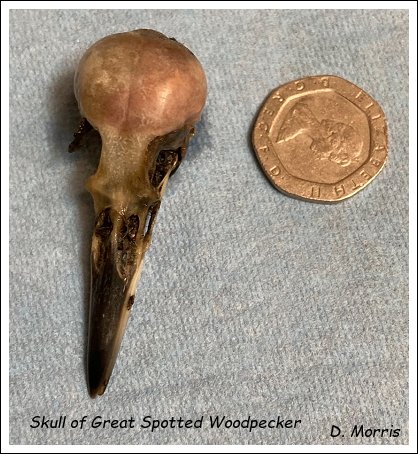 views of a Goldcrest, in bright sunlight, hovering in the branches of an oak tree, picking off insects. Thanks to the two organisations for inviting us along and thanks to all KOS members who helped out.
views of a Goldcrest, in bright sunlight, hovering in the branches of an oak tree, picking off insects. Thanks to the two organisations for inviting us along and thanks to all KOS members who helped out.In Mere Geoff and Sheila Blamire did the BGBw in their own garden but not before they stretched their legs earlier in the appropriate manner......"This morning we did our Rostherne area walk. Most notable:
The field on the right before the crossroads in Rostherne on New Road: c150 Fieldfare, 3= redwings, 25+ Starlings, c80 flock of finches (30 Chaffinches, 30 Goldfinches, plus other species) – all in harvested wurzels!
Rostherne Lane: c70 Redwings (but on the reserve side).
Observatory: 3 Goosander (1m), 3 Goldeneye (1m), 6 Long-tailed Tits appeared on the bird table as we were to leave.
This afternoon we did our Garden Birdwatch: 19 species actually seen in the garden – 18 Blue Tit, 2 Great Tit, 2 Coal Tit, 6 Long-tailed Tit, 3 Blackbird, 2 Robin, 2 Dunnock, 1 Nuthatch, 1 Chaffinch, 4 Goldfinch, 4 Jackdaw, 2 Magpie, 1 Pheasant, 1 Great Spotted Woodpecker, 1 Wren, 5 Woodpigeon, fem Siskin (very briefly), pair Bullfinch (again briefly) and 1 Sparrowhawk – twice!!! Total birds = 59, 19 species. "...............
KOS secretary Karina Stanley is one of only a handful of members still gainfully employed and, on her way to work at The Christie, has seen a Barn Owl in her car headlights whilst driving through the Ashley area, during both morning and evening commutes. Last Monday (23/1) she had a quick view of an even bigger owl but was unable to stop safely, so that one will remain an intriguing mystery for the time being.
On the subject of Owls, Tatton Ranger Darren Morris sent me the image you see on the left; it's the skull of a Great Spotted Woodpecker that he found in a Barn Owl pellet he was examining - a member of the Knutsford Nature Notes Facebook group said ..........."Wow interesting! Trying to think of a time and place when those 2 species would cross paths!"...........
Don't forget to enter the Big KOS Sand Martin Competition before it's too late. It's open to anyone, there's no entry fee, it's easy, you can complete it in 60" and there is a small prize for the winner! click here.
25th January 2023......... Rostherne Cormorants
As the name implies, the "tick list" in the Rostherne Mere observatory is a binary affair - 0 or 1; tick or no tick. It doesn't indicate the number of each species, just whether or not at least one individual was present on a given day. Perhaps not as useful as the monthly wildfowl counts or the CBC and BBS surveys but, over a period of years, the simple and easy to understand tick list can show long term fluctuations in our bird populations.
There are some species that are recorded on the tick list every day, amongst these is the Cormorant. Until the end of the last century it was just a Winter visitor but in 1999 they remained on the reserve and nested for the first time. In 2021 the colony, located in the mereside trees of Harper's Bank, held 173 nesting pairs. Reading the appropriate literature
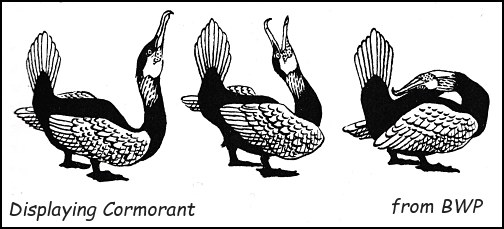 it appears that tree colonies never become permanent as the guano generated by the birds kill off their host trees. This has happened at Rostherne; the trees are dead but, despite this, the Cormorants have returned and, once again, begun nesting. Ken Davies and I were in the obs. on Monday (23/1) and, with the aid of Ken's Swarovski, spent some time observing the comings and goings. Male birds sat on their nests with wings quivering, heads pointing upwards and cocked tails spread upwards and backwards. Established pairs stood side by side, in one case sharing a piece of nesting material jointly in their bills. Fascinating stuff, about which there is little online, so I had to dig out volume one of BWP!
it appears that tree colonies never become permanent as the guano generated by the birds kill off their host trees. This has happened at Rostherne; the trees are dead but, despite this, the Cormorants have returned and, once again, begun nesting. Ken Davies and I were in the obs. on Monday (23/1) and, with the aid of Ken's Swarovski, spent some time observing the comings and goings. Male birds sat on their nests with wings quivering, heads pointing upwards and cocked tails spread upwards and backwards. Established pairs stood side by side, in one case sharing a piece of nesting material jointly in their bills. Fascinating stuff, about which there is little online, so I had to dig out volume one of BWP!The wildfowl were mostly hidden away amongst the mereside vegetation, so trying to count them was impossible. The previous day (22/1) a monthly count had taken place revealing 157 Teal, 134 wigeon, 110 Mallard, 32 Mandarin, 20 Shoveler, 49 Canada Geese and 3 Goosanders.
The bird table was very busy, we saw a small group of five Siskins and a Great Spotted Woodpecker was heard drumming; a sure sign of the warmer weather to come.
On a walk around the lanes of Mobberley last Sunday (22/1) there was a woodpecker drumming in Spring Wood, clearly heard from the best part of a kilometer away. I headed in that direction, on the way passing a field of c.100 corvids - Jackdaws and Rooks (the rookery in Shawheath is just a short distance away) and, in another field, c. 200 winter thrushes, 95% of which were Redwings. I didn't find the woodpecker but at the confluence of the Marthall and Pedley brooks, where they become the Birkin, I came across a Little Egret only the second I've ever seen in the village!
Just across a couple of fields is Booths Mere, a spot that Peter Dawson keeps an eye on. This from last Wednesday (18/1)........."Once the sun had come out and the snow had started to disappear, I had a wander around Booths Park early afternoon. Of note, there were approx a dozen mandarin on the Mere, mainly males. I've seen them there before but only the odd one or two. Also about the same number of shoveler, a mix of male and female, and 3-4 pochard. Otherwise just the usuals. Still no brambling in the garden. I haven't seen many reports from anywhere of them this winter. However they often don't turn up until Feb or March so there's still time yet.".......... Thanks Peter, no Bramblings (or Siskins) for us yet either but, as you point out, they'll appear eventually.
The warmer weather hadn't arrived by last weekend but the continuing cold snap didn't deter Bob Groom (18th Jan) ..........."Whatever happened to the mild Southerly air we were promised for this weekend? It seems it slowed down when it reached the south-west and instead we are stuck with the ice and snow and low temperatures - Min -6C Max 4C - and it will be midweek before milder air replaces the frosty air. Elaine and I had to cancel our trip into Tatton with the road still closed and Moss Lane was too icy so we had a productive walk on Green Lane (which had been gritted) instead. Close views of Buzzard, Kestrel and Sparrowhawk. Only a few Redwings and a single Fieldfare. 44 Lapwings at a distance and another bird flying with them that might have been a Golden Plover. The ditches were full to the brim but frozen solid and covered in red grit."............
The Blamires too remain determined to get out and about whatever the weather and Mondays walk took in the Rostherne obs............" Mereside Road: 100+ Fieldfares. Rostherne Brook area: 2 Lesser Redpolls (with Goldfinches), Song Thrush singing, Wren investigating the leaky dam , female Bullfinch.
Oxhey Meadow: 22 Fieldfare, 3 Redwing.
Obs (with Tony and Ken): Great Spotted Woodpecker drumming (good to hear) and just as we were leaving Tony spotted c5 Siskins. "..................
The Sand Martin Competition now has 30 entries, from as far away as Maryland (USA), Auckland (New Zealand) and Warrington! So get your entries in NOW before you forget. A reminder that it's open to everyone, not just KOS members. click here.
Members will be having a busy weekend, starting on Friday ((27/1)
On Friday 27th January it's indoors at the Jubilee Hall when Mike Watson will be telling us about the Northern Territory of Australia. Doors open at 7:15pm for an 8pm start
The following day (Saturday 28th) we're on the Moor with the Friends of the Moor helping with their "RSPB Big Garden Birdwatch" - 11am start, meeting at the shelter on the Moor
On the Sunday (29 January), were on the Heath with the Friends of Knutsford Heath for their "Big Garden Birdwatch" - again it's an 11am start at the information board on the heath. Close to where Stanley Road meets Northwich road.
The KOS committee will be meeting next week to discuss the programme for 2023/2024 and preliminary discussion will take place about how we celebrate the society's 50th anniversary!!
I believe that only three current members were at that first meeting, on the 29th April 1974, when Colin Istead suggested the possible make-up of the first committee. This was voted on and his suggestions accepted by those present. The first "proper" meeting took place the next month when Bill Mulligan introduced the speaker, Sidney Bunker who entertained us with his bird song recordings on an old reel-to-reel tape recorder!
18/01/2023...... The trip to Marshside & Martin Mere
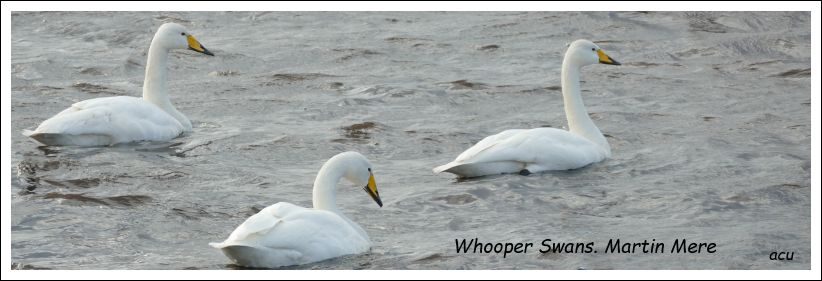 |
We're enjoying another cold(ish) snap at the moment with a mid-morning temperature of 0⁰C in the back garden. It will be over by the weekend and get nowhere near the -6⁰C we experienced in the run-up to Christmas.
My weather station measures the temperature once every minute and analysis of the data produced showed that the overall average in 2022 was 0.8⁰C warmer than 2021 ( 11.2⁰C v 10.4⁰C )
A bit wet to begin with on Saturday, (14/1) for our January field trip up to Marshside and Martin Mere but the rain soon moved off, leaving a dry but very windy day.
We'd not left the car park at Marshside before eagle-eyed Bob Groom found us a splendid male Hen Harrier, close in, flying slowly into the wind over the shoreline - an excellent start to proceedings. Number #1 on the day-list that eventually grew to 60 different species.
As it was still drizzling we walked to the RSPB's hide/information centre and set up shop overlooking the marsh, which was heaving with wildfowl and waders. Wigeon, Canada Geese, Greylag Geese, Pink-footed Geese, Mallard, Shoveler, Shelduck, Gadwall, Pochard, Teal plus Lapwing, Golden Plover, Black-tailed Godwit and Oystercatcher. All in a constant state of flux; I don't know how they are ever counted but they must be as the RSPB's website gives target figures for the different species ..........."We aim to ensure that black-tailed Godwits and ruffs remain present through the breeding season and that breeding wildfowl numbers are stable. Meanwhile, our October-March targets for non-breeding birds include 1,650 black-tailed Godwits, 700 pink-footed geese, 6,000 wigeons, 1,800 teals, 140 shovelers, 500 golden plovers, 700 oystercatchers, 1,500 knots, 1,500 dunlins and 300 curlews."..........
We learnt that Nell's hide, further up the marsh and a normal stopping point for us, had been vandalized and was closed. Instead we headed into Southport as, earlier in the morning, Colin Butler had seen a flock of Twite and a Snow Bunting close to the pier. On a more benign day it would have been an easy stroll along the promenade up to the appropriate spot but the gale force wind on Saturday made it a bit more of a challenge. Anyway, with coats flapping, hats flying and eyes watering, we all made it and had reasonable views of the flock of c.40 Twite but, unfortunately, the single Snow Bunting had moved on - however it has been included on the list as Colin was part of the group and the rule is "any bird seen or heard by any member of the party"! Of course this has led to a few contentious additions in the past but, as we all know, "it's only birdwatching, no one dies"
On then to Martin Mere. The prices in the restaurant seemed quite reasonable; I paid £2:50 for a large americano and joined others from the party outside on the veranda as we'd brought our own food.
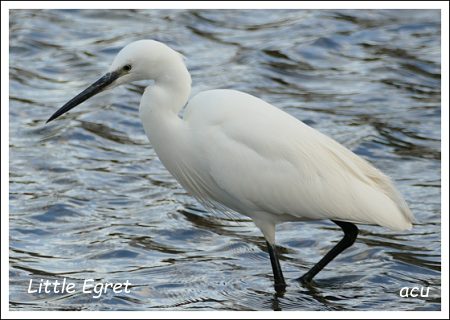 It was a cool spot and, given the conditions, one of the staff invited us to sit inside. A nice gesture and one which was readily accepted!
It was a cool spot and, given the conditions, one of the staff invited us to sit inside. A nice gesture and one which was readily accepted! Out on the reserve five Marsh harriers floated over the reedbeds and a Peregrine quartered the area from time to time but on the whole we thought numbers, especially Pink-footed Geese, were down compared with previous years. From the Ron Barker hide a Great White Egret and a Grey Heron sheltered from the wind at the waters edge in the lee of the reeds. Making our way down to the Janet Kear hide I noticed a Little Egret in the pool in front of the flamingo enclosure, it was unconcerned by visitors walking by and posed nicely for the camera.
Around the Kear hide Treecreeper, Reed Bunting, Greenfinch, Long-tailed Tit, Blackbird and Goldcrest all helped to swell the day-list. A useful and, most importantly, up-to date record of species present at Martin Mere is kept on the website. click here.
Back in Cheshire the colder weather brought a sprinkling of snow overnight, in fact a few places had some yesterday. This from Sheila Blamire after returning home from their daily meander........"It’s snowing here as I’m typing!
Did 11.5km around Millington area this morning – a little icy in places! Difficult with the poor visibility but a lot of winter thrushes: Mereside Road – 60+ Fieldfares; Peacock Lane – c40 Redwings, c10 Fieldfares plus c20 Starlings. Also Buzzard."..........
Birding webcams abound during the breeding season but there are fewer in Winter. One of the better ones is situated at Loch Garten, up in Speyside. As well as the usual, Coal and Great Tits, from time to time a Crested Tit will appear plus Great Spotted Woodpecker and Red Squirrel. Well worth a look. click here. If it's currently night time just click back on the red time line for earlier footage.
Only 20 entries so far in the Great 2023 KOS Sand Martin competition, so you're in with a chance! Open to all click here. Done and dusted in 60"!!
Species recorded on the KOS trip to Marshside and Martin Mere. 14th January 2023. |
 |
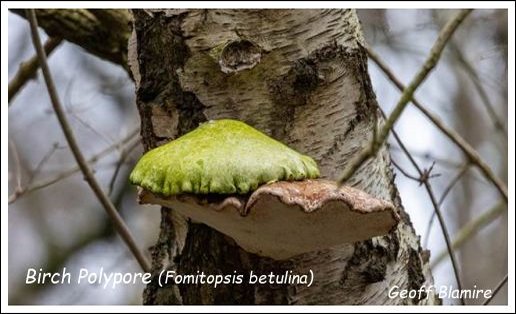 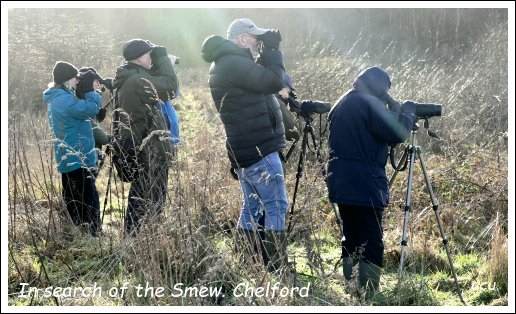 |
Finch flocks are building up locally. Last Saturday Sheila Blamire spotted a Siskin in the garden at Mere, the first since April 2022. In Knutsford Peter Dawson has Siskins plus Redpolls on his feeders and Sheila and Geoff had 60+ Siskins at Rostherne on one of their early morning walks. Here in Mobberley we've not had either species so far but there's plenty of time as they don't normally turn up until mid-February.
On Sunday (8/1) KOS Secretary Karina Stanley added a new species to her year list with a visit to Chelford for the Smew on Lapwing Hall Pool..........."A quick diversion to Lapwing Lane en route to Northwich for food shop. Nice views of The Smew [✓] and other wildfowl were available. Close encounter with a female sparrowhawk as she flew low across the grass and watched enthralled as a male kestrel hovered a few yards away, strategically going lower and lower, before successfully diving for a mouse snack. Great view as he flew triumphantly away with his prey and nipped its neck. "...............
Not to be outdone, we hastily organised a mid-week morning to same location! There was plenty to see on the Acre Nook lake, just a few yards up from the Lapwing Lane car park.
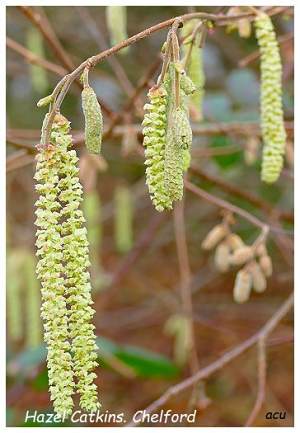 Unfortunately the island has now vanished but there were still large numbers of Lapwings on the far bank, where a Great White Egret stood guard in the shallows. On the water a nice selection of water fowl - Wigeon, Tufted Duck, Mallard, Teal, Goldeneye, Great Crested Grebe and Coot.
Unfortunately the island has now vanished but there were still large numbers of Lapwings on the far bank, where a Great White Egret stood guard in the shallows. On the water a nice selection of water fowl - Wigeon, Tufted Duck, Mallard, Teal, Goldeneye, Great Crested Grebe and Coot.Our time 'scoping the lake was brought to an end by a short, sharp shower of ice cold rain; so it was off to the sheltered lane leading to Lapwing Hall Pool. En route, growing on a birch tree, we noticed the bracket fungus you can see on Geoff's picture at the top of this update. This engendered a certain amount of discussion but with 15,000 species of fungus to go at we were floundering! Anyway, after consulting an expert, it seems that both are examples of Birch Polypore and the green appearance of the upper example is caused by algal growth. There's a whole new world out there!
We didn't have to look too hard for the male Smew, it was floating in the inlet, close to the entrance gate. Poor views though as this stretch of water is obscured by dense shrubbery. Further round the lake good views of other occupants, including more Wigeon and nine Goosanders (5♂ and 4♀), looking splendid in their fresh Spring plumage. A single Snipe leapt up from the edge of the pool and a Great Spotted Woodpecker was heard drumming in the distance. We finished off with excellent views of a Goldcrest, feeding low in moss-covered hawthorn, too quick for our cameras unfortunately!
Fortunately the hazel catkins were moving slower than Chelford's Goldcrest and I was able to get a decent image. It looked great - one of the first signs of Spring - of which we've had further examples, as well as the drumming woodpecker, Sheila and Geoff report singing Mistle Thrushes at three different locations and Bob Groom had a Song Thrush in song on the morning of our recent trip to Budworth mere.
Don't forget tomorrow (14/1) it's our field trip to Marshside and Martin Mere, meeting up at 10:00am at RSPB Marshside from where we'll be making our way over to Martin Mere for lunch and then onto the reserve for ducks, geese, swans and harriers (hopefully)
Remember also to enter our world famous Sand Martin Competition. Do it NOW by clicking here it's open to anyone, not just KOS members. You can do it less than a minute!
Species recorded at the Chelford sand quarries 11th January 2023. |
6th January 2023........Drake Smew at Chelford and the 2023 Sand Martin Competition
It's often said that the one good thing about waking up with a hangover is that the rest of your day can only get better. I find that, even without the aid of alcohol, you can normally induce the same effect by listening to the "Today" program on Radio four.
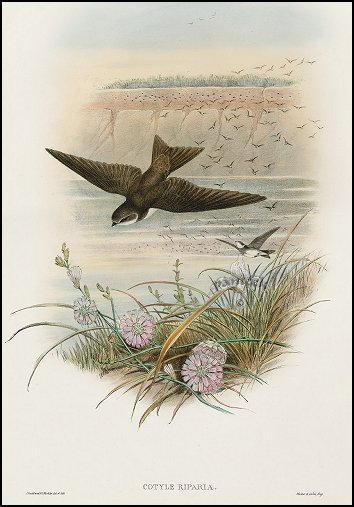 A bit of a letdown this morning to discover that, despite the ongoing strikes and Putin's war in Ukraine, the focus was on the continuing royal family soap opera. Perhaps the BBC think we've had enough bad news over the past few months and we needed a little bit of comedy to start the day.
A bit of a letdown this morning to discover that, despite the ongoing strikes and Putin's war in Ukraine, the focus was on the continuing royal family soap opera. Perhaps the BBC think we've had enough bad news over the past few months and we needed a little bit of comedy to start the day.Of course the rest of the natural world, of which we're just a small part, carries on regardless. This morning a Dunnock was going full belt from the silver birch at the bottom of the garden, whilst below it the daffodils are pushing through nicely, ready to bring a splash of colour in just a few weeks time, a reminder that Spring's just around the corner.
Regular visitors to this website will know that, in this part of the world, Spring officially begins with the appearance of the first Sand Martin over Tatton Mere and this year I'll again be running the KOS Sand Martin Competition, in which visitors are invited to estimate (guess!) when the first Martin will be recorded. The competition is not just for KOS members, anyone can enter and there will be a small prize for the winner. The average arrival date in Tatton is the 14th March, last year it was the 8th March and Cheshire's earliest record is the 16th February, so the closing date is the 15th February. Remember it's not you that has to see the bird, there will be plenty of KOS members (some of whom work in the park) keeping a daily watch from mid-February. You can enter by clicking here, it will only take a few seconds of your valuable time!
I spent a couple of hours in the Rostherne Obs. on Monday morning (2/1) just 3⁰C but crystal clear visibility and through the big binoculars set to 40X, I could make out people walking along the skyline next to the tower on Rivington Pike, about 22 miles away!
Most of the wildfowl were hidden away around the edges of the mere but a small flock of Teal were very active and a group of Mandarins appeared, 7 birds - six males and a lone female, the boys were most vigorous in their attempts to impress the young lady.
Geoff and Sheila Blamire began the year, as they left off, with a muddy trudge around one of their
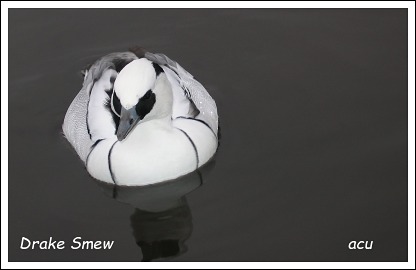 favourite locations on Sunday morning (1/1) ........." We did our 11km walk around Plumley, Holford and Lostock Green this morning, which turned out to be wet and muddy, with a lot of flooding, but bird wise a good start to 2023!!!
favourite locations on Sunday morning (1/1) ........." We did our 11km walk around Plumley, Holford and Lostock Green this morning, which turned out to be wet and muddy, with a lot of flooding, but bird wise a good start to 2023!!!Holford: 136 Curlews (opposite Hame Farm), 1 Kestrel (Holford track).
Plumley: 71 Curlews and 1 Kestrel (Cheadle Lane) and a Little Egret! First time we've seen an egret in this area - it was in a field with horses. ".............
Last Winter we enjoyed a mid-week visit to the Chelford Sand Quarries and were lucky enough to come across a female Smew on the Lapwing Hall Pool. This year there are two females and they've been joined by a male - a striking looking bird that we used to get annually on Tatton Mere. Naturally it's attracted a lot of attention and amongst the visitors was our own Bob Groom! ............"" A better day than forecast and still lovely and mild - Min 8C Max 12C. Went over to Lapwing Lane. Inevitably there was a twitch on and parking was at a premium but I did manage to get the last space. Cracking views of the drake and accompanying female Smew (eventually) that had arrived yesterday and later saw the other female that had already been in residence. I chose the route through the wood and kept on walking round. Lots of Wigeon, Goosanders etc. Also male Goldeneye and hovering Kestrel. I was lucky to catch the m/f close in at a point where there was a gap in the trees. Later saw them again en route to the gate but more distant. Walking back down the road saw the usual Tree Sparrows and Nuthatches. Great White Egret, hundreds of Teal and Lapwings, many Cormorants and yet more Goosanders at Acre Nook. At one point a Sparrowhawk powered across. A very successful visit.................
Late news 6th January 2023 - Phil Dell recently sent me details about a large flock of Pink-footed geese (he estimated about 5,000) that were roosting in fields close to his house in High Legh. I travelled there yesterday (5/1) but they failed to appear. It was a different story today though! Via the Rostherne Mere WhatsApp group he alerted me to the fact that the birds had appeared at 2:30pm. I therefore abandoned this update and made my way to the recommended spot, along Crabtree Lane - close to Lilac Farm. At first I could hear them well enough but they were out of sight in an adjoining field. Eventually though they took to the air and vanished, flying north - a great sight and sound. I managed a few seconds of video and some still pictures - thanks Phil, great stuff!
 |
30th December 2022.......... The 2022 Christmas Walk.
 |
Welcome to the last update of 2022. This year we managed a full program of KOS outdoor field trips and in September, after 2½years, we were able re-start our indoor meetings. Trips and indoor get-togethers, up to April 2023 are listed on this website's trips page.
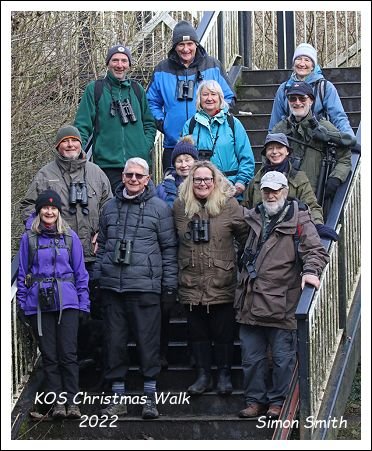 The committee will be meeting shortly to draw up plans for the Period May 2023 through to May 2024 (which will be the 50th anniversary of the KOS!!). I know that Sheila Blamire has already set the wheels in motion for a 4 day holiday to East Anglia in May next year. All members should have been sent details via email.
The committee will be meeting shortly to draw up plans for the Period May 2023 through to May 2024 (which will be the 50th anniversary of the KOS!!). I know that Sheila Blamire has already set the wheels in motion for a 4 day holiday to East Anglia in May next year. All members should have been sent details via email.We were lucky yesterday (29/12) with the weather for our annual Christmas walk around the Neumann's Flash / Budworth Mere area of Marbury Country Park. 13 members arrived at the Witton Mill Bridge car park at the allotted time and, as we were enjoying some of Jude Halman's homemade sloe gin, a flock of about 20 Pink-footed geese were spotted in the distance - a good start.
The trip leader for the day, Sheila Blamire, led us along the old Warrington Road, as the normal route alongside the extensive reed beds was "wellies only" due to heavy overnight rain. A pity, as this is where we would have expected Cetti's Warbler. As it was the species doesn't appear on the day list, hopefully they've survived the extremely cold weather at the beginning of the month.
Elevenses were enjoyed at the park's picnic area where we met up with Bob Groom before moving down to the new viewing screen. Geoff Blamire hurriedly set up his 'scope and everyone was able to take a look at the cobalt blue Kingfisher, perched just below the screen, a few feet above the water of the mere.
It's a regular visitor to that spot explained Stuart Jackson, a local photographer, who spends a lot of time capturing images of the mere's wildlife. He has kindly sent me the image you see on this update; it was taken during the recent cold spell. A fabulous picture - thanks Stuart!
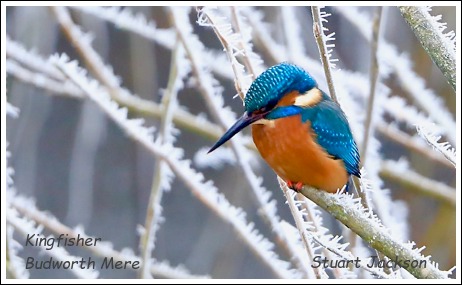 Further out on the mere, Mute Swans, Tufted ducks, displaying Great Crested Grebes and no less than 14 Goosanders. Has there been an influx lately? I hear that Rostherne had nine yesterday.
Further out on the mere, Mute Swans, Tufted ducks, displaying Great Crested Grebes and no less than 14 Goosanders. Has there been an influx lately? I hear that Rostherne had nine yesterday.Over the far side of the mere, telescopes revealed 100s of Coot and a large flock of wintering waders, mainly Curlews and Lapwings, plus more wildfowl - Shoveler, Canada and Greylag Geese, Teal and Goldeneye.
Cutting back up through the woodland and over the canal we arrived at Dairy House Meadow where a Barn Owl, sheltering at the back of it's nest box, was added to the ever growing list. Neumann's Flash was unusually quiet but, from Pod's Hide, we had Shelduck and Wigeon bringing the grand total to 52 species, one more than Christmas last year!
Derek and Jean had intended to join us but there was a mix-up with times, so they ended up at Tatton where they too had excellent views of a Kingfisher ......."I could have been there for 10:00am then realised it was 9:30am never mind I hope you all had a pleasant morning. We went into Tatton for an hour or so.
Superb, prolonged views of a male Kingfisher on the small tree on the side of the overflow stream from Melchett, it then flew towards us and landed twenty feet or so away posing, then across the road to the overflow stream from main mere, landed then flew down stream towards where a branch goes across stream landed again.
Best views for a long time in Tatton "........
Our next field trip is on Saturday 14th January when we'll be visiting RSPB Marshside and WWT Martin mere.
Two weeks later there follows a very busy weekend!
On Friday 27th January it's indoors at the Jubilee Hall when Mike Watson will be telling us about the Northern Territory of Australia.
The following day (Saturday 28th) we're on the Moor with the Friends of the Moor helping with their "RSPB Big Garden Birdwatch"
And, on the Sunday (29 January), on the Heath with the Friends of Knutsford Heath for their Big Garden Birdwatch!
Species recorded on the Christmas walk.- Thursday 29th December 2022 |
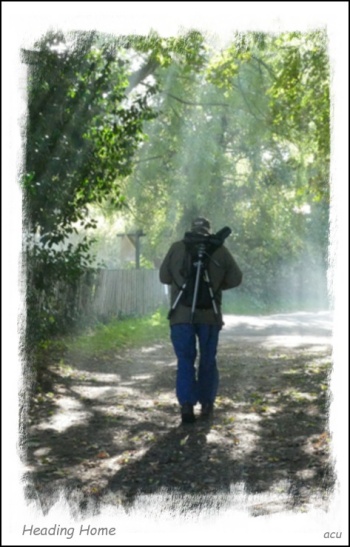 |
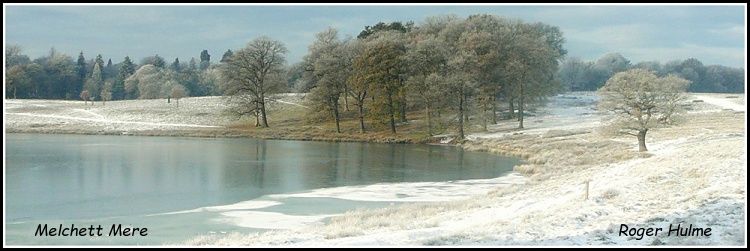 |
The spell of cold weather came to an abrupt end over the weekend; in the early hours of Friday morning (16/12) my weather station
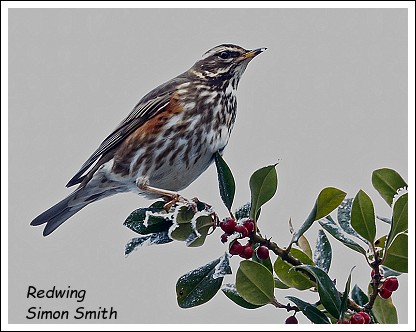 recorded a low of
-7.3⁰C
. The official Met. Office station at Rostherne recorded
-9.5⁰C
but the temperature then began to rise rapidly and reached
+14⁰C
on Monday (19/12) as a plume of warm, humid air pushed up from southern Europe.
recorded a low of
-7.3⁰C
. The official Met. Office station at Rostherne recorded
-9.5⁰C
but the temperature then began to rise rapidly and reached
+14⁰C
on Monday (19/12) as a plume of warm, humid air pushed up from southern Europe.The temperature in the obs. at Rostherne Mere on Monday morning was 8⁰C but it was 12.5⁰C outside and, as a consequence, the windows were dripping with condensation, the log book was damp and the monthly "tick list" sodden! Quite remarkable. Volunteer warden Phil Dell told me he'd never seen anything like it, in all the years he's been visiting the reserve.
It was pretty gloomy, we managed to count a few species loitering near the boathouse but a big flock of finches remained largely unidentified........."47 Wigeon, 25 Pochard, 3 Goldeneye, 32 Lapwings, m&f Goosander, Grey Heron (survived the cold spell). Too gloomy to ID c.120 finches in the mereside alders, I did make out some Goldfinches the rest probably included Siskins and, perhaps, some Redpolls"............
There are some Redpolls about, Geoff and Sheila Blamire came across some during their Friday morning workout .........."We did our 10km walk to Rostherne on Friday 16 Dec - boy it was cold!
Highlights include: Rostherne Brook (seen from Rostherne Lane) flushed 2 Snipe and 8+ Mallards; Rostherne Mere 1m 1f Goosanders; below the Obs 1 Lesser Redpoll feeding amongst the brambles; seen when we left the Obs 8+ Lesser Redpolls feeding in the Silver Birches and 1 Song Thrush; Ciceley Mill Lane, Grey Wagtail feeding along in the leaf litter (same as in 14 Dec).".............
Bob Groom managed to do the monthly WeBS count over the week and was pleased to encounter a Bittern as he progressed around Tabley Mere.
 .........." I decided to do my Tabley count, with the now benign air making it quite pleasant. Nonetheless I found Tabley Mere still 95% frozen so everything was concentrated in one corner. 128 Teal were so nervous that they were constantly flighting ( and burning up fuel, but a lovely sight). Otherwise the rest of the wildfowl seemed happy enough - 75 Mallard, 6 Wigeon, 7 Canada Geese, 5 Tufted Ducks, 2 Cormorants, 2 Coots. A Heron put in an appearance and a Buzzard winged low across the water but the highlight was a Bittern flying across the mere. Great view! Small birds in the wood included Tree Creeper, party of Long-Tailed Tits, Nuthatches, Goldcrest, Wren, Robin... Fortunately the rain largely held off until after I'd left."................
.........." I decided to do my Tabley count, with the now benign air making it quite pleasant. Nonetheless I found Tabley Mere still 95% frozen so everything was concentrated in one corner. 128 Teal were so nervous that they were constantly flighting ( and burning up fuel, but a lovely sight). Otherwise the rest of the wildfowl seemed happy enough - 75 Mallard, 6 Wigeon, 7 Canada Geese, 5 Tufted Ducks, 2 Cormorants, 2 Coots. A Heron put in an appearance and a Buzzard winged low across the water but the highlight was a Bittern flying across the mere. Great view! Small birds in the wood included Tree Creeper, party of Long-Tailed Tits, Nuthatches, Goldcrest, Wren, Robin... Fortunately the rain largely held off until after I'd left."................Birder Bill Morton forsook his beloved Frodsham marshes last Thursday (15/12) and enjoyed a stroll around Tatton Park where he came across the park's first Bramblings of the Winter......."I was out from dawn till dusk birding along the banks of the Mersey and that was chilling to the marrow. I've been to Tatton Park today where it was people free and managed some Bramblings along the beech walk alongside the golf course. "......... Thanks Bill!
Of course the highlight since the last update has been the KOS Christmas party, our first since December 2019! There was good turnout of 21 members and friends, slightly less than three years ago, but I know the current 'flu bug that's doing the rounds meant that some regulars couldn't attend. Nevertheless more than 50% of our current membership were able to enjoy a most successful evening. Our secretary Karina Stanley, ably assisted by Jude Halman, set out the tables during the afternoon and, as you can see from the picture, these were rapidly filled with a delicious selection of temptations as people arrived with offerings of, mainly, home cooked dishes.
Treasurer, Frank Dearden did the appropriate calculations and was able to announce a very useful profit.
Many thanks to everyone for your contributions to last night's party; a lovely and relaxed gathering.
Along with the enjoyment we raised an important sum for the Society's funds, as follows:
Admission £ 152.00
Raffle £ 76.00
Bring&buy £ 59.60
Donations £ 50.00 from absent friends
= £ 337.60
Bought in food items came to £ 55.00 giving a net contribution to KOS funds of £ 282.60
Karina's off for a Christmas get-together with her family in Dubai but left us with a lovely email message before she left.
It was a very special evening enjoyed by all the members and friends. So good to be able to share time after the Covid restrictions of recent times. A great team effort indeed - thank you all so much.
Looking forward to next year's party and hoping even more members will be able to come and join the fun.
Happy Christmas!
Karina.
13th December 2022 .......... The cold spell continues....
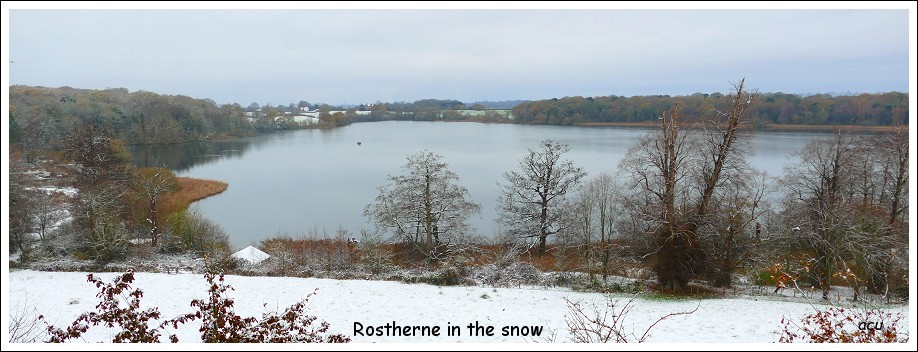 |
The trip up to Leighton Moss on Saturday (10/12) had to be called off at the last minute. At 7am the temperature was well below freezing and it had started to snow, this was to continue for the next five hours and resulted in Manchester Airport being closed to both incoming and outgoing flights.
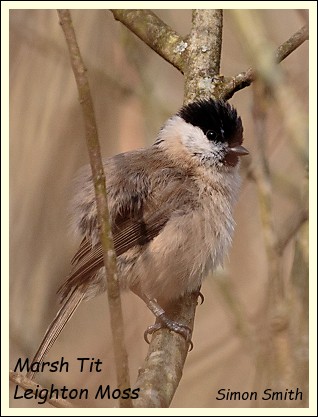 Fortunately only 10 people had signed up for the outing, so a quick series of phone calls and everyone was made aware of the cancellation. Everyone that is except Frank, our Hon. Treasurer, who must have left his hearing aid out and who, despite numerous attempts, couldn't be raised. And so it was that at 07:40 he fired up the trusty Saab and headed north!
Fortunately only 10 people had signed up for the outing, so a quick series of phone calls and everyone was made aware of the cancellation. Everyone that is except Frank, our Hon. Treasurer, who must have left his hearing aid out and who, despite numerous attempts, couldn't be raised. And so it was that at 07:40 he fired up the trusty Saab and headed north!In the event he did quite well and seemed to have thoroughly enjoyed himself!
............"No Bearded Tits in view from the walkway when I was there. Otter I saw from the Causeway Hide on the fringes of the one area of standing open water on the reserve.
Yellow-browed Warbler was on the reserve day list, having been seen by staff at first light by the track leading to Lower Hide. I headed there as soon as I entered the reserve to find three likely looking birders staking out a clearing. So I joined them and gave it thirty minutes before moving on to the Lower Hide itself, which was the only viewpoint on the reserve with decent views of wildfowl. Caught up with the Yb birders later and, in response to my questioning eyebrow, they shook their heads and said "no".
Despite this, the Lower Hide and track to it were clearly the most productive part of the reserve in those conditions. I spent the whole morning in the vicinity. A small mixed tit flock there included two Marsh Tits. But Birds of the Day for me, on account of their confiding nature and prolonged views, were two Treecreepers navigating a large Silver Birch.
After a winter warmer lunch in the cafe, I headed for the Jackson and Grisedale Hides. Both were empty of birders and similarly of birds apart from two Pied Wagtails skating on the ice which covered both stretches of water. Passerine sighting was better from the approach tracks though parts of these were treacherous and I could move only slowly. One other couple I saw on the footpath gave up halfway.
So difficult conditions but the cold atmosphere and frosted surroundings made it a delight to be there. In hindsight I'm glad I didn't hear that phone call from Tony. "................ Thanks Frank; I'm glad we're still on speaking terms!
I went over to Rostherne later in the day, it was looking very picturesque (see image above)......"I waited for the snow to stop and had an early lunch before going over to Rostherne arriving at 12:15pm. The temperature was 2.7C and it had dropped to 2.4C an hour later when I left. The thermometer
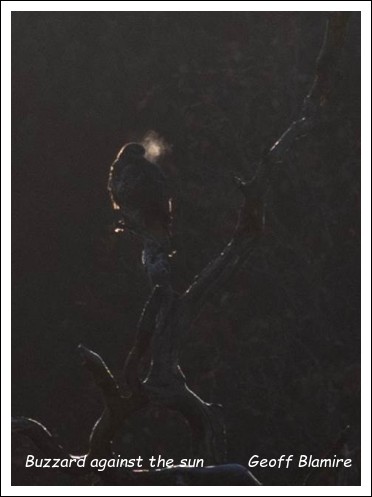 in the obs. showed a minimum recorded temperature of -5.6C; I assume this was overnight on Thursday/ Friday of this week. I didn't re-set it.
in the obs. showed a minimum recorded temperature of -5.6C; I assume this was overnight on Thursday/ Friday of this week. I didn't re-set it.Predictably the bird table was very busy, a Cetti's Warbler sang from near the boathouse and a Little Egret flew low over the mere heading towards the Bittern hide."........
Earlier in the week (Weds. 7 December) Geoff and Sheila Blamire included the reserve in their daily walk ..............""We decided to go to the Rostherne Obs via Cheery Tree lane - 12km in all. Quiet birdwise along Cherry Tree Lane until a Buzzard flew up from one of the fields and perched in a dead tree by the wood with the sun behind it forming a highlight around the bird - beautiful. Every time it called you could see its breath in the freezing temps. When it finished its meal (vole?) it flew to another dead tree to use a lookout perch. Continued along Marsh Lane, across the two fields then passed in front of Wood Bongs and saw another Buzzard in a dead tree by the mere. When we arrived in the Obs the outside temp was 0⁰C , the inside temp was 2.5⁰C ! No other birders had braved the cold. The "usual" Mallards, Wigeons, Tufted Ducks, Pochards, Goldeneyes (2f 1m) etc , but good to see a female Goosander fly in. Continued to Ciceley Mill Pool and 3 Buzzards flying low together - all the time calling. The pool was almost frozen over. The same with Little Mere.
The last time I saw a Woodcock was earlier this year when we disturbed one from Wood Bongs and it flew the length of the field beside Marsh Lane and disappeared over Marsh Lane farm - just as we were walking along the field! ...........
Bob Groom also went to Rostherne the following day but took in Tatton Park on the way ........."According to the Met Office it was -5C at midnight and -6C through the early hours. Definitely the coldest night that we've had for a very long time. The maximum for the day was forecast to be zero C so again the coldest day in yonks. In the event it crawled up to +2C but still brutally cold. I went into Tatton. To my surprise Melchett Mere was mostly unfrozen , which was good as the 'pool' at the head of Tatton Mere was hard frozen (so no gwe). Cormorant and Heron shared the half-dead tree and there were 3 more Cormorants. 3 Wigeon, 3 Egyptian Geese, a few Pochard and Gadwall. There was a brief duck panic, which spread to a big tit flock in the trees but it wasn't a raptor. Another Heron had taken off from a treetop..
Two small birds beyond the mere were probably the Stonechats but hard to tell with the vegetation covered in hoarfrost. A few people were photographing the winter wonderland but the park was pretty quiet considering. I carried on to Rostherne and met Phil Dell in the observatory. I got him on a departing Little Egret but he missed a Woodcock flying past, my second in two days! He's e-mailed me this evening to confirm. It was apparently disturbed by Rupert and Bill doing survey work in Doll's Meadow. (A lot of Teal also came out.) There were 5 Goldeneyes with the drakes head shaking! Also 2 Egyptian Geese, 2 Herons, GSW, LTTS....".........
I'm sure it's not needed but a final reminder that this coming Friday (16th December) it's our annual KOS Christmas Party. The food will be as good as ever, despite the "Great Mobberley Disaster of December 2022" when a lorry backed into Goostrey's Bakery - demolishing a wall, dislodging three ovens and severing the gas supply! I believe Karina has sourced another supply of meat pies but, of course, this of little comfort to the villagers of Mobberley who are having to somehow survive this freezing winter weather without Goostrey's sausage rolls!
On the 29th December it's our annual Christmas walk and, as usual, we'll be taking in Budworth Mere and the Neumann's Flash area. 9:30am at the Witton Bridge car park.